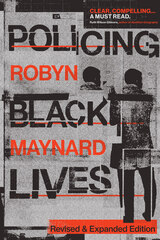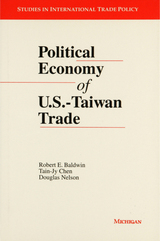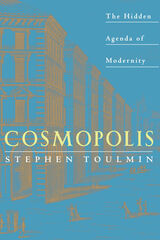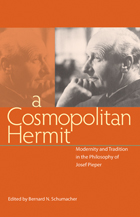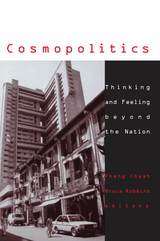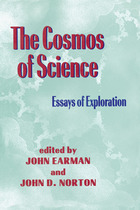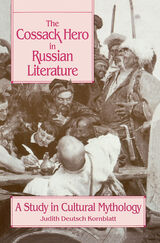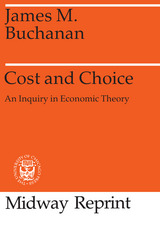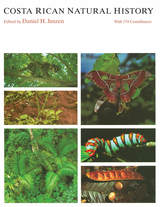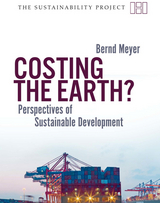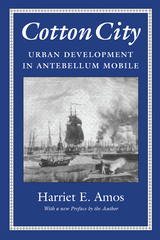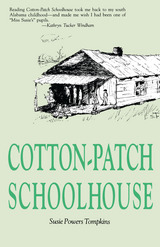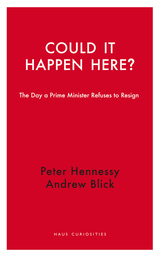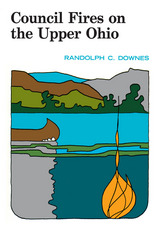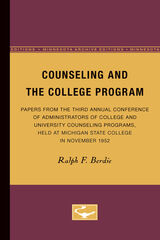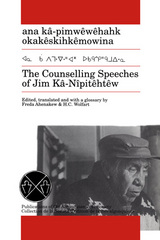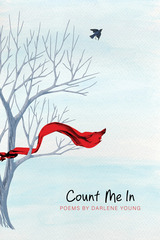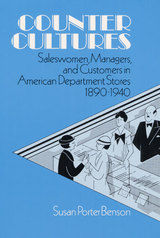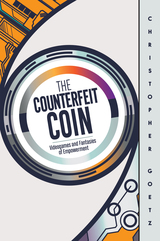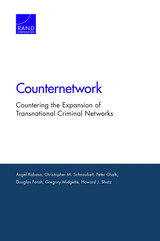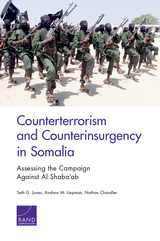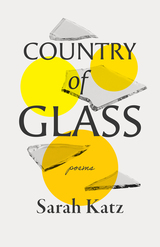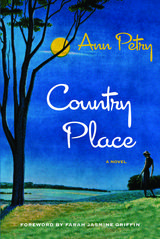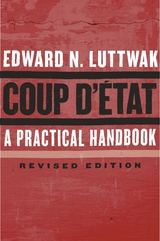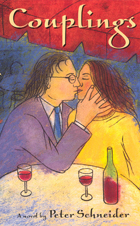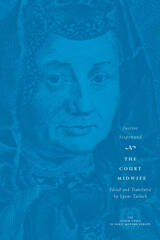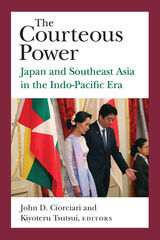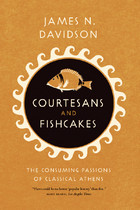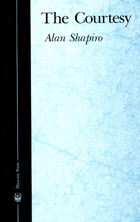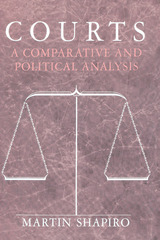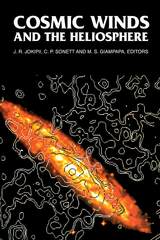 Cosmic Winds and the Heliosphere
Edited by J. R. Jokipii, C. P. Sonett, and M. S. Giampapa
University of Arizona Press, 1997 Until the advent of space physics, astrophysical plasmas could be studied only using ground-based observations. Although observational methods have advanced over recent decades, the merging of heliospheric physics with astrophysics is far from complete due to the vastly different techniques employed by astronomers and space physicists. That astrophysical plasmas can be studies directly is a major advance in astrophysical research. The solar wind from the Sun is only one of many examples of solar winds, but it provides scientists with a basis for understanding how these formerly disparate disciplines are related.
Cosmic Winds and the Heliosphere is a comprehensive sourcebook on conceptually correlated topics in astrophysical winds and heliospheric physics. The contributors review the various kinds of winds, such as solar wind, winds of cataclysmic variables, and winds from pulsating stars. They then examine the physics of wind origin and physical phenomena in winds. including heliospheric shocks, magnetohydrodynamic turbulence, and kinetic phenomena. A final section considers interactions with surrounding media, with contributions ranging from studies of the interstellar cloud surrounding the solar system to considerations of solar wind interaction with comets.
Prepared to the scrupulous standards of the University of Arizona Space Science Series, Cosmic Winds and the Heliosphere is an essential volume for astronomers and space physicists.
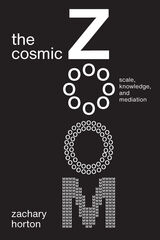 The Cosmic Zoom: Scale, Knowledge, and Mediation
Zachary Horton
University of Chicago Press, 2021 In The Powers of Ten by Charles and Ray Eames, a view of two people enjoying a picnic zooms up and away to show their surroundings, moving progressively farther into space, then zooms back in for a close-up of the hand of the picnicker, travelling deep into the microscopic realm. This is one of the most iconic examples of the “cosmic zoom,” a trope that has influenced countless media forms over the past seventy years.
Horton uses the cosmic zoom as a starting point to develop a cross-disciplinary theory of scale as mediated difference. He considers the origins of our notions of scale, how scalar mediation functions differently in analog and digital modes, and how cosmic zoom media has influenced scientific and popular views of the world. Analyzing literature, film, digital media, and database history, Horton establishes a much-needed framework for thinking about scale across multiple domains and disciplines.
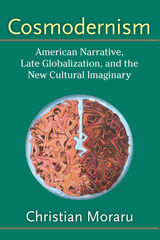 Cosmodernism: American Narrative, Late Globalization, and the New Cultural Imaginary
Christian Moraru
University of Michigan Press, 2010 "Christian Moraru is an especially dynamic and brilliant scholar who works at a high level of critical and theoretical sophistication. I've never seen anything quite so exhaustive, so magisterial. Readers of Cosmodernism will think of the Keats line about an astronomer's exhilaration when a new planet swims into his ken."
---David Cowart, University of South Carolina "Cosmodernism has the potential to become foundational for the study of a whole period. Christian Moraru undertakes here to establish a new basis for thinking about the era of cultural history in which we have found ourselves, in the United States but also around the world, since the end of the Cold War. The strength of Moraru's work lies in its intellectual ambition and scope; its polymathic range and breadth of learning; its confident mastery of a variety of disciplinary discourses; its fresh and thoughtful selection of texts for discussion; the sharpness and insight of its textual analyses; and, animating everything, its fervent commitment to a new and better way of understanding our relationship to others and the world at large."
---Brian McHale, The Ohio State University A sweeping inquiry into post–Cold War American literature and theory, Cosmodernism argues, cautiously but persuasively, for the rise of a new cultural paradigm against the backdrop of accelerating globalization. Moraru calls this paradigm "cosmodern." He uses the term to account for what seems to be gradually challenging the postmodern over the last twenty-odd years. Not so much a well-structured movement yet, cosmodernism is chiefly a critical construct enabling Moraru to articulate representative literary-theoretical interventions of the past two decades into a reasonably coherent model. The coherence inheres, he shows, in a certain "relational" imaginary, which the critic canvasses by placing a wide range of authors and works in, across, and against the material-conceptual networks of globalization, cosmopolitanism, modernism, postmodernism, postcolonialism, multiculturalism, and other areas of contemporary U.S. intellectual history. Christian Moraru is Professor of English at the University of North Carolina, Greensboro. His latest books include Rewriting: Postmodern Narrative and Cultural Critique in the Age of Cloning (2001), Memorious Discourse: Reprise and Representation in Postmodernism (2005), and the edited collection Postcommunism, Postmodernism, and the Global Imagination (2009). Cover art: Earth, oil and acrylic on canvas, 48" × 36", 2008. Painting courtesy of Rebecca Darlington.
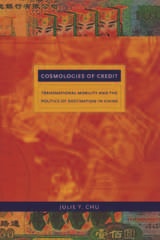 Cosmologies of Credit: Transnational Mobility and the Politics of Destination in China
Julie Y. Chu
Duke University Press, 2010 Year after year a woman sits in her bare living quarters with her bags packed. She is waiting for a phone call from her snakehead, or human smuggler. That longed-for call will send her out her door, away from Fuzhou, China, on a perilous, illicit journey to the United States. Nothing diffuses the promise of an overseas destiny: neither the ever-increasing smuggling fee for successful travel nor her knowledge of the deadly risks in transit and the exploitative labor conditions abroad. The sense of imminent departure enchants her every move and overshadows the banalities of her present life. In this engrossing ethnographic account of how the Fuzhounese translate their desires for mobility into projects worth pursuing, Julie Y. Chu focuses on Fuzhounese efforts to recast their social horizons beyond the limitations of “peasant life” in China. Transcending utilitarian questions of risks and rewards, she considers the overflow of aspirations in the Fuzhounese pursuit of transnational destinations. Chu attends not just to the migration of bodies, but also to flows of shipping containers, planes, luggage, immigration papers, money, food, prayers, and gods. By analyzing the intersections and disjunctures of these various flows, she explains how mobility operates as a sign embodied through everyday encounters and in the transactions of persons and things.
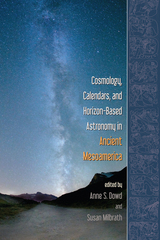 Cosmology, Calendars, and Horizon-Based Astronomy in Ancient Mesoamerica
Anne S. Dowd
University Press of Colorado, 2020 Cosmology, Calendars, and Horizon-Based Astronomy in Ancient Mesoamerica is an interdisciplinary tour de force that establishes the critical role astronomy played in the religious and civic lives of the ancient peoples of Mesoamerica. Providing extraordinary examples of how Precolumbian peoples merged ideas about the cosmos with those concerning calendar and astronomy, the volume showcases the value of detailed examinations of astronomical data for understanding ancient cultures.
The volume is divided into three sections: investigations into Mesoamerican horizon-based astronomy, the cosmological principles expressed in Mesoamerican religious imagery and rituals related to astronomy, and the aspects of Mesoamerican calendars related to archaeoastronomy. It also provides cutting-edge research on diverse topics such as records of calendar and horizon-based astronomical observation (like the Dresden and Borgia codices), iconography of burial assemblages, architectural alignment studies, urban planning, and counting or measuring devices.
Contributors—who are among the most respected in their fields— explore new dimensions in Mesoamerican timekeeping and skywatching in the Olmec, Maya, Teotihuacano, Zapotec, and Aztec cultures. It will be of great interest to students and scholars of anthropology, archaeology, art history, and astronomy.
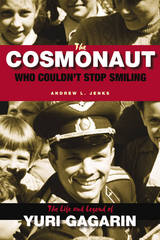 The Cosmonaut Who Couldn't Stop Smiling: The Life and Legend of Yuri Gagarin
Andrew L. Jenks
Northern Illinois University Press, 2013
“Let’s go!” With that, the boyish, grinning Yuri Gagarin launched into space on April 12, 1961, becoming the first human being to exit Earth’s orbit. The twenty-seven-year-old lieutenant colonel departed for the stars from within the shadowy world of the Soviet military-industrial complex. Barbed wires, no-entry placards, armed guards, false identities, mendacious maps, and a myriad of secret signs had hidden Gagarin from prying outsiders—not even his friends or family knew what he had been up to. Coming less than four years after the Russians launched Sputnik into orbit, Gagarin’s voyage was cause for another round of capitalist shock and Soviet rejoicing.
The Cosmonaut Who Couldn’t Stop Smiling relates this twentieth-century icon’s remarkable life while exploring the fascinating world of Soviet culture. Gagarin’s flight brought him massive international fame—in the early 1960s, he was possibly the most photographed person in the world, flashing his trademark smile while rubbing elbows with the varied likes of Nehru, Castro, Queen Elizabeth II, and Italian sex symbol Gina Lollobrigida. Outside of the spotlight, Andrew L. Jenks reveals, his tragic and mysterious death in a jet crash became fodder for morality tales and conspiracy theories in his home country, and, long after his demise, his life continues to provide grist for the Russian popular-culture mill.
This is the story of a legend, both the official one and the one of myth, which reflected the fantasies, perversions, hopes and dreams of Gagarin’s fellow Russians. With this rich, lively chronicle of Gagarin’s life and times, Jenks recreates the elaborately secretive world of space-age Russia while providing insights into Soviet history that will captivate a range of readers.
Cosmopolis: The Hidden Agenda of Modernity
Stephen Toulmin
University of Chicago Press, 1992 A daring account of the philosophical development of the idea of a rational society and its consequences for the present
In the seventeenth century, a vision arose which was to captivate the Western imagination for the next three hundred years: the vision of Cosmopolis, a society as rationally ordered as the Newtonian view of nature. While fueling extraordinary advances in all fields of human endeavor, this vision perpetuated a hidden yet persistent agenda: the delusion that human nature and society could be fitted into precise and manageable rational categories. Stephen Toulmin confronts that agenda—its illusions and its consequences for our present and future world.
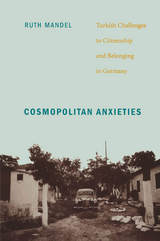 Cosmopolitan Anxieties: Turkish Challenges to Citizenship and Belonging in Germany
Ruth Mandel
Duke University Press, 2008 In Cosmopolitan Anxieties, Ruth Mandel explores Germany’s relation to the more than two million Turkish immigrants and their descendants living within its borders. Based on her two decades of ethnographic research in Berlin, she argues that Germany’s reactions to the postwar Turkish diaspora have been charged, inconsistent, and resonant of past problematic encounters with a Jewish “other.” Mandel examines the tensions in Germany between race-based ideologies of blood and belonging on the one hand and ambitions of multicultural tolerance and cosmopolitanism on the other. She does so by juxtaposing the experiences of Turkish immigrants, Jews, and “ethnic Germans” in relation to issues including Islam, Germany’s Nazi past, and its radically altered position as a unified country in the post–Cold War era. Mandel explains that within Germany the popular understanding of what it means to be German is often conflated with citizenship, so that a German citizen of Turkish background can never be a “real German.” This conflation of blood and citizenship was dramatically illustrated when, during the 1990s, nearly two million “ethnic Germans” from Eastern Europe and the former Soviet Union arrived in Germany with a legal and social status far superior to that of “Turks” who had lived in the country for decades. Mandel analyzes how representations of Turkish difference are appropriated or rejected by Turks living in Germany; how subsequent generations of Turkish immigrants are exploring new configurations of identity and citizenship through literature, film, hip-hop, and fashion; and how migrants returning to Turkey find themselves fundamentally changed by their experiences in Germany. She maintains that until difference is accepted as unproblematic, there will continue to be serious tension regarding resident foreigners, despite recurrent attempts to realize a more inclusive and “demotic” cosmopolitan vision of Germany.
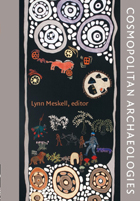 Cosmopolitan Archaeologies
Lynn Meskell, ed.
Duke University Press, 2009 An important collection, Cosmopolitan Archaeologies delves into the politics of contemporary archaeology in an increasingly complex international environment. The contributors explore the implications of applying the cosmopolitan ideals of obligation to others and respect for cultural difference to archaeological practice, showing that those ethics increasingly demand the rethinking of research agendas. While cosmopolitan archaeologies must be practiced in contextually specific ways, what unites and defines them is archaeologists’ acceptance of responsibility for the repercussions of their projects, as well as their undertaking of heritage practices attentive to the concerns of the living communities with whom they work. These concerns may require archaeologists to address the impact of war, the political and economic depredations of past regimes, the livelihoods of those living near archaeological sites, or the incursions of transnational companies and institutions. The contributors describe various forms of cosmopolitan engagement involving sites that span the globe. They take up the links between conservation, natural heritage and ecology movements, and the ways that local heritage politics are constructed through international discourses and regulations. They are attentive to how communities near heritage sites are affected by archaeological fieldwork and findings, and to the complex interactions that local communities and national bodies have with international sponsors and universities, conservation agencies, development organizations, and NGOs. Whether discussing the toll of efforts to preserve biodiversity on South Africans living near Kruger National Park, the ways that UNESCO’s global heritage project universalizes the ethic of preservation, or the Open Declaration on Cultural Heritage at Risk that the Archaeological Institute of America sent to the U.S. government before the Iraq invasion, the contributors provide nuanced assessments of the ethical implications of the discursive production, consumption, and governing of other people’s pasts. Contributors. O. Hugo Benavides, Lisa Breglia, Denis Byrne, Chip Colwell-Chanthaphonh, Alfredo González-Ruibal, Ian Hodder, Ian Lilley, Jane Lydon, Lynn Meskell, Sandra Arnold Scham
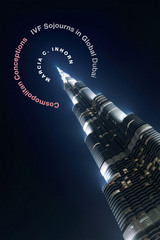 Cosmopolitan Conceptions: IVF Sojourns in Global Dubai
Marcia C. Inhorn
Duke University Press, 2015 In their desperate quest for conception, thousands of infertile couples from around the world travel to the global in vitro fertilization (IVF) hub of Dubai. In Cosmopolitan Conceptions Marcia C. Inhorn highlights the stories of 220 "reprotravelers" from fifty countries who sought treatment at a “cosmopolitan” IVF clinic in Dubai. These couples cannot find safe, affordable, legal, and effective IVF services in their home countries, and their stories offer a window into the world of infertility—a world that is replete with pain, fear, danger, frustration, and financial burden. These hardships dispel any notion that traveling for IVF treatment is reproductive tourism. The magnitude of reprotravel to Dubai, Inhorn contends, reflects the failure of countries to meet their citizens' reproductive needs, which suggests the necessity of creating new forms of activism that advocate for developing alternate pathways to parenthood, reducing preventable forms of infertility, supporting the infertile, and making safe and low-cost IVF available worldwide.
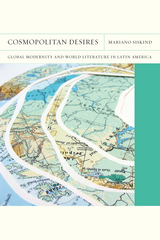 Cosmopolitan Desires: Global Modernity and World Literature in Latin America
Mariano Siskind
Northwestern University Press, 2014 Mariano Siskind’s groundbreaking debut book redefines the scope of world literature, particularly regarding the place of Latin America in its imaginaries and mappings. In Siskind’s formulation, world literature is a modernizing discursive strategy, a way in which cultures negotiate their aspirations to participate in global networks of cultural exchange, and an original tool to reorganize literary history. Working with novels, poems, essays, travel narratives, and historical documents, Siskind reads the way Latin American literary modernity was produced as a global relation, from the rise of planetary novels in the 1870s and the cosmopolitan imaginaries of modernism at the turn of the twentieth century, to the global spread of magical realism. With its unusual breadth of reference and firm but unobtrusive grounding in philosophy, literary theory, and psychoanalysis, Cosmopolitan Desires will have a major impact in the fields of Latin American studies and comparative literature.
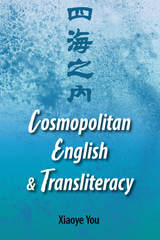 Cosmopolitan English and Transliteracy
Xiaoye You
Southern Illinois University Press, 2016 Winner, CCCC Research Impact Award, 2018
Despite the vast number of multilingual speakers in the United States and the pervasive influence of globalization, writing studies in this country is still inextricably linked to a nationalistic, monolingual English ideology. In Cosmopolitan English and Transliteracy, Xiaoye You addresses this issue by proposing that writing studies programs adopt a cosmopolitan perspective. Emphasizing local and global forms of citizenship and identification, You merges a humanistic vision with the rigor of social science, arguing that linguistic and cultural differences can be explored to recover human connections normally severed by geographical and semiotic borders.
You examines several areas of writing affected by globalization. He then turns to the composition classroom, highlighting the challenges and possibilities of crossing cultural boundaries in academic discourse before introducing a pedagogy aimed at fostering American students’ translingual and transcultural sensibilities. Included is a model for training writing teachers in the context of globalization, which aims to help instructors gain practical knowledge about the needs and resources of multilingual writers through communication technologies and cross-cultural partnerships.
By introducing cosmopolitan perspectives into the composition classroom, You challenges traditional assumptions about language, identity, and literacy as they relate to writing studies. Innovative and provocative, Cosmopolitan English and Transliteracy charts a new way forward for writing programs, with a call to focus on global rather than national identity.
A cosmopolitan hermit: modernity and tradition in the philosophy of Josef Pieper
Bernard N Schumacher
Catholic University of America Press, 2009 Composed of ten original essays written with the goal of exploring the thought of one of the most significant German philosophers of the 20th century, namely, Josef Pieper (1904-1997), this book is the only systematic treatment of his expansive philosophy to date.
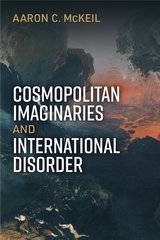 Cosmopolitan Imaginaries and International Disorder
Aaron C. McKeil
University of Michigan Press, 2025 While the idea of a cosmopolitan order embracing all humankind is ancient, after the Cold War it was widely believed to be an emerging future. As global interdependence and interaction through new technologies increased, literature of cosmopolitan globalization argued that these changes were setting the stage for a structural transformation of world politics. Yet, a revolt against globalism and increasingly divisive and unstable international order has dramatically contradicted this idea. This presents a puzzle for International Relations theory: Why have attempts to construct cosmopolitan order struggled to emerge in the modern global world?
Cosmopolitan Imaginaries and International Disorder argues that advocacy for cosmopolitan order reform in the modern world has struggled to recognize the political identities of states and populations and to legitimize its proposed political hierarchies. As a result, these efforts have been overwhelmed by states shoring up their power and remobilizing exclusionary nationalist identities, especially when struggles are intensified in contexts of international instability and economic turmoil. In developing a theory to explain these patterns of cosmopolitan politics, this book offers insight into the limits and role of cosmopolitanism in a dividing international order after liberal globalism.
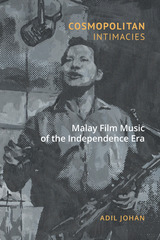 Cosmopolitan Intimacies: Malay Film Music of the Independence Era
Adil Johan
National University of Singapore Press, 2018 The 1950s and ’60s are now thought to be the Golden Age of Malay film. A big part of what made films of this era so popular was their beguiling music. In this absorbing study, the scholar and musician Adil Johan examines the social and cultural impact of the film music of the period, and its role in nation-making.
Drawing on analyses of lyrics and music, interviews with musicians, and the content of Malay entertainment magazines, in an approach that spans ethnomusicology and cultural studies, he reveals this body of work to be a product of a musical and cultural cosmopolitanism in the service of a nation-making process based on ideas of Malay ethnonationalism, initially fluid but increasingly homogenized over time. Malay film music of the period covertly expressed radical sentiments despite being produced within a commercialized film industry.
Written in a lively style and illustrated with musical examples, the book will satisfy ethnomusicologists, composers, and film studies scholars interested in Southeast Asia and the Malay world. It will equally be of interest to scholars interested in the role of culture in nation-making more broadly.
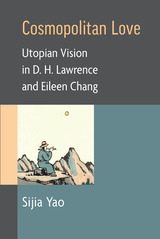 Cosmopolitan Love: Utopian Vision in D. H. Lawrence and Eileen Chang
Sijia Yao
University of Michigan Press, 2023 Love, and the different manifestations of it, is a common theme in literature around the world. In Cosmopolitan Love, Sijia Yao examines the writings of D. H. Lawrence, a British writer whose literature focused primarily on interpersonal relationships in domestic settings, and Eileen Chang, a Chinese writer who migrated to the United States and explored Chinese heterosexual love in her writing. While comparing the writings of a Chinese writer and an English one, Yao avoids a direct comparison between East and West that could further enforce binaries. Instead, she uses the comparison to develop an idea of cosmopolitanism that shows how the writers are in conversation with their own culture and with each other. Both D. H. Lawrence and Eileen Chang wrote stories that are influenced by—but sometimes stand in opposition to—their own cultures. They offer alternative understandings of societies dealing with modernism and cultural globalization. Their stories deal with emotional pain caused by the restrictions of local politics and economics and address common themes of incestuous love, sexual love, adulterous love, and utopian love. By analyzing their writing, Yao demonstrates that the concept of love as a social and political force can cross cultural boundaries and traditions to become a basis for human meaning, the key to a cosmopolitan vision.
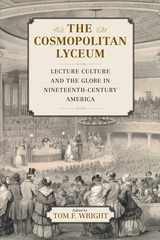 The Cosmopolitan Lyceum: Lecture Culture and the Globe in Nineteenth-Century America
Tom F. Wright
University of Massachusetts Press, 2013 From the 1830s to the 1900s, a circuit of lecture halls known as the "lyceum movement" flourished across the United States. At its peak, up to a million people a week regularly attended talks in local venues, captivated by the words of visiting orators who spoke on an extensive range of topics. The movement was a major intellectual and cultural force of this nation-building period, forming the creative environment of writers and public figures such as Frederic Douglass, Ralph Waldo Emerson, Anna Dickinson, and Mark Twain.
The phenomenon of the lyceum has commonly been characterized as inward looking and nationalistic. Yet as this collection of essays reveals, nineteenth-century audiences were fascinated by information from around the globe, and lecturers frequently spoke to their fellow Americans of their connection to the world beyond the nation and helped them understand "exotic" ways of life. Never simple in its engagement with cosmopolitan ideas, the lyceum provided a powerful public encounter with international currents and crosscurrents, foreshadowing the problems and paradoxes that continue to resonate in our globalized world.
This book offers a major reassessment of this important cultural phenomenon, bringing together diverse scholars from history, rhetoric, and literary studies. The twelve essays use a range of approaches, cover a wide chronological timespan, and discuss a variety of performers both famous and obscure. In addition to the volume editor, contributors include Robert Arbour, Thomas Augst, Susan Branson, Virginia Garnett, Peter Gibian, Sara Lampert, Angela Ray, Evan Roberts, Paul Stob, Mary Zboray, and Ronald Zboray.
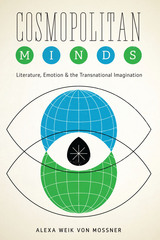 Cosmopolitan Minds: Literature, Emotion, and the Transnational Imagination
By Alexa Weik von Mossner
University of Texas Press, 2014 During World War II and the early Cold War period, factors such as race, gender, sexual orientation, or class made a number of American writers feel marginalized in U.S. society. Cosmopolitan Minds focuses on a core of transnational writers—Kay Boyle, Pearl S. Buck, William Gardner Smith, Richard Wright, and Paul Bowles—who found themselves prompted to seek experiences outside of their home country, experiences that profoundly changed their self-understanding and creative imagination as they encountered alternative points of views and cultural practices in Europe, Asia, and Africa. Alexa Weik von Mossner offers a new perspective on the affective underpinnings of critical and reflexive cosmopolitanism by drawing on theories of emotion and literary imagination from cognitive psychology, philosophy, and cognitive literary studies. She analyzes how physical dislocation, and the sometimes violent shifts in understanding that result from our affective encounters with others, led Boyle, Buck, Smith, Wright, and Bowles to develop new, cosmopolitan solidarities across national, ethnic, and religious boundaries. She also shows how, in their literary texts, these writers employed strategic empathy to provoke strong emotions such as love, sympathy, compassion, fear, anger, guilt, shame, and disgust in their readers in order to challenge their parochial worldviews and practices. Reading these texts as emotionally powerful indictments of institutionalized racism and national violence inside and outside of the United States, Weik von Mossner demonstrates that our emotional engagements with others—real and imagined—are crucially important for the development of transnational and cosmopolitan imaginations.
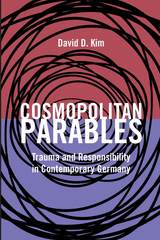 Cosmopolitan Parables: Trauma and Responsibility in Contemporary Germany
David D. Kim
Northwestern University Press, 2017 Cosmopolitan Parables explores the global rise of the heavily debated concept of cosmopolitanism from a unique German literary perspective. Since the early 1990s, the notion of cosmopolitanism has acquired a new salience because of an alarming rise in nationalism, xenophobia, migration, international war, and genocide. This upsurge has transformed how artists and scholars worldwide assess the power of international civil society and its moral obligation to unite regardless of cultural background, religious affiliation, or national citizenship. It rejuvenates an ancient yet timely framework within which contemporary political crises are to be overcome, especially after the collapse of communist states and the intersection of postwar and postcolonial trajectories.
To exemplify this global challenge, Kim examines three internationally acclaimed writers of German origin—Hans Christoph Buch, Michael Krüger, and W. G. Sebald—joined by their own harrowing experiences and stunning entanglements with Holocaust memory, postcolonial responsibility, and communist legacy. This bold new study is the first of its kind, interrogating transnational memories of trauma alongside globally shared responsibilities for justice. More important, it addresses the question of remembrance—whether the colonial past or the postwar legacy serves as a proper foundation upon which cosmopolitanism is to be pursued in today's era of globalization.
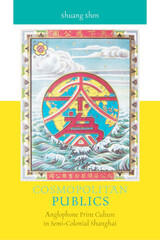 Cosmopolitan Publics: Anglophone Print Culture in Semi-Colonial Shanghai
Shen, Shuang
Rutgers University Press, 2009 Early twentieth-century China paired the local community to the world--a place and time when English dominated urban-centered higher and secondary education and Chinese-edited English-language magazines surfaced as a new form of translingual practice.
Cosmopolitan Publics focuses on China's "cosmopolitans," Western-educated intellectuals who returned to Shanghai in the late 1920s to publish in English and who, ultimately, became both cultural translators and citizens of the wider world. Shuang Shen highlights their work in publications such as The China Critic and T'ien Hsia, providing readers with a broader understanding of the role and function of cultural mixing, translation, and multilingualism in China's cultural modernity.
Decades later, as nationalist biases and political restrictions emerged within China, the influence of the cosmopolitans was neglected and the significance of cosmopolitan practice was underplayed. Shen's encompassing study revisits and presents the experience of Chinese modernity as far more heterogeneous, emergent, and transnational than it has been characterized until now.
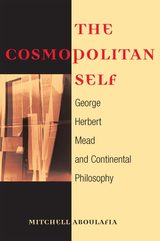 The Cosmopolitan Self: George Herbert Mead and Continental Philosophy
Mitchell Aboulafia
University of Illinois Press, 2001 In this incisive commentary, Mitchell Aboulafia examines the relevance of the American pragmatist philosopher George Herbert Mead to current debates on pluralism, universalism, and the fostering of a democratic temper. Addressing the relationship between Mead's notions of self and society and those of important continental thinkers, The Cosmopolitan Self demonstrates that Mead's ideas not only speak to resolving the tension between universalism and pluralism, they do so in a manner that challenges and advances the positions of these continental theoreticians. Aboulafia examines how Mead's insights illuminate Hannah Arendt's reading of Immanual Kant's third Critique and Jürgen Habermas's understanding of the relationship among communicative action, universality, and individuation. Teasing out strands of agreement and disagreement among Mead and these theorists on topics such as impartiality and good judgment, Aboulafia develops a conception of universalism that is compatible with contemporary notions of pluralism. He also addresses the serious challenge presented to Mead's approach to pluralism by Emmanuel Levinas, who holds that true pluralism, presupposing an irreducible individualism, is fundamentally irreconcilable with universalism. The Cosmopolitan Self offers a model of the democratically inclined individual who embodies both a capacity to establish common ground with others and a sensitivity to their uniqueness. This important volume appreciably advances the dialogue between continental thought and classical American philosophy.
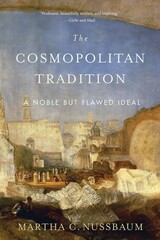 The Cosmopolitan Tradition: A Noble but Flawed Ideal
Martha C. Nussbaum
Harvard University Press, 2019 “Profound, beautifully written, and inspiring. It proves that Nussbaum deserves her reputation as one of the greatest modern philosophers.”
—Globe and Mail
“At a time of growing national chauvinism, Martha Nussbaum’s excellent restatement of the cosmopolitan tradition is a welcome and much-needed contribution…Illuminating and thought-provoking.”
—Times Higher Education
The cosmopolitan political tradition in Western thought begins with the Greek Cynic Diogenes, who, when asked where he came from, said he was a citizen of the world. Rather than declare his lineage, social class, or gender, he defined himself as a human being, implicitly asserting the equal worth of all human beings.
Martha Nussbaum pursues this “noble but flawed” vision and confronts its inherent tensions. The insight that politics ought to treat human beings both as equal and as having a worth beyond price is responsible for much that is fine in the modern Western political imagination. Yet given the global prevalence of material want, the conflicting beliefs of a pluralistic society, and the challenge of mass migration and asylum seekers, what political principles should we endorse? The Cosmopolitan Tradition urges us to focus on the humanity we share rather than on what divides us.
“Lucid and accessible…In an age of resurgent nationalism, a study of the idea and ideals of cosmopolitanism is remarkably timely.”
—Ryan Patrick Hanley, Journal of the History of Philosophy
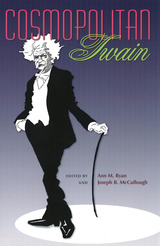 Cosmopolitan Twain
Edited by Ann M. Ryan and Joseph B. McCullough
University of Missouri Press, 2008 Cosmopolitan Twain takes seriously Mark Twain’s life as a citizen of urban landscapes: from the streets of New York City to the palaces of Vienna to the suburban utopia of Hartford. Traditional readings of Mark Twain orient his life and work by distinctly rural markers such as the Mississippi River, the Wild West, and small-town America; yet, as this collection shows, Twain’s sensibilities were equally formed in the urban centers of the world. These essays represent Twain both as a product of urban frontiers and as a prophet of American modernity, situating him squarely within the context of an evolving international and cosmopolitan community. As Twain traveled and lived in these locales, he acquired languages, costumes, poses, and politics that made him one of the first truly cosmopolitan world citizens. Beginning with New York City—where Twain spent more of his life than in Hannibal—we learn that his early experiences there fed his fascination with racial identity and economic privilege. While in St. Louis and New Orleans, Twain developed a strategic detachment that became a part of his cosmopolitan persona. His contact with bohemian writers in San Francisco excited his ambitions to become more than a humorist, while sojourns in Buffalo and Hartford marked Twain’s uneasy accommodation to domesticity and cultural prominence. London finally liberated him from his narrowly constructed national identity, while Vienna allowed him to fully achieve his transnational voice. The volume ends by presenting Elmira, New York, as a complement, and something of a counterpart, to Twain’s cosmopolitan life, creating a domestic retreat from the pace and complexity of an increasingly urban, modern America. In response to each of these cities, Twain generated writings that marked America’s movement into the twentieth century and toward the darker realities that made possible this cosmopolitan state. Cosmopolitan Twain presents Twain’s eventual descent into skepticism and despair not as a departure from his early values but rather as a dark awakening into the new terms of American identity, history, and moral authority. This collection reveals a writer who is decidedly less static than the iconic portrait that dominates popular culture. It offers a corrective to the familiar image of Twain as the nostalgic voice of America’s rural past, presenting Twain as a citizen of modernity and a visionary of a global and cosmopolitan future.
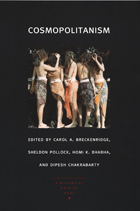 Cosmopolitanism
Carol A. Breckenridge, Sheldon Pollock, Homi K. Bhabha, and Dipesh Chakrabarty, eds.
Duke University Press, 2002 As the final installment of Public Culture’s Millennial Quartet, Cosmopolitanism assesses the pasts and possible futures of cosmopolitanism—or ways of thinking, feeling, and acting beyond one’s particular society. With contributions from distinguished scholars in disciplines such as literary studies, art history, South Asian studies, and anthropology, this volume recenters the history and theory of translocal political aspirations and cultural ideas from the usual Western vantage point to areas outside Europe, such as South Asia, China, and Africa. By examining new archives, proposing new theoretical formulations, and suggesting new possibilities of political practice, the contributors critically probe the concept of cosmopolitanism. On the one hand, cosmopolitanism may be taken to promise a form of supraregional political solidarity, but on the other, these essays argue, it may erode precisely those intimate cultural differences that derive their meaning from particular places and traditions. Given that most cosmopolitan political formations—from the Roman empire and European imperialism to contemporary globalization—have been coercive and unequal, can there be a noncoercive and egalitarian cosmopolitan politics? Finally, the volume asks whether cosmopolitanism can promise any universalism that is not the unwarranted generalization of some Western particular. Contributors. Ackbar Abbas, Arjun Appadurai, Homi K. Bhabha, T. K. Biaya, Carol A. Breckenridge, Dipesh Chakrabarty, Ousame Ndiaye Dago, Mamadou Diouf, Wu Hung, Walter D. Mignolo, Sheldon Pollock, Steven Randall
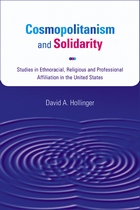 Cosmopolitanism and Solidarity: Studies in Ethnoracial, Religious, and Professional Affiliation in the United States
David A. Hollinger
University of Wisconsin Press, 2006 "Who are we?" is the question at the core of these fascinating essays from one of the nation's leading intellectual historians. With old identities increasingly destabilized throughout the world—the result of demographic migration, declining empires, and the quickening integration of the global capitalist economy and its attendant communications systems—David A. Hollinger argues that the problem of group solidarity is emerging as one of the central challenges of the twenty-first century.
Building on many of the topics in his highly acclaimed earlier work, these essays treat a number of contentious issues, many of them deeply embedded in America's past and present political polarization. Essays include "Amalgamation and Hypodescent," "Enough Already: Universities Do Not Need More Christianity," "Cultural Relativism," "Why Are Jews Preeminent in Science and Scholarship: The Veblen Thesis Reconsidered," and "The One Drop Rule and the One Hate Rule." Hollinger is at his best in his judicious approach to America's controversial history of race, ethnicity, and religion, and he offers his own thoughtful prescriptions as Americans and others throughout the world struggle with the pressing questions of identity and solidarity.
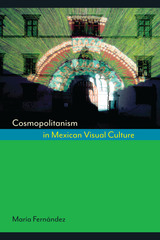 Cosmopolitanism in Mexican Visual Culture
By María Fernández
University of Texas Press, 2014 Since the colonial era, Mexican art has emerged from an ongoing process of negotiation between the local and the global, which frequently involves invention, synthesis, and transformation of diverse discursive and artistic traditions. In this pathfinding book, María Fernández uses the concept of cosmopolitanism to explore this important aspect of Mexican art, in which visual culture and power relations unite the local and the global, the national and the international, the universal and the particular. She argues that in Mexico, as in other colonized regions, colonization constructed power dynamics and forms of violence that persisted in the independent nation-state. Accordingly, Fernández presents not only the visual qualities of objects, but also the discourses, ideas, desires, and practices that are fundamental to the very existence of visual objects. Fernández organizes episodes in the history of Mexican art and architecture, ranging from the seventeenth century to the end of the twentieth century, around the consistent but unacknowledged historical theme of cosmopolitanism, allowing readers to discern relationships among various historical periods and works that are new and yet simultaneously dependent on their predecessors. She uses case studies of art and architecture produced in response to government commissions to demonstrate that established visual forms and meanings in Mexican art reflect and inform desires, expectations, memories, and ways of being in the world—in short, that visual culture and cosmopolitanism are fundamental to processes of subjectification and identity.
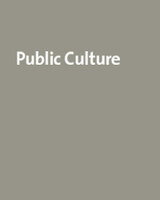 Cosmopolitanism: Millennial Quartet IV, Volume 12
Dipesh Chakrabarty
Duke University Press This final installment of the Millennial Quartet addresses the question of whether cosmopolitanism—ways of thinking, feeling, and acting beyond one’s particular society—is simply the universalism of a Western particular. Assembling scholars from an array of disciplines including English literature and language, romance languages, art history, South Asian studies, and anthropology, this special issue of Public Culture recenters the theory and history of translocal political aspirations and cultural ideas from the traditional Western vantage point to areas outside Europe, such as South Asia, China, and Africa. By examining new archives, framing new theoretical formulations, and suggesting new possibilities of political practice, these essays stretch the term cosmopolitanism to new definitions. On the one hand, cosmopolitanism may be taken to promise a form of supraregional political solidarity, but on the other, it may erode precisely those cultural differences that derive their meaning from a particular place and tradition. Given that most cosmopolitan political formations, from the Roman imperium to European imperialism to contemporary globalization, have been coercive and unequal, can there be a noncoercive and egalitarian cosmopolitan politics? At the most elevated level of conceptualization, while cosmopolitanism may promise a universalism of knowledge, it more typically represents an unwarranted generalization of a European idea or practice.
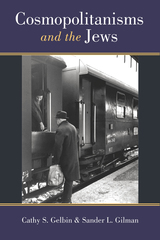 Cosmopolitanisms and the Jews
Cathy S. Gelbin and Sander L. Gilman
University of Michigan Press, 2017 Cosmopolitanisms and the Jews adds significantly to contemporary scholarship on cosmopolitanism by making the experience of Jews central to the discussion, as it traces the evolution of Jewish cosmopolitanism over the last two centuries. The book sets out from an exploration of the nature and cultural-political implications of the shifting perceptions of Jewish mobility and fluidity around 1800, when modern cosmopolitanist discourse arose. Through a series of case studies, the authors analyze the historical and discursive junctures that mark the central paradigm shifts in the Jewish self-image, from the Wandering Jew to the rootless parasite, the cosmopolitan, and the socialist internationalist. Chapters analyze the tensions and dualisms in the constructed relationship between cosmopolitanism and the Jews at particular historical junctures between 1800 and the present, and probe into the relationship between earlier anti-Semitic discourses on Jewish cosmopolitanism and Stalinist rhetoric.
 Cosmopolitans and Parochials: Modern Orthodox Jews in America
Samuel C. Heilman and Steven M. Cohen
University of Chicago Press, 1989 Far from simply vanishing in the face of modernity, Orthodox Jews in the United States today are surviving and flourishing. Samuel C. Heilman and Steven M. Cohen, both distinguished scholars of Jewish studies, have joined forces in this pathbreaking book to articulate this vibrancy and to characterize the many faces of Orthodox Jewry in contemporary America. Who are these Orthodox Jews? How have they survived, what do they believe and practice and how do they accommodate the tension between traditional Jewish and modern American values? Drawing on a survey of more than one thousand participants, the authors address these questions and many more.
Heilman and Cohen reveal that American Jewish Orthodoxy is not a monolith by distinguishing its three broad varieties: the "traditionalists," the "centrists," and the "nominally" orthodox. To illuminate this full spectrum of orthodoxy the authors focus on the "centrists," taking us through the dimensions of their ritual observances, religious beliefs, community life, and their social, political, and sexual attitudes. Both parochial and cosmopolitan, orthodox and liberal, these Jews are characterized by their dualism, by their successful involvement in both the modern Western world and in traditional Jewish culture. In painting this provocative and fascinating portrait of what Jewish Orthodoxy has become in America today, Heilman and Cohen's study also sheds light on the larger picture of the persistence of religion in the modern world.
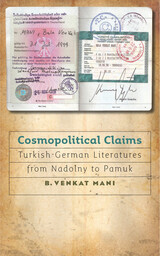 Cosmopolitical Claims: Turkish-German Literatures from Nadolny to Pamuk
B. Venkat Mani
University of Iowa Press, 2007 When both France and Holland rejected the proposed constitution for the European Union in 2005, the votes reflected popular anxieties about the entry of Turkey into the European Union as much as they did ambivalence over ceding national sovereignty. Indeed, the votes in France and Holland echoed long standing tensions between Europe and Turkey. If there was any question that tensions were high, the explosive reaction of Europe’s Muslim population to a series of cartoons of Mohammed in a Danish newspaper put them to rest. Cosmopolitical Claims is a profoundly original study of the works of Sten Nadonly, Emine Sevgi Özdamar, Feridun Zaimoglu, and 2006 Nobel prize in literature recipient Orhan Pamuk. Rather than using the proverbial hyphen in “Turkish-German” to indicate a culture caught between two nations, Venkat Mani is interested in how Turkish-German literature engages in a scrutiny of German and Turkish national identity.
Moving deftly from the theoretical literature to the texts themselves, Mani’s groundbreaking study explores these conflicts and dialogues and the resulting cultural hybridization as they are expressed in four novels that document the complexity of Turkish-German cultural interactions in the late twentieth and early twenty-first centuries. His innovative readings will engage students of contemporary German literature as well as illuminate the discussion of minority literature in a multicultural setting.
As Salman Rushdie said in the 2002 Tanner Lecture at Yale, “The frontier is an elusive line, visible and invisible, physical and metaphorical, amoral and moral. . . . To cross a frontier is to be transformed.” It is in this vein that Mani’s dynamic and subtle work posits a still evolving discourse between Turkish and German writers.
 Cosmopolitics I
Isabelle Stengers
University of Minnesota Press, 2010 From Einstein’s quest for a unified field theory to Stephen Hawking’s belief that we “would know the mind of God” through such a theory, contemporary science—and physics in particular—has claimed that it alone possesses absolute knowledge of the universe. In a sweeping work of philosophical inquiry, originally published in French in seven volumes, Isabelle Stengers builds on her previous intellectual accomplishments to explore the role and authority of science in modern societies and to challenge its pretensions to objectivity, rationality, and truth. For Stengers, science is a constructive enterprise, a diverse, interdependent, and highly contingent system that does not simply discover preexisting truths but, through specific practices and processes, helps shape them. She addresses conceptual themes crucial for modern science, such as the formation of physical-mathematical intelligibility, from Galilean mechanics and the origin of dynamics to quantum theory, the question of biological reductionism, and the power relations at work in the social and behavioral sciences. Focusing on the polemical and creative aspects of such themes, she argues for an ecology of practices that takes into account how scientific knowledge evolves, the constraints and obligations such practices impose, and the impact they have on the sciences and beyond. This perspective, which demands that competing practices and interests be taken seriously rather than merely (and often condescendingly) tolerated, poses a profound political and ethical challenge. In place of both absolutism and tolerance, she proposes a cosmopolitics—modeled on the ideal scientific method that considers all assumptions and facts as being open to question—that reintegrates the natural and the social, the modern and the archaic, the scientific and the irrational. Cosmopolitics I includes the first three volumes of the original work. Cosmopolitics II will be published by the University of Minnesota Press in Spring 2011.
 Cosmopolitics II
Isabelle Stengers
University of Minnesota Press, 2011 Originally published in French in seven volumes, Cosmopolitics investigates the role and authority of the sciences in modern societies and challenges their claims to objectivity, rationality, and truth. Cosmopolitics II includes the first English-language translations of the last four books: Quantum Mechanics: The End of the Dream, In the Name of the Arrow of Time: Prigogine’s Challenge, Life and Artifice: The Faces of Emergence, and The Curse of Tolerance.
Arguing for an “ecology of practices” in the sciences, Isabelle Stengers explores the discordant landscape of knowledge derived from modern science, seeking intellectual consistency among contradictory, confrontational, and mutually exclusive philosophical ambitions and approaches. For Stengers, science is a constructive enterprise, a diverse, interdependent, and highly contingent system that does not simply discover preexisting truths but, through specific practices and processes, helps shape them. Stengers concludes this philosophical inquiry with a forceful critique of tolerance; it is a fundamentally condescending attitude, she contends, that prevents those worldviews that challenge dominant explanatory systems from being taken seriously. Instead of tolerance, she proposes a “cosmopolitics” that rejects politics as a universal category and allows modern scientific practices to peacefully coexist with other forms of knowledge.
 Cosmopolitics of the Camera: Albert Kahn's Archives of the Planet
Edited by Trond Erik Bjorli and Kjetil Ansgar Jakobsen
Intellect Books, 2020 In Cosmopolitics of the Camera, the leading experts in the field present Les Archives de la Planète—Albert Kahn’s stunning collection of early color photography and documentary film—and discuss the extraordinary intellectual context from which it grew. The archives, collected between 1909 and 1932, show the cultural richness and diversity of humanity at a time of drastic geographical and historical change. Consisting of 183 thousand meters of film, 72 thousand autochromes and more than 6 thousand stereographs, it portrays the beauty and creativity of cultures whose fatal disappearance Kahn believed to be only a question of time.
The Archives of the Planet was one of a string of institutions for research and international cooperation established in Kahn’s utopian World Gardens near Paris. Some of the best-known minds of the age met there regularly to discuss the problem of how to make new media of communication serve the cause of peace and human development. Cosmopolitics of the Camera presents ten expert voices from seven different countries, studying the work of Kahn and his key collaborators, the geographer Jean Brunhes and the philosopher Henri Bergson, in the spirit of their culturally diverse venture, placing it in its proper historical and intellectual context, and exploring its ambitious achievements and failures. By pushing Kahn’s work back into active discussion, the analysis forces us to reflect on the ways our world is shaped and recorded by the media, and reactivates the time capsule that Kahn designed to communicate with the future.
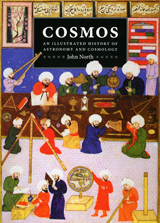 Cosmos: An Illustrated History of Astronomy and Cosmology
John North
University of Chicago Press, 2008 For millennia humans have studied the skies to help them grow crops, navigate the seas, and earn favor from their gods. We still look to the stars today for answers to fundamental questions: How did the universe begin? Will it end, and if so, how? What is our place within it? John North has been examining such questions for decades. In Cosmos, he offers a sweeping historical survey of the two sciences that help define our place in the universe: astronomy and cosmology.
Organizing his history chronologically, North begins by examining Paleolithic cave drawings that clearly chart the phases of the moon. He then investigates scientific practices in the early civilizations of Egypt, Greece, China, and the Americas (among others), whose inhabitants developed sophisticated methods to record the movements of the planets and stars. Trade routes and religious movements, North notes, brought these ancient styles of scientific thinking to the attention of later astronomers, whose own theories—such as Copernicus’ planetary theory—led to the Scientific Revolution.
The work of master astronomers, including Ptolemy, Galileo, Kepler, and Newton, is described in detail, as are modern-day developments in astrophysics, such as the advent of radio astronomy, the brilliant innovations of Einstein, and the many recent discoveries brought about with the help of the Hubble telescope. This new edition brings North’s seminal book right up to the present day, as North takes a closer look at last year’s reclassification of Pluto as a “dwarf” planet and gives a thorough overview of current research.
With more than two hundred illustrations and a comprehensive bibliography, Cosmos is the definitive history of astronomy and cosmology. It is sure to find an eager audience among historians of science and astronomers alike.
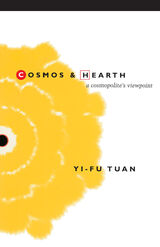 Cosmos And Hearth: A Cosmopolite’s Viewpoint
Yi-Fu Tuan
University of Minnesota Press, 1999 In a volume that represents the culmination of his life’s work in considering the relationship between culture and landscape, eminent scholar Yi-Fu Tuan argues that “cosmos” and “hearth” are two scales that anchor what it means to be fully and happily human. Illustrating this contention with examples from both his native China and his home of the past forty years, the United States, Tuan proposes a revised conception of culture, one thoroughly grounded in one’s own society but also embracing curiosity about the world. Optimistic and deeply human, this important volume lays out a path to being “at home in the cosmos.” Hardcover:In this moving meditation on the difficult choices facing humanity in the next millennium, celebrated scholar Yi-Fu Tuan reaffirms his faith in the value of a cosmopolitan worldview. In a volume that represents the culmination of his life's work in considering the relationship between culture and landscape, Tuan argues that “cosmos” and “hearth” are two scales that anchor what it means to be fully and happily human. Hearth is our house and neighborhood, family and kinfolk, habit and custom. Cosmos, by contrast, is the larger reality-world, civilization, and humankind. Tuan addresses the extraordinary revival of interest in the hearth in recent decades, examining both the positive and negative effects of this renewed concern. Among the beneficent outcomes has been a revival of ethnic culture and sense of place. Negative repercussions abound, however, manifested as an upsurge in superstition, excessive pride in ancestry and custom, and a constricted worldview that when taken together can inflame local passions, leading at times to violent conflict-from riots in American cities to wars in the Balkans. In Cosmos and Hearth, Tuan takes the position that we need to embrace both the sublime and the humble, drawing what is valuable from each. Illustrating the importance of both cosmos and hearth with examples from his country of birth, China, and from his home of the past forty years, the United States, Tuan proposes a revised conception of culture, the “cosmopolitan hearth,” that has the coziness but not the narrowness and bigotry of the traditional hearth. Tuan encourages not only being thoroughly grounded in one’s own culture but also the embracing of curiosity about the world. Optimistic and deeply human, Cosmos and Hearth lays out a path to being “at home in the cosmos.” Born in China and educated in Australia, the Philippines, England, and the United States, Yi-Fu Tuan is professor of geography at the University of Wisconsin, Madison, and the author of Space and Place: The Perspective of Experience (Minnesota, 1977), Landscapes of Fear (Minnesota, 1982), The Good Life (1986), and Passing Strange and Wonderful: Aesthetics, Nature, and Culture (1993). Excerpt: “Thinking yields a twofold gain: although it isolates us from our immediate group it can link us both seriously and playfully to the cosmos-to strangers in other places and times; and it enables us to accept a human condition that we have always been tempted by fear and anxiety to deny, namely, the impermanence of our state wherever we are, our ultimate homelessness. A cosmopolite is one who considers the gain greater than the loss. Having seen something of the splendid spaces, he or she will not want to return, permanently, to the ambiguous safeness of the hearth.”
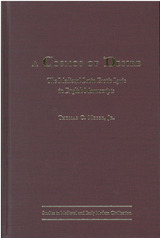 A Cosmos of Desire: The Medieval Latin Erotic Lyric in English Manuscripts
Thomas C Moser, Jr.
University of Michigan Press, 2004
Thomas C. Moser, Jr. explores the fascinating body of medieval Latin erotic poetry found in English manuscripts. His study describes the intellectual and social context from which the great erotic songs of the twelfth century emerged, and examines a variety of erotic poems, from school exercises to the magnificent lyrics found in Arundel 384. He also illuminates the influence of neoplatonic philosophy on this poetry, explicating key neoplatonic texts and applying that analysis in close readings of erotic lyrics from the same period and milieu.
A Cosmos of Desire will interest scholars of medieval literature as well as specialists in Latin poetry and philosophy. Students of Middle English literature will find that it fills an important gap in our understanding of English intellectual life between the twelfth and the fourteenth century. All Latin prose and poetry is translated, some works for the first time, and the book is generously illustrated with photographs of the manuscripts discussed.
Thomas C. Moser, Jr. is Associate Professor of English at the University of Maryland, College Park.
The Cosmos Of Science: Essays of Exploration
John Earman
University of Pittsburgh Press, 1998 The inaugural volume of the series, devoted to the work of philosopher Adolf Grünbaum, encompasses the philosophical problems of space, time, and cosmology, the nature of scientific methodology, and the foundations of psychoanalysis.
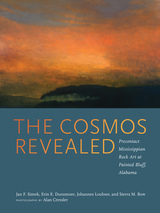 The Cosmos Revealed: Precontact Mississippian Rock Art at Painted Bluff, Alabama
By Jan F. Simek, Erin E. Dunsmore, Johannes Loubser, and Sierra M. Bow
University of Alabama Press, 2021 The definitive rock art book on Painted Bluff, Alabama
Boasting more than 130 paintings and engravings, Painted Bluff is perhaps the most elaborate prehistoric pictograph site east of the Mississippi River. Positioned at several levels on a dramatic sandstone cliff along the Tennessee River in northern Alabama, the spectacular paintings and engravings depict mythical creatures, dancing humans, and mystical portals. The Cosmos Revealed: Precontact Mississippian Rock Art at Painted Bluff, Alabama is the first complete documentation of one of the most important archaeological sites in eastern North America. Through art, the site materializes a model or “cosmogram” of the Mississippian Native American view of the universe, offering connections between the visible and invisible worlds for Native spiritual leaders and other visitors.
Discovered by Euro-Americans in the early 1800s, the site became known as “Painted Bluff” because of its pictographs, but inexplicably it has only recently been subjected to the intensive archaeological study it deserves. Under the auspices of the Tennessee Valley Authority (TVA), the authors of this volume have documented and assessed the site since 2005, and efforts have been made to reverse some of the vandalism that has occurred over many decades and to stabilize natural degradation of the cliff and its artwork.
Including more than one hundred remarkable prehistoric paintings on the cliff face that have been recorded, mapped, and photographed, this book synthesizes the research done on Painted Bluff to date and documents the entire site. Richly illustrated chapters cover the historical background, geology and archaeology, documentation methods, types of rock art, stratigraphy, paint recipes, TVA management, graffiti removal, and a summary that broadly synthesizes the meaning, timeframe, artistry, organization, conceptual boundaries, and the cosmos revealed. This groundbreaking study features 113 color photographs and a complete catalog of the pictographs and petroglyphs at the site.
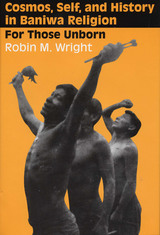 Cosmos, Self, and History in Baniwa Religion: For Those Unborn
By Robin M. Wright
University of Texas Press, 1998 The Baniwa Indians of the Northwest Amazon have engaged in millenarian movements since at least the middle of the nineteenth century. The defining characteristic of these movements is usually a prophecy of the end of this present world and the restoration of the primordial, utopian world of creation. This prophetic message, delivered by powerful shamans, has its roots in Baniwa myths of origin and creation. In this ethnography of Baniwa religion, Robin M. Wright explores the myths of creation and how they have been embodied in religious movements and social action—particularly in a widespread conversion to evangelical Christianity. He opens with a discussion of cosmogony, cosmology, and shamanism, and then goes on to explain how Baniwa origin myths have played an active role in shaping both personal and community identity and history. He also explores the concepts of death and eschatology and shows how the mythology of destruction and renewal in Baniwa religion has made the Baniwa people receptive to both Catholic and Protestant missionaries.
 Cosmosexuals: Screen Acting, Stardom, and Male Sex Appeal
Mark Gallagher
University of Texas Press, 2025 An examination of male screen sex appeal and the ways that race, ethnicity, and national origin combine with performance tools and film and television style to aid or inhibit actors’ circulation on an increasingly global stage. Sex appeal is complicated, especially for screen actors. Looking good is not enough. Charisma and charm have to register when the camera rolls. And sexiness has to travel. Today’s heartthrobs are expected to raise temperatures all around the world. Cosmosexuals theorizes male sex appeal as a form of capital in an age of international stardom. Screen scholar Mark Gallagher assembles a diverse cast—Idris Elba, Pedro Pascal, Simu Liu, Ryan Gosling, and more—analyzing how each actor uses his appearance, voice, and movement to perform in ways that viewers across cultural divides register as sexually appealing. Cosmosexuals also explores the intersection of global sex appeal and exoticism in historical and contemporary contexts—from the malleable racial identities of Omar Sharif and Conrad Veidt to Mads Mikkelsen’s “accented whiteness”—and assesses the barriers that confine nonwhite actors, in spite of their talent or celebrity. Far more than handsome faces and chiseled abs, male sex symbols emerge as laborers subject to disciplinary regimes steeped in patriarchy, racism, and structural inequity. As such, they have much to tell us about the economies of taste at work in the construction of screen masculinity and the terms of human desire.
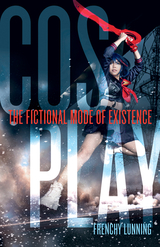 Cosplay: The Fictional Mode of Existence
Frenchy Lunning
University of Minnesota Press, 2022 An exploration of cosplay and its relationship with the realms of its global fandom, performance, and the modes of fictional existence
Flourishing far beyond its Japanese roots, cosplay has become an international phenomenon with fervid fans who gather at enormous, worldwide conventions annually. Here, author Frenchy Lunning offers an intimate, sensational tour through cosplay’s past and present, as well as its global lure. Through a culmination of years of personal research on cosplay, and growing out of Lunning’s wealth of scholarship, conference presentations, and cosplayer interviews, Cosplay is a unique and necessary examination of identity, performance, play, and otaku fandom and culture in relation to contemporary theories. With discussions covering construction, masquerades, and community through performance, Lunning presents cosplay as a dynamic and ever-evolving global practice. She combines the fascinating viewpoints of cosplayers with observational, in-depth research on cosplay history and practice, and a deep dive into critical theory involving the modes of fictional existence, in order to understand its global expansion. Augmented with beautiful photographs, this is an engrossing, lively read that explores a complicated and often misunderstood history and meditates on how cosplay allows its participants to create and construct meaning and identity.
The Cossack Hero in Russian Literature: A Study in Cultural Mythology
Judith Deutsch Kornblatt
University of Wisconsin Press, 1992 This is the first book to study the development of the Cossack hero and to identify him as part of Russian cultural mythology. Kornblatt explores the power of the myth as a literary image, providing new and challenging readings of Pushkin, Gogol, Tolstoi, and a host of other writers.
Cost and Choice: An Inquiry in Economic Theory
James M. Buchanan
University of Chicago Press, 1979 "As he usually does, Professor Buchanan has produced an interesting and provocative piece of work. [Cost and Choice] starts off as an essay in the history of cost theory; the central ideas of the book are traced to Davenport and Knight in the United States, and to a series of distinguished writers associated at various times with the London School of Economics. The author emerges from this discussion with what can be described as the ultimate in subjectivist cost doctrines. . . . Economists should learn the lessons offered to us in this little book—and learn them well. It can save them from serious errors."—William J. Baumol, Journal of Economic Literature
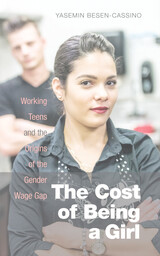 The Cost of Being a Girl: Working Teens and the Origins of the Gender Wage Gap
Yasemin Besen-Cassino
Temple University Press, 2017 The gender wage gap is one of the most persistent problems of labor markets and women’s lives. Most approaches to explaining the gap focus on adult employment despite the fact that many Americans begin working well before their education is completed. In her critical and compelling new book, The Cost of Being a Girl, Yasemin Besen-Cassino examines the origins of the gender wage gap by looking at the teenage labor force, where comparisons between boys and girls ought to show no difference, but do. Besen-Cassino’s findings are disturbing. Because of discrimination in the market, most teenage girls who start part-time work as babysitters and in other freelance jobs fail to make the same wages as teenage boys who move into employee-type jobs. The “cost” of being a girl is also psychological; when teenage girls work retail jobs in the apparel industry, they have lower wages and body image issues in the long run. Through in-depth interviews and surveys with workers and employees, The Cost of Being a Girl puts this alarming social problem—which extends to race and class inequality—in to bold relief. Besen-Cassino emphasizes that early inequalities in the workplace ultimately translate into greater inequalities in the overall labor force.
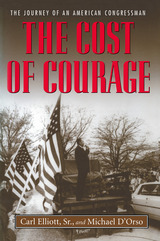 The Cost of Courage: The Journey of an American Congressman
Carl Elliott
University of Alabama Press, 2001 This deeply moving story chronicles the tenacity and vision that carried Carl Elliott from the hills of northwest Alabama to eight distinguished terms in the United States House of Representatives. Born in a log cabin on a tenant farm in 1913, Carl Elliott worked his way through The University of Alabama during the Great Depression and was elected to Congress in 1948. With a no-nonsense philosophy of fairness and equal opportunity, he established himself as one of the most effective members of the House of Representatives during the 1950s. He was a progressive Democrat and he fought hard for the dirt farmers and coal miners he grew up with and who sent him to Congress. In an era when racial segregationists dominated southern politics, Elliott worked with many of the important political leaders of the 20th century, including Presidents Truman, Eisenhower, and Kennedy and powerful House Speaker Sam Rayburn. He was instrumental in passing the National Defense Education Act of 1958, which continues to provide college loans to more than 20 million Americans. But his brave stand against racism and George Wallace in the 1966 Alabama gubernatorial race ruined him professionally (he never returned to elected office) and financially (he cashed in his congressional pension to help fund the campaign). Even as a destitute invalid in his old age, however, Elliott kept his dignity and integrity intact. The life story of Carl Elliott is full of humor and wry wisdom and explains how he made his way across a stage as big as America, influencing its politics and future, and then emerged, belatedly, as an unsung hero of the fight for civil rights and equality.
 The Cost of Free Shipping: Amazon in the Global Economy
Jake Alimahomed-Wilson
Pluto Press, 2021 Winner of the United Association for Labor Education Book Award 2021, this is essential reading for everyone who wants to understand the role of Amazon in our economy and society. With Amazon, supply-chain, and unionization in the news, it is both timely and incredibly informative.
Amazon is the most powerful corporation on the planet and its CEO, Jeff Bezos, has become one of the richest individuals in history, and one of the few people to profit from a global pandemic. Its dominance has reshaped the global economy itself: we live in the age of “Amazon Capitalism.”
“One-click” instant consumerism and its immense variety of products has made Amazon a worldwide household name, with over 60% of US households subscribing to Amazon Prime. In turn, these subscribers are surveilled by the corporation. Amazon is also one of the world's largest logistics companies, resulting in weakened unions and lowered labor standards.
The company has also become the largest provider of cloud-computing services and home surveillance systems, not to mention the ubiquitous Alexa.
With cutting-edge analyses, this book looks at the many dark facets of the corporation, including automation, surveillance, tech work, workers' struggles, algorithmic challenges, the disruption of local democracy and much more. The Cost of Free Shipping shows how Amazon represents a fundamental shift in global capitalism that we should name, interrogate, and be primed to resist.
 The Cost of Inaction: Case Studies from Rwanda and Angola
Sudhir Anand, Chris Desmond, Habtamu Fuje, and Nadejda Marques
Harvard University Press, 2012 This book is motivated by the idea that the cost of inaction can be much greater than the cost of action. Inaction can lead to serious negative consequences—for individuals, the economy, and society. The consequences of a failure to reduce extreme poverty, for example, typically include malnutrition, preventable morbidity, premature mortality, incomplete basic education, and other human and social development costs. In this volume, the authors seek to clarify exactly what is meant by “cost of inaction.” They develop a methodology to account for the consequences and estimate the costs of a failure to respond to the needs of children and their families. Their conceptual framework emphasizes the need to select appropriate actions against which inaction is evaluated. The authors present the results of applying the cost of inaction (COI) approach to six case studies from Rwanda and Angola. The case studies highlight important differences between the COI approach and benefit-cost analysis as it is traditionally implemented.
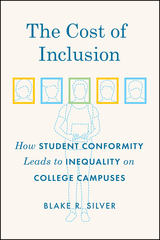 The Cost of Inclusion: How Student Conformity Leads to Inequality on College Campuses
Blake R. Silver
University of Chicago Press, 2020 Young people are told that college is a place where they will “find themselves” by engaging with diversity and making friendships that will last a lifetime. This vision of an inclusive, diverse social experience is a fundamental part of the image colleges sell potential students. But what really happens when students arrive on campus and enter this new social world? The Cost of Inclusion delves into this rich moment to explore the ways students seek out a sense of belonging and the sacrifices they make to fit in.
Blake R. Silver spent a year immersed in student life at a large public university. He trained with the Cardio Club, hung out with the Learning Community, and hosted service events with the Volunteer Collective. Through these day-to-day interactions, he witnessed how students sought belonging and built their social worlds on campus. Over time, Silver realized that these students only achieved inclusion at significant cost. To fit in among new peers, they clung to or were pushed into raced and gendered cultural assumptions about behavior, becoming “the cool guy,” “the nice girl,” “the funny one,” “the leader,” “the intellectual,” or “the mom of the group.” Instead of developing dynamic identities, they crafted and adhered to a cookie-cutter self, one that was rigid and two-dimensional. Silver found that these students were ill-prepared for the challenges of a diverse college campus, and that they had little guidance from their university on how to navigate the trials of social engagement or the pressures to conform. While colleges are focused on increasing the diversity of their enrolled student body, Silver’s findings show that they need to take a hard look at how they are failing to support inclusion once students arrive on campus.
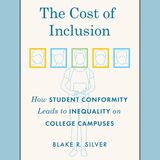 The Cost of Inclusion: How Student Conformity Leads to Inequality on College Campuses
Blake R. Silver
University of Chicago Press, 2020 This is an auto-narrated audiobook version of this book.
Young people are told that college is a place where they will “find themselves” by engaging with diversity and making friendships that will last a lifetime. This vision of an inclusive, diverse social experience is a fundamental part of the image colleges sell potential students. But what really happens when students arrive on campus and enter this new social world? The Cost of Inclusion delves into this rich moment to explore the ways students seek out a sense of belonging and the sacrifices they make to fit in.
Blake R. Silver spent a year immersed in student life at a large public university. He trained with the Cardio Club, hung out with the Learning Community, and hosted service events with the Volunteer Collective. Through these day-to-day interactions, he witnessed how students sought belonging and built their social worlds on campus. Over time, Silver realized that these students only achieved inclusion at significant cost. To fit in among new peers, they clung to or were pushed into raced and gendered cultural assumptions about behavior, becoming “the cool guy,” “the nice girl,” “the funny one,” “the leader,” “the intellectual,” or “the mom of the group.” Instead of developing dynamic identities, they crafted and adhered to a cookie-cutter self, one that was rigid and two-dimensional. Silver found that these students were ill-prepared for the challenges of a diverse college campus, and that they had little guidance from their university on how to navigate the trials of social engagement or the pressures to conform. While colleges are focused on increasing the diversity of their enrolled student body, Silver’s findings show that they need to take a hard look at how they are failing to support inclusion once students arrive on campus.
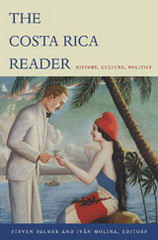 The Costa Rica Reader: History, Culture, Politics
Steven Palmer and Iván Molina, eds.
Duke University Press, 2004 Long characterized as an exceptional country within Latin America, Costa Rica has been hailed as a democratic oasis in a continent scorched by dictatorship and revolution; the ecological mecca of a biosphere laid waste by deforestation and urban blight; and an egalitarian, middle-class society blissfully immune to the violent class and racial conflicts that have haunted the region. Arguing that conceptions of Costa Rica as a happy anomaly downplay its rich heritage and diverse population, The Costa Rica Reader brings together texts and artwork that reveal the complexity of the country’s past and present. It characterizes Costa Rica as a site of alternatives and possibilities that undermine stereotypes about the region’s history and challenge the idea that current dilemmas facing Latin America are inevitable or insoluble. This essential introduction to Costa Rica includes more than fifty texts related to the country’s history, culture, politics, and natural environment. Most of these newspaper accounts, histories, petitions, memoirs, poems, and essays are written by Costa Ricans. Many appear here in English for the first time. The authors are men and women, young and old, scholars, farmers, workers, and activists. The Costa Rica Reader presents a panoply of voices: eloquent working-class raconteurs from San José’s poorest barrios, English-speaking Afro-Antilleans of the Limón province, Nicaraguan immigrants, factory workers, dissident members of the intelligentsia, and indigenous people struggling to preserve their culture. With more than forty images, the collection showcases sculptures, photographs, maps, cartoons, and fliers. From the time before the arrival of the Spanish, through the rise of the coffee plantations and the Civil War of 1948, up to participation in today’s globalized world, Costa Rica’s remarkable history comes alive. The Costa Rica Reader is a necessary resource for scholars, students, and travelers alike.
 Costa Rican Ecosystems
Edited by Maarten Kappelle
University of Chicago Press, 2016 In the more than thirty years since the publication of Daniel H. Janzen’s classic Costa Rican Natural History, research in this small but astonishingly biodiverse, well-preserved, and well-studied Latin American nation has evolved from a species-level approach to the study of entire ecosystems. And from the lowland dry forests of Guanacaste to the montane cloud forests of Monteverde, from the seasonal forests of the Central Valley to the coastal species assemblages of Tortuguero, Costa Rica has proven to be as richly diverse in ecosystems as it is in species.
In Costa Rican Ecosystems, Maarten Kappelle brings together a collection of the world’s foremost experts on Costa Rican ecology—outstanding scientists such as Daniel H. Janzen, Jorge Cortés, Jorge A. Jiménez, Sally P. Horn, Robert O. Lawton, Quírico Jiménez M., Carlos Manuel Rodríguez, Catherine M. Pringle, and Eduardo Carrillo J., among others—to offer the first comprehensive account of the diversity, structure, function, uses, and conservation of Costa Rica’s ecosystems. Featuring a foreword and introductory remarks by two renowned leaders in biodiversity science and ecological conservation, Thomas E. Lovejoy and Rodrigo Gámez Lobo, in addition to chapters highlighting the geology, soils, and climate of Costa Rica, as well as the ecosystems of its terrestrial, freshwater, and marine habitats, and including previously unpublished information on Isla del Coco, this beautiful color-illustrated book will be an essential reference for academic scientists, students, natural history guides, conservationists, educators, park guards, and visitors alike.
Costa Rican Natural History
Edited by Daniel H. Janzen
University of Chicago Press, 1983 This volume is a synthesis of existing knowledge about the flora and fauna of Costa Rica. The major portion of the book consists of detailed accounts of agricultural species, vegetation, amphibians, reptiles, mammals, birds, and insects.
"This is an extraordinary, virtually unique work. . . . The tremendous amount of original, previously unpublished, firsthand information is remarkable."—Peter H. Raven, Director, Missouri Botanical Garden
"An essential resource for anyone interested in tropical biology. . . . It can be used both as an encyclopedia—a source of facts on specific organisms—and as a source of ideas and generalizations about tropical ecology."—Alan P. Smith, Ecology
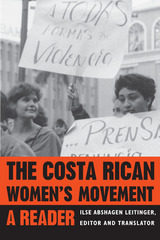 The Costa Rican Women's Movement: A Reader
Ilse Abshagen Leitinger
University of Pittsburgh Press, 1997
This reader reflects the genesis, scope, and direction of women’s activism in a single Latin American country. It collects the voices of forty-one diverse women who live in Costa Rica, some radical, others strongly conservative, and most ranging inbetween, as they write about their lives, their problems, their aspirations.
Unlike the comparative studies of women’s issues that look at several different countries, the reader provides an insider’s view of one small, but quintessentially Latin American, society. These women write of their own experience in organizing and working for change within the Costa Rican community. Some represent groups fitting into traditional “women’s movement” that wants to improve certain aspects of women’s and families’ daily lives. Still others, the “feminists,” argue forcefully that true improvement requires a profound change of power relations in society, of women’s access to power and decision making.
The articles are organized into thematic groups that range from the definitions of Feminism in Costa Rica to women in Costa Rican history, women’s legal equality, discrimination against women, and the status of Women’s Studies. The brief biographies that identify each author underscore the leadership of Costa Rican women in Latin American Feminism. The founders and editors of Mujer, one of the most influential Feminist journals in Latin America, are among the authors represented in the reader.
The audience for this book will include specialists interested in Latin America, in women in Latin America, and in the international women’s movement.
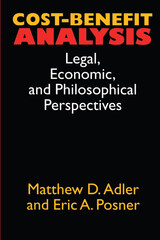 Cost-Benefit Analysis: Economic, Philosophical, and Legal Perspectives
Edited by Matthew D. Adler and Eric A. Posner
University of Chicago Press, 2001 Cost-benefit analysis is a widely used governmental evaluation tool, though academics remain skeptical. This volume gathers prominent contributors from law, economics, and philosophy for discussion of cost-benefit analysis, specifically its moral foundations, applications and limitations.
This new scholarly debate includes not only economists, but also contributors from philosophy, cognitive psychology, legal studies, and public policy who can further illuminate the justification and moral implications of this method and specify alternative measures.
These articles originally appeared in the Journal of Legal Studies.
Contributors:
- Matthew D. Adler - Gary S. Becker
- John Broome - Robert H. Frank
- Robert W. Hahn - Lewis A. Kornhauser
- Martha C. Nussbaum - Eric A. Posner
- Richard A. Posner - Henry S. Richardson
- Amartya Sen - Cass R. Sunstein
- W. Kip Viscusi
Costing the Earth?: Perspectives on Sustainable Development
Bernd Meyer
Haus Publishing, 2009 Our economies must react. "Sustainable behavior must pay off" - this is one of the central tenets of The Sustainability Project. Costing the Earth: Restructuring the Economy for Sustainable Development outlines the economic conditions for achieving the goal of sustainable development, in Europe and around the world. It also explains the incentives for sustainable economic management using economic tools.
 Costly Monuments: Representations of the Self in George Herbert’s Poetry
Barbara Leah Harman
Harvard University Press, 1982 In recent years George Herbert’s poetry has been analyzed by some of our most distinguished literary critics. Offering close readings of central poems, and insights derived from contemporary literary theory, Barbara Leah Harman takes her place in their company.
She begins by surveying the critical tradition on Herbert’s work in our century—from George Herbert Palmer to Stanley Fish. In this penetrating assessment Harman explores the relationship between critical practice and belief.
The impulse toward self-representation is, she argues, a powerful one in Herbert’s work, and it is also an impulse thwarted and redesigned in extraordinary ways. In poems Harman calls fictions of coherence and “chronicles of dissolution,” speakers both protect and dismantle their own narratives, and because they do they raise questions about the values we attach to stories and about the difficulties we undergo when stories fail to represent us in traditional ways.
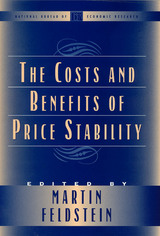 The Costs and Benefits of Price Stability
Edited by Martin Feldstein
University of Chicago Press, 1999 In recent years, the Federal Reserve and central banks worldwide have enjoyed remarkable success in their battle against inflation. The challenge now confronting the Fed and its counterparts is how to proceed in this newly benign economic environment: Should monetary policy seek to maintain a rate of low-level inflation or eliminate inflation altogether in an effort to attain full price stability?
In a seminal article published in 1997, Martin Feldstein developed a framework for calculating the gains in economic welfare that might result from a move from a low level of inflation to full price stability. The present volume extends that analysis, focusing on the likely costs and benefits of achieving price stability not only in the United States, but in Germany, Spain, and the United Kingdom as well. The results show that even small changes in already low inflation rates can have a substantial impact on the economic performance of different countries, and that variations in national tax rules can affect the level of gain from disinflation.
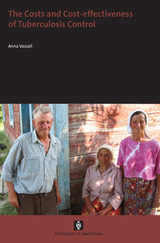 The Costs and Cost-effectiveness of Tuberculosis Control
Anna Vassall
Amsterdam University Press, 2009 Tuberculosis is a leading cause of ill-health and death in low and middle income countries. Tuberculosis control is essential for achieving the Millennium Development Goals relating to health by 2015. However, despite efforts made to expand tuberculosis control over the past decades, tuberculosis remains a serious global health problem. This book aims to assist the expansion of tuberculosis control by adding to the evidence on the cost-effectiveness of different tuberculosis control strategies. It presents research from five countries: Egypt, Ethiopia, Syria, Peru and Ukraine. It examines the implementation of the World Health Organization recommended strategy, Directly Observed Treatment Strategy (dots). New technologies currently being developed to tackle drug resistance are also assessed. Emphasis throughout is placed on the importance of health systems and the costs for patients accessing treatment. This book is essential reading for anyone interested in economic aspects of tuberculosis control.
 The Costs of Justice: How New Leaders Respond to Previous Rights Abuses
Brian K. Grodsky
University of Notre Dame Press, 2011
In The Costs of Justice, Brian K. Grodsky provides qualitative analyses of how transitional justice processes have evolved in diverse ways in postcommunist Poland, Croatia, Serbia, and Uzbekistan, by examining the decision-making processes and goals of those actors who contributed to key transitional justice policy decisions. Grodsky draws on extensive interviews with key political figures, human rights leaders, and representatives of various international, state, and nongovernmental bodies, as well as detailed analysis of international and local news reports, to offer a systematic and qualitatively compelling account of transitional justice from the perspective of activists who, at the end of a previous regime, were suddenly transformed from downtrodden victim to empowered judge.
Grodsky challenges the argument that transitional justice in post-repressive states is largely a function of the relative power of new versus old elites. He maintains that a new regime's transitional justice policy is closely linked to its capacity to provide goods and services expected by constituents, not to political power struggles. In introducing this goods variable, so common to broad political analysis but largely overlooked in the transitional justice debate, Grodsky argues that we must revise our understanding of transitional justice. It is not an exceptional issue; it is but one of many political decisions faced by leaders in a transition state.
"An insightful, profound, and conceptually innovative analysis of the daunting challenges encountered by the new democracies in their endeavors to confront the traumatic past. Grodsky's comparative approach allows him to highlight similarities and differences between states, institutions, and elites engaged in pursuing political and moral justice. A most valuable contribution to the major ongoing debate on the relationship between democracy, history, memory, and justice." --Vladimir Tismaneanu, University of Maryland
"Brian K. Grodsky seeks to understand the sources of diversity in transitional justice processes and, by implication, a broad range of post-conflict policy making. He develops and empirically evaluates a theoretical framework, relying on extensive original primary research and cross-national fieldwork--all things that have traditionally been lacking in much of the relevant transitional justice literature, until recently. The Costs of Justice is situated on the cutting edge of the field." --David Backer, The College of William & Mary
 Costs of Occupational Injuries and Illnesses
J. Paul Leigh, Steven Markowitz, Marianne Fahs, and Philip Landrigan
University of Michigan Press, 2000 As the debate over health care reform continues, costs have become a critical measure in the many plans and proposals to come before us. Knowing costs is important because it allows comparisons across such disparate health conditions as AIDS, Alzheimer's disease, heart disease, and cancer. This book presents the results of a major study estimating the large and largely overlooked costs of occupational injury and illness--costs as large as those for cancer and over four times the costs of AIDS.
The incidence and mortality of occupational injury and illness were assessed by reviewing data from national surveys and applied an attributable-risk-proportion method. Costs were assessed using the human capital method that decomposes costs into direct categories such as medical costs and insurance administration expenses, as well as indirect categories such as lost earnings and lost fringe benefits. The total is estimated to be $155 billion and is likely to be low as it does not include costs associated with pain and suffering or of home care provided by family members.
Invaluable as an aid in the analysis of policy issues, Costs of Occupational Injuryand Illness will serve as a resource and reference for economists, policy analysts, public health researchers, insurance administrators, labor unions and labor lawyers, benefits managers, and environmental scientists, among others.
J. Paul Leigh is Professor in the School of Medicine, Department of Epidemiology and Preventive Medicine, University of California, Davis. Stephen Markowitz, M.D., is Professor in the Department of Community Health and Social Medicine, City University of New York Medical School. Marianne Fahs is Director of the Health Policy Research Center, Milano Graduate School of Management and Urban Policy, New School University. Philip Landrigan, M.D., is Wise Professor and Chair of the Department of Community Medicine, Mount Sinai Medical Center, New York.
 The Costs of Poor Health Habits
Willard Manning, Emmett Keeler, Joseph P. Newhouse, Elizabeth Sloss, and Jeffrey Wasserman
Harvard University Press, 1991 Poor health habits (drinking, smoking, lack of exercise) obviously take their toll on individuals and their families. The costs to society are less obvious but certainly more far-reaching. This investigation is the first to quantify the financial burden these detrimental habits place on American taxpayers. Willard Manning and his colleagues measure the direct costs of poor health habits (fire damage, motor vehicle accidents, legal fees), as well as collectively financed costs (medical care, employee sick leave, group health and life insurance, nursing home care, retirement pensions, liability insurance). Consider two co-workers covered by their employer's health plan: both pay the same premium, yet if one drinks heavily, the other--through their mutual insurance program--involuntarily funds the resulting health problems.
After laying out their conceptual framework, methods, and analytical approach, the authors describe precisely how and to what extent drinking, smoking, and lack of exercise are currently subsidized, and make recommendations for reducing or reallocating the expense. They present, for example, a persuasive case for raising excise taxes on alcohol. The authors correlate their data to make costs comparable, to avoid double counting, and to determine the exact costs of each of these poor health habits and some of their findings are quite surprising.
This unique study will be indispensable to public health policy specialists and researchers, as well as to health economists.
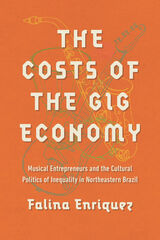 The Costs of the Gig Economy: Musical Entrepreneurs and the Cultural Politics of Inequality in Northeastern Brazil
Falina Enriquez
University of Illinois Press, 2022 Institutions in Recife, Brazil, have restructured subsidies in favor of encouraging musicians to become more entrepreneurial. Falina Enriquez explores how contemporary and traditional musicians in the fabled musical city have negotiated these intensified neoliberal cultural policies and economic uncertainties. Drawing on years of fieldwork, Enriquez shows how forcing artists to adopt “neutral” market solutions reinforces, and generates, overlapping racial and class-based inequalities. Lacking the social and financial resources of their middle-class peers, working-class musicians find it difficult to uphold institutional goals of connecting the city’s cultural roots to global markets and consumers. Enriquez also links the artists’ situation to that of cultural and creative workers around the world. As she shows, musical sponsorship in Recife and the contemporary gig economy elsewhere employ processes that, far from being neutral, uphold governmental and corporate ideologies that produce social stratification. Rich and vibrant, The Costs of the Gig Economy offers a rare English-language portrait of the changing musical culture in Recife.
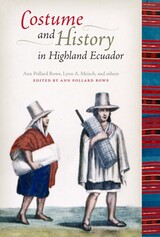 Costume and History in Highland Ecuador
Edited by Ann Pollard Rowe
University of Texas Press, 2011 The traditional costumes worn by people in the Andes—women's woolen skirts, men's ponchos, woven belts, and white felt hats—instantly identify them as natives of the region and serve as revealing markers of ethnicity, social class, gender, age, and so on. Because costume expresses so much, scholars study it to learn how the indigenous people of the Andes have identified themselves over time, as well as how others have identified and influenced them. Costume and History in Highland Ecuador assembles for the first time for any Andean country the evidence for indigenous costume from the entire chronological range of prehistory and history. The contributors glean a remarkable amount of information from pre-Hispanic ceramics and textile tools, archaeological textiles from the Inca empire in Peru, written accounts from the colonial period, nineteenth-century European-style pictorial representations, and twentieth-century textiles in museum collections. Their findings reveal that several garments introduced by the Incas, including men's tunics and women's wrapped dresses, shawls, and belts, had a remarkable longevity. They also demonstrate that the hybrid poncho from Chile and the rebozo from Mexico diffused in South America during the colonial period, and that the development of the rebozo in particular was more interesting and complex than has previously been suggested. The adoption of Spanish garments such as the pollera (skirt) and man's shirt were also less straightforward and of more recent vintage than might be expected.
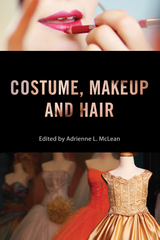 Costume, Makeup, and Hair
McLean, Adrienne L
Rutgers University Press, 2016 Movie buffs and film scholars alike often overlook the importance of makeup artists, hair stylists, and costumers. With precious few but notable exceptions, creative workers in these fields have received little public recognition, even when their artistry goes on to inspire worldwide fashion trends.
From the acclaimed Behind the Silver Screen series, Costume, Makeup, and Hair charts the development of these three crafts in the American film industry from the 1890s to the present. Each chapter examines a different era in film history, revealing how the arts of cinematic costume, makeup, and hair, have continually adapted to new conditions, making the transitions from stage to screen, from monochrome to color, and from analog to digital. Together, the book’s contributors give us a remarkable glimpse into how these crafts foster creative collaboration and improvisation, often fashioning striking looks and ingenious effects out of limited materials.
Costume, Makeup, and Hair not only considers these crafts in relation to a wide range of film genres, from sci-fi spectacles to period dramas, but also examines the role they have played in the larger marketplace for fashion and beauty products. Drawing on rare archival materials and lavish color illustrations, this volume provides readers with both a groundbreaking history of film industry labor and an appreciation of cinematic costume, makeup, and hairstyling as distinct art forms.
Cotton City: Urban Development in Antebellum Mobile
Harriet E. Amos Doss
University of Alabama Press, 2001 The exploration of the North-South relationship and the growth of of antebellum Mobile. Cotton City offers a compelling exploration of Mobile, Alabama’s transformation into a thriving urban center during the antebellum period. Historian Harriet E. Amos examines how economic ambition, civic planning, and the cotton trade shaped the city’s development between 1819 and 1861. Through detailed archival research, Amos reveals how Mobile’s leaders sought to modernize infrastructure, expand commerce, and assert the city’s regional importance—all while navigating the tensions of slavery, class, and Southern identity. This richly contextualized study highlights the interplay between urban growth and the broader forces of the Southern economy, making Cotton City a vital contribution to the histories of the American South, urbanization, and antebellum society.
 Cotton: Companies, Fashion and the Fabric of Our Lives
Edited by Joseph H. II Hancock, Nioka Wyatt, and Tasha L. Lewis
Intellect Books, 2016 This book brings together contributors from a wide range of disciplines to explore the importance of cotton as a major resource for US fashion businesses. It is rooted in a lengthy investigative research project that deployed undergraduate and graduate students and faculty researchers to US fashion businesses that rely on cotton to make their garments—with the goal of better understanding how such a key resource is sourced, priced, transported, manipulated, and, ultimately, sold on to the consumer as a stylish garment. The contributors focus in particular on the role of brands in the marketing of cotton goods, and the way that brand marketing creates distinctions, valuable in the marketplace, between various versions of what are at base similar items of clothing, like t-shirts and underclothes. The book also explores the importance of the “Made in the USA” campaign, with its appeal to consumers concerned about local manufacturing employment, reduced resource use, and social responsibility.
 Cotton Mather: The Young Life of the Lord’s Remembrancer, 1663–1703
David Levin
Harvard University Press, 1978 The first modern biography of Cotton Mather, David Levin's narrative makes clear the development of Mather's character and experience during forty years in which he was able to identify his own personal life with the fortunes of Congregational New England. On his relationship to his eminent father, the Puritan divine and Massachusetts statesman, Increase Mather, the history and cure of his stammer, his experience as a child prodigy at Harvard, his religious conversion, his vision of an angel, his leadership in the Glorious Revolution in Massachusetts, his encounters with the Devil during the witchcraft crises in Boston and Salem—on all these matters and more, Levin's account provides new interpretations that make this permanently controversial and legendary figure accessible and comprehensible in human as well as historical terms.
It is the triumph of Levin's biography that his subject's personal and literary lives are more closely woven into the fabric of the political history of his place and time than in any previous study. Mather's character, though seen sympathetically, develops in a narrative that deliberately avoids the constraints of prosecution and defense.
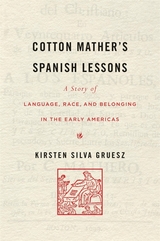 Cotton Mather’s Spanish Lessons: A Story of Language, Race, and Belonging in the Early Americas
Kirsten Silva Gruesz
Harvard University Press, 2022 A sweeping history of linguistic and colonial encounter in the early Americas, anchored by the unlikely story of how Boston’s most famous Puritan came to write the first Spanish-language publication in the English New World.
The Boston minister Cotton Mather was the first English colonial to refer to himself as an American. He was also the first to author a Spanish-language publication: La Fe del Christiano (The Faith of the Christian), a Protestant tract intended to evangelize readers across the Spanish Americas. Kirsten Silva Gruesz explores the conditions that produced La Fe del Christiano, from the intimate story of the “Spanish Indian” servants in Mather’s household, to the fragile business of printing and bookselling, to the fraught overlaps of race, ethnicity, and language that remain foundational to ideas of Latina/o/x belonging in the United States today.
Mather’s Spanish project exemplifies New England’s entanglement within a partially Spanish Catholic, largely Indigenous New World. British Americans viewed Spanish not only as a set of linguistic practices, but also as the hallmark of a rival empire and a nascent racial-ethnic category. Guided by Mather’s tract, Gruesz explores English settlers’ turbulent contacts with the people they called “Spanish Indians,” as well as with Black and local native peoples. Tracing colonial encounters from Boston to Mexico, Florida, and the Caribbean, she argues that language learning was intimately tied with the formation of new peoples. Even as Spanish has become the de facto second language of the United States, the story of La Fe del Christiano remains timely and illuminating, locating the roots of latinidad in the colonial system of the early Americas.
Cotton Mather’s Spanish Lessons reinvents our understanding of a key colonial intellectual, revealing notions about language and the construction of race that endure to this day.
Cotton Patch Schoolhouse
Susie Powers Tompkins
University of Alabama Press, 1992 Cotton-Patch Schoolhouse is a memoir of the author’s year as a young and inexperienced teacher in rural Marengo County, several miles from Linden, Alabama, in 1926. Seeking to earn money to continue college after her freshman year at AlabamaCollege in Montevallo, the author welcomed the opportunity to teach eight children at five different grade levels in a one-room schoolhouse in the middle of a cotton field. Youthful enthusiasm, native wit, and a sense of adventure helped her transform the simple schoolhouse into a place of learning and excitement.
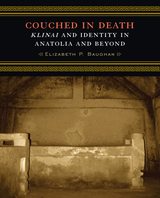 Couched in Death: Klinai and Identity in Anatolia and Beyond
Elizabeth P. Baughan
University of Wisconsin Press, 2013 In Couched in Death, Elizabeth P. Baughan offers the first comprehensive look at the earliest funeral couches in the ancient Mediterranean world. These sixth- and fifth-century BCE klinai from Asia Minor were inspired by specialty luxury furnishings developed in Archaic Greece for reclining at elite symposia. It was in Anatolia, however—in the dynastic cultures of Lydia and Phrygia and their neighbors—that klinai first gained prominence not as banquet furniture but as burial receptacles. For tombs, wooden couches were replaced by more permanent media cut from bedrock, carved from marble or limestone, or even cast in bronze. The rich archaeological findings of funerary klinai throughout Asia Minor raise intriguing questions about the social and symbolic meanings of this burial furniture. Why did Anatolian elites want to bury their dead on replicas of Greek furniture? Do the klinai found in Anatolian tombs represent Persian influence after the conquest of Anatolia, as previous scholarship has suggested? Bringing a diverse body of understudied and unpublished material together for the first time, Baughan investigates the origins and cultural significance of kline-burial and charts the stylistic development and distribution of funerary klinai throughout Anatolia. She contends that funeral couch burials and banqueter representations in funerary art helped construct hybridized Anatolian-Persian identities in Achaemenid Anatolia, and she reassesses the origins of the custom of the reclining banquet itself, a defining feature of ancient Mediterranean civilizations. Baughan explores the relationships of Anatolian funeral couches with similar traditions in Etruria and Macedonia as well as their "afterlife" in the modern era, and her study also includes a comprehensive survey of evidence for ancient klinai in general, based on analysis of more than three hundred klinai representations on Greek vases as well as archaeological and textual sources.
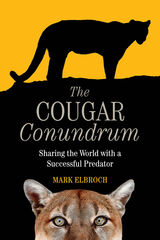 The Cougar Conundrum: Sharing the World with a Successful Predator
Mark Elbroch
Island Press, 2020 The relationship between humans and mountain lions has always been uneasy. A century ago, mountain lions were vilified as a threat to livestock and hunted to the verge of extinction. In recent years, this keystone predator has made a remarkable comeback, but today humans and mountain lions appear destined for a collision course. Its recovery has led to an unexpected conundrum: Do more mountain lions mean they’re a threat to humans and domestic animals? Or, are mountain lions still in need of our help and protection as their habitat dwindles and they’re forced into the edges and crevices of communities to survive?
Mountain lion biologist and expert Mark Elbroch welcomes these tough questions. He dismisses long-held myths about mountain lions and uses groundbreaking science to uncover important new information about their social habits. Elbroch argues that humans and mountain lions can peacefully coexist in close proximity if we ignore uninformed hype and instead arm ourselves with knowledge and common sense. He walks us through the realities of human safety in the presence of mountain lions, livestock safety, competition with hunters for deer and elk, and threats to rare species, dispelling the paranoia with facts and logic. In the last few chapters, he touches on human impacts on mountain lions and the need for a sensible management strategy. The result, he argues, is a win-win for humans, mountain lions, and the ecosystems that depend on keystone predators to keep them in healthy balance.
The Cougar Conundrum delivers a clear-eyed assessment of a modern wildlife challenge, offering practical advice for wildlife managers, conservationists, hunters, and those in the wildland-urban interface who share their habitat with large predators.
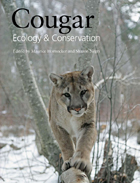 Cougar: Ecology and Conservation
Edited by Maurice Hornocker and Sharon Negri
University of Chicago Press, 2009 The cougar is one of the most beautiful, enigmatic, and majestic animals in the Americas. Eliciting reverence for its grace and independent nature, it also triggers fear when it comes into contact with people, pets, and livestock or competes for hunters’ game. Mystery, myth, and misunderstanding surround this remarkable creature. The cougar’s range once extended from northern Canada to the tip of South America, and from the Pacific to the Atlantic, making it the most widespread animal in the western hemisphere. But overhunting and loss of habitat vastly reduced cougar numbers by the early twentieth century across much of its historical range, and today the cougar faces numerous threats as burgeoning human development encroaches on its remaining habitat. When Maurice Hornocker began the first long-term study of cougars in the Idaho wilderness in 1964, little was known about this large cat. Its secretive nature and rarity in the landscape made it difficult to study. But his groundbreaking research yielded major insights and was the prelude to further research on this controversial species. The capstone to Hornocker’s long career studying big cats, Cougar is a powerful and practical resource for scientists, conservationists, and anyone with an interest in large carnivores. He and conservationist Sharon Negri bring together the diverse perspectives of twenty-two distinguished scientists to provide the fullest account of the cougar’s ecology, behavior, and genetics, its role as a top predator, and its conservation needs. This compilation of recent findings, stunning photographs, and firsthand accounts of field research unravels the mysteries of this magnificent animal and emphasizes its importance in healthy ecosystem processes and in our lives.
Could it Happen Here?: The Day a Prime Minister Refuses to Resign
Peter Hennessy and Andrew Blick
Haus Publishing, 2025 Does the United Kingdom’s constitution sufficiently protect its democracy from a rogue prime minister?
In light of the resurgence of the far Right across Europe and some of the rhetoric of the 2024 General Election, which carried whiffs of political authoritarianism, Could It Happen Here? explores the possible consequences of a British prime minister refusing to leave office. Mapping out the processes that might occur after such an eventuality, the responsibilities of key players in the United Kingdom’s democratic system, and the integrity of that system after years of stress, Peter Hennessy and Andrew Blick analyze the United Kingdom’s “unwritten” constitution and provide a crucial recommendation for protecting and strengthening the resilience of its parliamentary democracy.
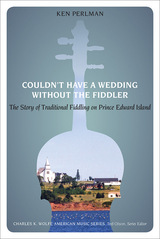 Couldn't Have a Wedding without the Fiddler: The Story of Traditional Fiddling on Prince Edward Island
Ken Perlman
University of Tennessee Press, 2015 Canada’s Prince Edward Island is home to one of the oldest and most vibrant fiddling traditions in North America. First established by Scottish immigrants in the late eighteenth century, it incorporated the influence of a later wave of Irish immigrants as well as the unique rhythmic sensibilities of the Acadian French, the Island’s first European inhabitants. In Couldn’t Have a Wedding without the Fiddler, renowned musician and folklorist Ken Perlman combines oral history, ethnography, and musical insight to present a captivating portrait of Prince Edward Island fiddling and its longstanding importance to community life.
Couldn’t Have a Wedding without the Fiddler draws heavily on interviews conducted with 150 fiddlers and other “Islanders”—including singers, dancers, music instructors, community leaders, and event organizers—whose memories span decades. The book thus colorfully brings to life a time not so very long ago when virtually any occasion—a wedding, harvest, house warming, holiday, or the need to raise money for local institutions such as schools and churchs—was sufficient excuse to hold a dance, with the fiddle player at the center of the celebration. Perlman explores how fiddling skills and traditions were learned and passed down through the generations and how individual fiddlers honed their distinctive playing styles. He also examines the Island’s history and material culture, fiddlers’ values and attitudes, the role of radio and recordings, the fiddlers’ repertoire, fiddling contests, and the ebb and flow of the fiddling tradition, including efforts over the last few decades to keep the music alive in the face of modernization and the passing of “old-timers.” Rounding out the book is a rich array of photographs, musical examples, dance diagrams, and a discography.
The inaugural volume in the Charles K. Wolfe American Music Series, Couldn’t Have a Wedding without the Fiddler is, in the words of series editor Ted Olson, “clearly among the more significant studies of a local North American music tradition to be published in recent years.”
A highly regarded banjoist, guitarist, teacher, and music collector, Ken Perlman previously published a collection of over 400 tunes called The Fiddle Music of Prince Edward Island: Celtic & Acadian Tunes in Living Tradition; he also produced a 2-CD set of field recordings for Rounder Records called The Prince Edward Island Style of Fiddling.. He has written several music instruction manuals now regarded as classics in their field, notably Clawhammer Style Banjo, Melodic Clawhammer Banjo, and Fingerstyle Guitar.
Council Fires On the Upper Ohio
Randolph Downes
University of Pittsburgh Press, 1968
Told from the viewpoint of the Indians, this account of Indian-white relations during the second half of the eighteenth century is an exciting addition to the historical literature of Pennsylvania.
From the beginning, when the white traders followed the first Shawnee hunters into Pennsylvania, until the Battle of Fallen Timbers in 1794, the region’s history was the history of the relationship between the Indians and the whites. For nearly half a century the Indian maintained a precarious hold upon Western Pennsylvania by playing one white faction off against the anther, first the French against the British, then the British against the Americans.
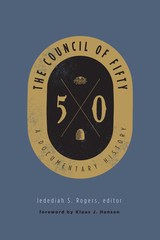 The Council of Fifty: A Documentary History
Jedediah S. Rogers
Signature Books, 2014 Mormon Church founder Joseph Smith had both millennial and temporal aspirations for the organization he called the Council of Fifty, named after the number of men who were intended to comprise it. Organized a few months before Smith’s death in June 1844, it continued under Brigham Young as a secret shadow government until 1851. Minutes from the earliest meetings are closed to researchers but contemporary accounts speak of a deliberative body preparing for Christ’s imminent reign. It also helped to sponsor Smith’s U.S. presidential bid and oversaw the exodus to present-day Utah.
One member downplayed the significance of this secret legislative body in 1849 as “nothing but a debating School.” On the contrary, a typical meeting included decisions regarding irrigation, fencing, and adobe housing, after which the group sang a song written by Parley P. Pratt: “Come ye sons of doubt and wonder; Indian, Moslem, Greek or Jew; … Be to all a friend and brother; Peace on Earth, good will to men.” Two weeks later, the council called for “blood to flow” to enforce its laws.
As the nineteenth century waned and the LDS Church moved toward the American mainstream, ending its emphasis on the imminent End of Days, there was no longer a need for a Church-managed municipal group destined to become the millennial world government. The council became irrelevant but survives today as a historical artifact available in fragmented documentary pieces which are presented here for the first time.
The Counselling Speeches of Jim Ka-Nipitehtew
Freda Ahenakew
University of Manitoba Press, 1998 A monolingual Cree speaker from Onion Lake, Saskatchewan, Jim Ka-Nipitehtew was a highly respected orator. His discourses have great force and authority, and no speeches of similar scope or depth have ever been published in their original form. He speaks of his concerns for young people, and of the proper performances of rituals, and gives an account of the signing of Treaty Six. These are superb examples of authentic spoken Cree texts. They are presented in syllabics, with Roman orthography and English translation on facing pages, and a glossary.
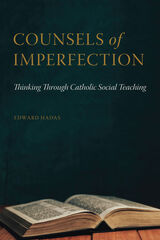 Counsels of Imperfection: Thinking Through Catholic Social Teaching
Edward Hadas
Catholic University of America Press, 2021 For more than a century, the teaching authority of the Catholic Church has attempted to walk along with the modern world, criticizing what is bad and praising what is good. Counsels of Imperfection described the current state of that fairly bumpy journey.
The book is divided into 11 chapters. First comes an introduction to ever-changing modernity and the unchanging Christian understanding of human nature and society. Then come two chapters on economics, including a careful delineation of the Catholic response, past and present, to socialism and capitalism. The next topic is government, with one chapter on Church and State, another on War, and a third that runs quickly through democracy, human rights, the welfare state, crimes and punishments (including the death penalty), anti-Semitism, and migration.
Counsels of Imperfection then dedicates two chapters on ecology, including an enthusiastic analysis of Francis’s “technocratic paradigm”. The last topic is the family teaching, which presents the social aspects of the Church’s sexual teaching. A brief concluding chapter looks at the teaching’s changing response to the modern world, and at the ambiguous Catholic appreciation of the modern idea of progress.
For each topic, Counsels of Imperfection provides biblical, historical and a broad philosophical background. Thomas Aquinas appears often, but so does G. W. F Hegel. The goal is not only to explain what the Church really says, but also how it got to its current position and who it is arguing with. In the spirit of a doctrine that is always in development, Counsels of Imperfection points out both strong-points and imperfections in the teaching.
The book should be of interest to specialists in Catholic Social Teaching, but its main audience is curious newcomers, especially people who do not want to be told that there are simple Catholic answers to the complicated problems of the modern world.
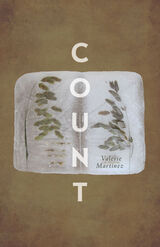 Count
Valerie Martínez
University of Arizona Press, 2021 Count is a powerful book-length poem that reckons with the heartbreaking reality of climate change. Forty-three sections of myth-gathering, flora and fauna, accounts of climate devastation, personal narratives, witnessing, references to works of eco-art, and evocations of children unfold over the course of the book, creating a deeply nuanced image of the current climate crisis. Central to this vital work of ecopoetry is the idea of counting—counting down to the extinction of a species, counting the wonders of the natural world, counting our way back to the balance that is required to save ourselves from climate destruction. Filled with a sense of grief and sorrow for the current state of the planet, Count also offers a glimmering hope that future generations will restore our damaged environment.
With sections that vary between poetry, science, Indigenous storytelling, numerical measurement, and narration, Valerie Martínez’s new work results in an epic panorama infused with the timely urgency of facing an apocalyptic future. This beautiful, tragic, and unusual poem is a testimonial, a warning, and a call to action that will captivate lovers of contemporary poetry and ecopoetry, environmentalists, and climate activists alike. Count skillfully calls on our collective desire to leave a livable world, filled with the potential for healing, as a legacy to the generations of children that come after us.
Count Me In
Young, Darlene
Signature Books, 2024 Count Me In is a collection of poems that, taken together, describe a world in its gritty and beautiful details as observed by a soul looking for God and finding him, tease and trickster that he is. An exploration of life from the perspective of a committed member of the Church of Jesus Christ of Latter-Day Saints, these poems do not sugarcoat even as they demonstrate affection for the quirkiness of church culture. Within these pages are themes of longing, a mustering of faith in the face of doubt, regret, and nostalgia. Flies, whales, toothpicks—even Venmo—are all subjects of attentive observation. Overall we see a sense of yearning to be of use in the world. This is a book about singing in the dark, singing both despite and because of the dark. This is a book about hope.
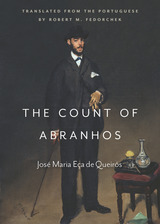 The Count of Abranhos
José Maria Eça de Queriós
Catholic University of America Press, 2020 José Maria Eça de Queirós (1845-1900) was a Portuguese author in the realist style, whose work has been translated into 20 languages. The Count of Abranhos was published posthumously, and this is the first time it has been translated into English.
Alípio Severo Abranhos, born to poor parents in a small town in the north of Portugal, goes off to spend his boyhood and adolescence with an aunt whose material well-being constitutes, for him, the lap of luxury. And he likes and becomes accustomed to luxury. As he follows a course of study for his bacharel at the University of Coimbra, certain negative character traits come to the fore, and upon completion of his degree he leaves behind a pregnant maid to take up residence in Lisbon. In the capital, he calculates—as a young man with neither position, nor fortune, nor social standing—how to get ahead in life. And the path is through marriage to a young woman of social status and promise of a sizable dowry, both of which can facilitate his rise in politics and government. Alípio’s weapons, his means, are various modes of hypocrisy—social hypocrisy, religious hypocrisy, filial hypocrisy, and political hypocrisy, with dishonesty, cowardice, and a farcical duel thrown in for good measure. Eça, like all accomplished novelists, does not tell us what Alípio becomes, rather he lets us see what he becomes, for with his unerring sense of satire, of character portrayal, and plot movement he lets the Count of Abranhos, with his steps and missteps, inform us himself of what he becomes. And with his actions, Alípio Severo Abranhos emerges as the personification, the very epitome, of the grim state of politics in nineteenth-century Portugal, a state engendered by the dogged pursuit of power. And through the obsequious eyes of Alípio’s biographer and the sycophantic hangers-on who wish to glory in his orbit, readers have a clear picture of the “great” man—a type who exhibits universal characteristics not confined to Eça de Queirós’s native country, nor to his time.
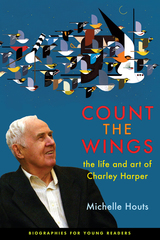 Count the Wings: The Life and Art of Charley Harper
Michelle Houts
Ohio University Press, 2018 When you look at a bird, do you see feathers and a beak? Or do you see circles and triangles? Artist Charley Harper spent his life reducing subjects to their simplest forms, their basic lines and shapes. This resulted in what he called minimal realism and the style that would become easily recognized as Charley Harper’s. Art fans and nature lovers around the world fell in love with Harper’s paintings, which often featured bright colors and intriguing nature subjects. Harper’s love of painting and drawing led him from the hills of West Virginia to the bombed-out villages of Europe, to the streets of New York City, and to the halls of the Art Academy of Cincinnati. How did the farm boy who didn’t know a single artist become one of America’s most recognized midcentury modern painters? The answer is simple. He did it by counting the wings. Count the Wings is the first book for middle-grade readers about Harper’s life and work. Author Michelle Houts worked closely with the Harper estate to include full-color illustrations, plentiful supplemental materials, and discussion questions that will intrigue and engage young readers. Count the Wings is part of our acclaimed Biographies for Young Readers series, which brings smart, expertly researched books about often overlooked but exceptional individuals to school-age readers.
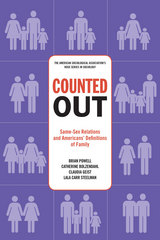 Counted Out: Same-Sex Relations and Americans' Definitions of Family
Brian Powell
Russell Sage Foundation, 2011 When state voters passed the California Marriage Protection Act (Proposition 8) in 2008, it restricted the definition of marriage to a legal union between a man and a woman. The act's passage further agitated an already roiling national debate about whether American notions of family could or should expand to include, for example, same-sex marriage, unmarried cohabitation, and gay adoption. But how do Americans really define family? The first study to explore this largely overlooked question, Counted Out examines currents in public opinion to assess their policy implications and predict how Americans' definitions of family may change in the future. Counted Out broadens the scope of previous studies by moving beyond efforts to understand how Americans view their own families to examine the way Americans characterize the concept of family in general. The book reports on and analyzes the results of the authors' Constructing the Family Surveys (2003 and 2006), which asked more than 1,500 people to explain their stances on a broad range of issues, including gay marriage and adoption, single parenthood, the influence of biological and social factors in child development, religious ideology, and the legal rights of unmarried partners. Not surprisingly, the authors find that the standard bearer for public conceptions of family continues to be a married, heterosexual couple with children. More than half of Americans also consider same-sex couples with children as family, and from 2003 to 2006 the percentages of those who believe so increased significantly—up 6 percent for lesbian couples and 5 percent for gay couples. The presence of children in any living arrangement meets with a notable degree of public approval. Less than 30 percent of Americans view heterosexual cohabitating couples without children as family, while similar couples with children count as family for nearly 80 percent. Counted Out shows that for most Americans, however, the boundaries around what they define as family are becoming more malleable with time. Counted Out demonstrates that American definitions of family are becoming more expansive. Who counts as family has far-reaching implications for policy, including health insurance coverage, end-of-life decisions, estate rights, and child custody. Public opinion matters. As lawmakers consider the future of family policy, they will want to consider the evolution in American opinion represented in this groundbreaking book. A Volume in the American Sociological Association's Rose Series in Sociology
Counter Cultures: Saleswomen, Managers, and Customers in American Department Stores, 1890-1940
Susan Porter Benson
University of Illinois Press, 1986 The luxurious appearance and handsome profits of American department stores from 1890 to 1940 masked a three-way struggle among saleswomen, managers, and customers for control of the selling floor. Counter Cultures explores the complex nature and contradictions of the conflict in an arena where class, gender, and the emerging culture of consumption all came together. The result is a fascinating illumination of the emotional labor of the workplace and the work-culture of consumerism that still defines the workday for millions of Americans.
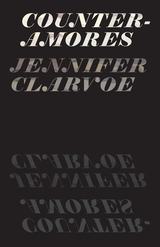 Counter-Amores
Jennifer Clarvoe
University of Chicago Press, 2011 Jennifer Clarvoe’s second book, Counter-Amores, wrestles with and against love. The poems in the title series talk back to Ovid’s Amores, and, in talking back, take charge, take delight, and take revenge. They suggest that we discover what we love by fighting, by bringing our angry, hungry, imperfect selves into the battle. Like a man who shouts for the echo back from a cliff, or the scientist who teaches her parrot to say, “I love you,” or the philosopher who wonders what it is like to be a bat, or Temple Grandin’s lucid imaginings of the last moments of cattle destined for slaughter, the speakers in these poems seek to find themselves in relation to an ever-widening circle of unknowable others. Yearning for “the sweet cool hum of fridge and fluorescent that sang ‘home,’” we’re as likely to find “fifty-seven clicks and flickering channels pitched to the galaxy.” Song itself becomes a site for gorgeous struggle, just as bella means both “beautiful” and “wars.”
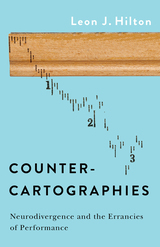 Counter-cartographies: Neurodivergence and the Errancies of Performance
Leon J. Hilton
University of Minnesota Press, 2025 How to remake the world with neurodivergence at its heart
What if we embraced neurodivergent ways of being not as deviations to be corrected but as vital ways of inhabiting the world? What new realities might emerge? Bringing a much-needed humanistic perspective to the study of autism and other forms of neurodivergence, Counter-cartographies offers a bold reimagining of neurological difference, moving beyond rigid diagnostic frameworks to uncover more expansive, generative modes of existence.
Engaging the work of Fernand Deligny to trace how modern taxonomies of neurodivergence have hardened over time, Leon J. Hilton questions how these categories might instead serve as tools for remapping the world with neurodivergence at its center. At the heart of Counter-cartographies is an exploration of performance and performativity that reveals how the norm of neurotypical reality is continually reinforced through acts of doing, redoing, and undoing. Charting the historical shift away from “mind” and toward “brain” and moving fluidly across disciplines—from digital art and documentary cinema to cybernetics and radical mental health movements—Hilton illuminates the deep interconnections between performance, perception, and the historical construction of the “neurotypical.” Through close readings of works by William Pope.L, Mel Baggs, Wu Tsang, and others, Hilton also examines how neurodivergence has been represented, embodied, and materialized in contemporary art and media. Restless, engrossing, and persistently attuned to moments of rupture when the neurotypical order falters, Counter-cartographies charts a path toward a more capacious, imaginative world. Retail e-book files for this title are screen-reader friendly with images accompanied by short alt text and/or extended descriptions.
 Counter-Colonial Criminology: A Critique of Imperialist Reason
Biko Agozino
Pluto Press, 2003 This book is about how the history of colonialism has shaped the definition of crime and justice systems not only in former colonies but also in colonialist countries. Biko Agozino argues that criminology in the West was originally tested in the colonies and then brought back to mother countries -- in this way, he claims, the colonial experience has been instrumental in shaping modern criminology in colonial powers.
He looks at how radical critiques of mainstream criminology by critical feminist and postmodernist thinkers contribute to an understanding of the relationship between colonial experience and criminology. But he also shows that even critical feminist and postmodernist assessments of conventional criminology do not go far enough as they remain virtually silent on colonial issues.
Biko Agozino considers African and other postcolonial literature and contributions to counter colonial criminology, their originality, relevance and limitations. Finally he advocates a “committed objectivity” approach to race-class-gender criminology investigations in order to come to terms with imperialistic and neo-colonialist criminology.
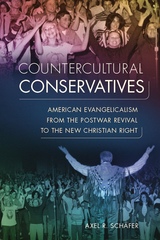 Countercultural Conservatives: American Evangelicalism from the Postwar Revival to the New Christian Right
Axel R. Schäfer
University of Wisconsin Press, 2012 In the mid-twentieth century, far more evangelicals supported such “liberal” causes as peace, social justice, and environmental protection. Only gradually did the conservative evangelical faction win dominance, allying with the Republican Party of Ronald Reagan and, eventually, George W. Bush.
In Countercultural Conservatives Axel Schäfer traces the evolution of a diffuse and pluralistic movement into the political force of the New Christian Right. In forging its complex theological and political identity, evangelicalism did not simply reject the ideas of 1960s counterculture, Schäfer argues. For all their strict Biblicism and uncompromising morality, evangelicals absorbed and extended key aspects of the countercultural worldview.
Carefully examining evangelicalism’s internal dynamics, fissures, and coalitions, this book offers an intriguing reinterpretation of the most important development in American religion and politics since World War II.
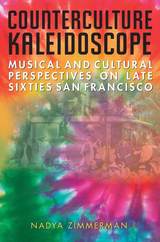 Counterculture Kaleidoscope: Musical and Cultural Perspectives on Late Sixties San Francisco
Nadya Zimmerman
University of Michigan Press, 2013 Forty years after the fact, 1960s counterculture---personified by hippies, protest, and the Summer of Love---basks in a nostalgic glow in the popular imagination as a turning point in modern American history and the end of the age of innocence. Yet, while the era has come to be synonymous with rebellion and opposition, its truth is much more complex. In a bold reconsideration of the late sixties San Francisco counterculture movement, Counterculture Kaleidoscope takes a close look at the cultural and musical practices of that era. Addressing the conventional wisdom that the movement was grounded in rebellion and opposition, the book exposes two myths: first, that the counterculture was an organized social and political movement of progressives with a shared agenda who opposed the mainstream (dubbed "hippies"); and second, that the counterculture was an innocent entity hijacked by commercialism and transformed over time into a vehicle of so-called "hip consumerism." Seeking an alternative to the now common narrative, Nadya Zimmerman examines primary source material including music, artwork, popular literature, personal narratives, and firsthand historical accounts. She reveals that the San Francisco counterculture wasn't interested in commitments to causes and made no association with divisive issues---that it embraced everything in general and nothing in particular. "Astute and accessible, Counterculture Kaleidoscope provides thought-provoking insights into the historical, cultural and social context of the San Francisco counter-culture and its music scene, including discussions of Vietnam and student protest, the Haight-Ashbury Diggers, the Grateful Dead, Led Zeppelin, Altamont, and Charlie Manson. A must for students and scholars of socio-musical activity and for all of us to whom music matters."
---Sheila Whiteley, author of The Space Between the Notes: Rock and the Counter-Culture and Too Much Too Young: Popular Music, Age and Gender "The hippie counterculture has never garnered the scholarly attention accorded the new left and the black freedom struggle. Overviews of the period ritualistically mention it as part and parcel of that apparently incandescent era---the Sixties---but rarely capture its distinctiveness. Counterculture Kaleidoscope is a timely and provocative intervention in Sixties scholarship that significantly deepens our understanding of this important but understudied phenomenon."
—Alice Echols, Associate Professor, University of Southern California, and author of Scars of Sweet Paradise: The Life and Times of Janis Joplin
 Counter-Diaspora: The Greek Second Generation Returns “Home”
Anastasia Christou and Russell King
Harvard University Press, 2014 This book focuses on the return of the diasporic Greek second generation to Greece, primarily in the first decade of the twenty-first century, and their evolving, often ambivalent, senses of belonging and conceptualizations of “home.” Drawing from a large-scale research project employing a multi-sited and multi-method comparative approach, Counter-Diaspora is a narrative ethnographic account of the lives and identities of second-generation Greek-Americans and Greek-Germans. Through an interdisciplinary gender and generational lens, the study examines lived migration experiences at three diasporic moments: growing up within the Greek diasporic setting in the United States and Germany; motivations for the counter-diasporic return; and experiences in the “homeland” of Greece. Research documents and analyzes a range of feelings and experiences associated with this “counter-diasporic” return to the ancestral homeland.
Images and imaginations of the “homeland” are discussed and deconstructed, along with notions of “Greekness” mediated through diasporic encounters. Using extensive extracts from interviews, the authors explore the roles of, among other things, family solidarity, kinship, food, language, and religion, as well as the impact of “home-coming” visits on the decision to return to the ancestral “homeland.” The book also contributes to a reconceptualization of diaspora and a problematization of the notion of “second generation.”
The Counterfeit Coin: Videogames and Fantasies of Empowerment
Christopher Goetz
Rutgers University Press, 2023 The Counterfeit Coin argues that games and related entertainment media have become almost inseparable from fantasy. In turn, these media are making fantasy itself visible in new ways. Though apparently asocial and egocentric—an internal mental image expressing the fulfillment of some wish—fantasy has become a key term in social contestations of the emerging medium. At issue is whose fantasies are catered to, who feels powerful and gets their way, and who is left out. This book seeks to undo the monolith of commercial gaming by locating multiplicity and difference within fantasy itself. It introduces and tracks three broad fantasy traditions that dynamically connect apparently distinct strata of a game (story and play), that join games to other media, and that encircle players in pleasurable loops as they follow these connections.
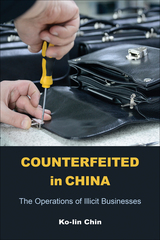 Counterfeited in China: The Operations of Illicit Businesses
Ko-lin Chin
Temple University Press, 2025 Counterfeiting tops the list of organized crimes committed worldwide, raking in nearly half a trillion dollars in 2019. The impact of this illicit business is felt by consumers, brand owners, state authorities, and workers, and it impacts the economy. Moreover, its proliferation has fueled the advancement of organized crime groups.
In his illuminating study, Counterfeited in China, Ko-lin Chin investigates this lucrative industry and its emergence in China. His face-to-face interviews with counterfeiters — business owners, workers, facilitators, and key informants — in the hub of Guangzhou, China reveal how businesses that design, produce, and distribute fake and unauthorized luxury goods manage the risks inherent in their business.
Counterfeited in China examines the individual and group characteristics of counterfeiters and their relationships with organized crime; analyzes the economic aspects of counterfeiting; assesses the relationships among counterfeiting, violence, and corruption; and seeks to understand the demand for counterfeit goods. Chin also discusses the role of Chinese authorities and other parties in the war against counterfeiting.
Assessing the state of the industry and its future, Chin provides fascinating new insights into the modus operandi of counterfeiters.
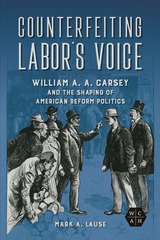 Counterfeiting Labor's Voice: William A. A. Carsey and the Shaping of American Reform Politics
Mark A. Lause
University of Illinois Press, 2024 Confidence man and canny operative, charlatan and manipulator--William A. A. Carsey emerged from the shadow of Tammany Hall to build a career undermining working-class political organizations on behalf of the Democratic Party. Mark A. Lause’s biography of Carsey takes readers inside the bare-knuckle era of Gilded Age politics. An astroturfing trailblazer and master of dirty tricks, Carsey fit perfectly into a Democratic Party that based much of its post-Civil War revival on shattering third parties and gathering up the pieces. Lause provides an in-depth look at Carsey’s tactics and successes against the backdrop of enormous changes in political life. As Carsey used a carefully crafted public persona to burrow into unsuspecting organizations, the forces he represented worked to create a political system that turned voters into disengaged civic consumers and cemented America’s ever-fractious two-party system.
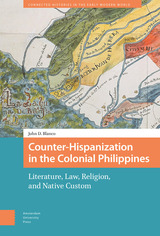 Counter-Hispanization in the Colonial Philippines: Literature, Law, Religion, and Native Custom
John Blanco
Amsterdam University Press, 2023 In Counter-Hispanization in the Colonial Philippines, the author analyzes the literature and politics of “spiritual conquest” in order to demonstrate how it reflected the contribution of religious ministers to a protracted period of social anomie throughout the mission provinces between the 16th-18th centuries. By tracking the prose of spiritual conquest with the history of the mission in official documents, religious correspondence, and public controversies, the author shows how, contrary to the general consensus in Philippine historiography, the literature and pastoral politics of spiritual conquest reinforced the frontier character of the religious provinces outside Manila in the Americas as well as the Philippines, by supplanting the (absence of) law in the name of supplementing or completing it. This frontier character accounts for the modern reinvention of native custom as well as the birth of literature and theater in the Tagalog vernacular.
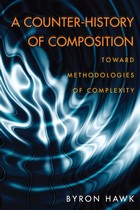 A Counter-History of Composition: Toward Methodologies of Complexity
Byron Hawk
University of Pittsburgh Press, 2007
A Counter-History of Composition contests the foundational disciplinary assumption that vitalism and contemporary rhetoric represent opposing, disconnected poles in the writing tradition. Vitalism has been historically linked to expressivism and concurrently dismissed as innate, intuitive, and unteachable, whereas rhetoric is seen as a rational, teachable method for producing argumentative texts. Counter to this, Byron Hawk identifies vitalism as the ground for producing rhetorical texts-the product of complex material relations rather than the product of chance. Through insightful historical analysis ranging from classical Greek rhetoric to contemporary complexity theory, Hawk defines three forms of vitalism (oppositional, investigative, and complex) and argues for their application in the environments where students write and think today.
Hawk proposes that complex vitalism will prove a useful tool in formulating post-dialectical pedagogies, most notably in the context of emerging digital media. He relates two specific examples of applying complex vitalism in the classroom and calls for the reexamination and reinvention of current self-limiting pedagogies to incorporate vitalism and complexity theory.
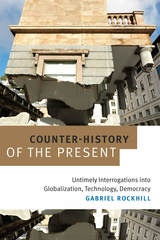 Counter-History of the Present: Untimely Interrogations into Globalization, Technology, Democracy
Gabriel Rockhill
Duke University Press, 2017 In Counter-History of the Present Gabriel Rockhill contests, dismantles, and displaces one of the most widespread understandings of the contemporary world: that we are all living in a democratized and globalized era intimately connected by a single, overarching economic and technological network. Noting how such a narrative fails to account for the experiences of the billions of people who lack economic security, digital access, and real political power, Rockhill interrogates the ways in which this grand narrative has emerged in the same historical, economic, and cultural context as the fervid expansion of neoliberalism. He also critiques the concurrent valorization of democracy, which is often used to justify U.S. military interventions on the behalf of capital. Developing an alternative account of the current conjuncture that acknowledges the plurality of lived experiences around the globe and in different social strata, he shifts the foundations upon which debates about the contemporary world can be staged. Rockhill's counter-history thereby offers a new grammar for historical narratives, creating space for the articulation of futures no longer engulfed in the perpetuation of the present.
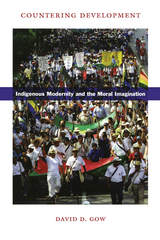 Countering Development: Indigenous Modernity and the Moral Imagination
David D. Gow
Duke University Press, 2008 Cauca, located in southwestern Colombia and home to the largest indigenous population in the country, is renowned as a site of indigenous mobilization. In 1994, following a destructive earthquake, many families in Cauca were forced to leave their communities of origin and relocate to other areas within the province where the state provided them with land and housing. Noting that disasters offer communities the opportunity to remake themselves and their priorities, David D. Gow examines how three different communities established after the earthquake wrestled with conflicting visions of development. He shows how they each countered traditional notions of development by moving beyond a myopic obsession with poverty alleviation to demand that Colombia become more inclusive and treat all of its people as citizens with full rights and responsibilities. Through ethnographic fieldwork conducted annually in Cauca from 1995 through 2002, Gow compares the development plans of the three communities, looking at both the planning processes and the plans themselves. In so doing, he demonstrates that there is no single indigenous approach to development and modernity. He describes differences in how each community defined and employed the concept of culture, how they connected a concern with culture to economic and political reconstruction, and how they sought to assert their own priorities while engaging with the existing development resources at their disposal. Ultimately, Gow argues that the moral vision advanced by the indigenous movement, combined with the growing importance attached to human rights, offers a fruitful way to think about development: less as a process of integration into a rigidly defined modernity than as a critical modernity based on a radical politics of inclusive citizenship.
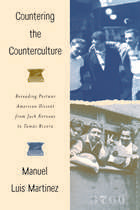 Countering the Counterculture: Rereading Postwar American Dissent from Jack Kerouac to Tomás Rivera
Manuel Luis Martinez
University of Wisconsin Press, 2003 Rebelling against bourgeois vacuity and taking their countercultural critique on the road, the Beat writers and artists have long symbolized a spirit of freedom and radical democracy. Manuel Martinez offers an eye-opening challenge to this characterization of the Beats, juxtaposing them against Chicano nationalists like Raul Salinas, Jose Montoya, Luis Valdez, and Oscar Acosta and Mexican migrant writers in the United States, like Tomas Rivera and Ernesto Galarza.
In an innovative rereading of American radical politics and culture of the 1950s and 1960s, Martinez uncovers reactionary, neoromantic, and sometimes racist strains in the Beats’ vision of freedom, and he brings to the fore the complex stances of Latinos on participant democracy and progressive culture. He analyzes the ways that Beats, Chicanos, and migrant writers conceived of and articulated social and political perspectives. He contends that both the Beats’ extreme individualism and the Chicano nationalists’ narrow vision of citizenship are betrayals of the democratic ideal, but that the migrant writers presented a distinctly radical and inclusive vision of democracy that was truly countercultural.
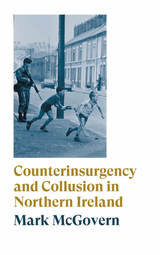 Counterinsurgency and Collusion in Northern Ireland
Mark McGovern
Pluto Press, 2019 Collusion by British state forces in killings perpetrated by loyalist paramilitaries was a dubious hallmark of the ‘dirty war’ in the north of Ireland. Now, more than twenty years since the Good Friday Agreement, the story of collusion remains one of the most enduring and contentious legacies of the conflict, a shadow that trails British counterinsurgency to this day.
Here Mark McGovern turns back the clock to the late 1980s and early ‘90s—the ‘endgame’ of the Troubles and a period defined by a rash of state-sanctioned paramilitary killings. Drawing on previously unpublished evidence, and original testimony of victims’ families and eyewitnesses, McGovern examines several dozen killings of republicans and their families and communities that took place in the Mid-Ulster area. Placing these accounts within a wider critical analysis of the nature of British counterinsurgency and the state use of agents and informers, McGovern paints a damning picture of covert, deniable, and unlawful violence.
 Counterinsurgency Wars and the Anglo-American Alliance: The Special Relationship on the Rocks
Andrew Mumford
Georgetown University Press Andrew Mumford challenges the notion of a “special relationship” between the United States and United Kingdom in diplomatic and military affairs, the most vaunted and, he says, exaggerated of associations in the post-1945 era. Though they are allies to be sure, national self-interest and domestic politics have often undercut their relationship. This is the first book to combine a history of US-UK interaction during major counterinsurgency campaigns since 1945, from Palestine to Iraq and Afghanistan, with a critical examination of the so called special relationship that has been tested during these difficult, protracted, and costly conflicts. Mumford’s assessment of each nation’s internal political discussions and diplomatic exchanges reveals that in actuality there is only a thin layer of specialness at work in the wars that shaped the postcolonial balance of power, the fight against Communism in the Cold War, and the twenty-first-century “war on terror.” This book is especially timely given that the US-UK relationship is once again under scrutiny because of the Trump administration’s “America First” rhetoric and Britain's changing international relations as a result of Brexit. Counterinsurgency Wars and the Anglo-American Alliance will interest scholars and students of history, international relations, and security studies as well as policy practitioners in the field.
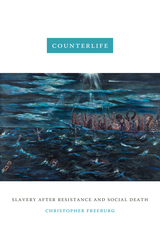 Counterlife: Slavery after Resistance and Social Death
Christopher Freeburg
Duke University Press, 2021 In Counterlife Christopher Freeburg poses a question to contemporary studies of slavery and its aftereffects: what if freedom, agency, and domination weren't the overarching terms used for thinking about Black life? In pursuit of this question, Freeburg submits that current scholarship is too preoccupied with demonstrating enslaved Africans' acts of political resistance, and instead he considers Black social life beyond such concepts. He examines a rich array of cultural texts that depict slavery—from works by Frederick Douglass, Radcliffe Bailey, and Edward Jones to spirituals, the television cartoon The Boondocks, and Quentin Tarantino's Django Unchained—to show how enslaved Africans created meaning through artistic creativity, religious practice, and historical awareness both separate from and alongside concerns about freedom. By arguing for the impossibility of tracing slave subjects solely through their pursuits of freedom, Freeburg reminds readers of the arresting power and beauty that the enigmas of Black social life contain.
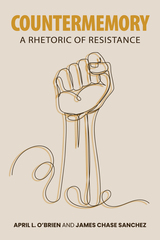 Countermemory: A Rhetoric of Resistance
April L. O'Brien and James Chase Sanchez
University of Alabama Press, 2025 Investigates the interdisciplinary dimensions of countermemory through a rhetorical lens Countermemory: A Rhetoric of Resistance by April L. O’Brien and James Chase Sanchez is a groundbreaking monograph that explores the concept of countermemory from an interdisciplinary and rhetorical perspective. The authors define “countermemory” as remembrance that resituates often overlooked or erased narratives of marginalized groups by positioning these memories as equally significant to dominant historical narratives. This work investigates how countermemories emerge in response to public memories, highlighting the tensions and resistance that arise when marginalized voices challenge mainstream historical accounts. Through a mixed-methodological approach—incorporating site-based analysis, participant observation, textual analysis, and historiography—O’Brien and Sanchez examine countermemory in both physical and digital spaces. From memorial sites and museums to music videos, TV shows, and digital maps, they reveal the various ways countermemory operates and persists. The authors focus particularly on countermemory in the American South, centering on the experiences and histories of Black, Latinx, and Indigenous communities. Countermemory is essential reading for scholars and students of rhetoric and public memory. The book also offers rich insights to readers who are passionate about addressing issues of racial inequality, people interested in examining their own experiences and the role they can play in promoting social change, and those interested in exploring the ways in which history is constructed and presented, and how marginalized perspectives are often excluded or distorted.
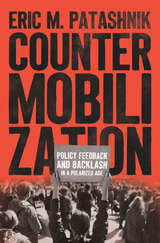 Countermobilization: Policy Feedback and Backlash in a Polarized Age
Eric M. Patashnik
University of Chicago Press, 2023 An essential look at how and why backlash movements are inherent to US policymaking. The most successful policies not only solve problems. They also build supportive coalitions. Yet, sometimes, policies trigger backlash and mobilize opposition. Although backlash is not a new phenomenon, today’s political landscape is distinguished by the frequency and pervasiveness of backlash in nearly every area of US policymaking, from abortion rights to the Affordable Care Act. Eric M. Patashnik develops a policy-centered theory of backlash that illuminates how policies stimulate backlashes by imposing losses, overreaching, or challenging existing arrangements to which people are strongly attached. Drawing on case studies of issues from immigration and trade to healthcare and gun control, Countermobilization shows that backlash politics is fueled by polarization, cultural shifts, and negative feedback from the activist government itself. It also offers crucial insights to help identify and navigate backlash risks.
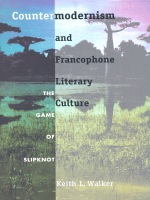 Countermodernism and Francophone Literary Culture: The Game of Slipknot
Keith L. Walker
Duke University Press, 1999 Keith L. Walker traverses the traditionally imposed boundaries of geography and race as he examines the literary culture produced by French speakers and writers born outside France. Focusing on the commonalities revealed in their shared language and colonial history, Walker examines for the first time the work of six writers who, while artistically distinct and geographically scattered, share complex sensibilities regarding their own relationship to France and the French language and, as he demonstrates, produce a counterdiscourse to their colonizers’ modern literary traditions.
Martinique, French Guyana, Senegal, Morocco, and Haiti serve as the stage for the struggle these writers have faced with French language and culture, a struggle influenced by the legacy of Aimé Césaire. In his stand against the modernist principles of Charles Baudelaire, Walker argues, Césaire has become the preeminent francophone countermodernist. A further examination of the relationships between Césaire and the writers Léon Gontron Damas, Mariama Bâ, Tahar Ben Jelloun, Ken Bugul, and Gérard Étienne forms the core of the book and leads to Walker’s characterization of francophone literature as having “slipped the knot,” or escaped the snares of the familiar binary oppositions of modernism. Instead, he discovers in these writers a shared consciousness rooted in an effort to counter and denounce modernist humanist discourse and pointing toward a new subjectivity formed through the negotiation of an alternative modernity.
Countermodernism and Francophone Literary Culture will engage readers interested in French literature and in postcolonial, Caribbean, African, American, and francophone studies.
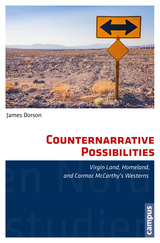 Counternarrative Possibilities: Virgin Land, Homeland, and Cormac McCarthy's Westerns
James Dorson
Campus Verlag, 2016 Counternarrative Possibilities reads Cormac McCarthy’s westerns against the backdrop of American mythology’s two formative national tropes: virgin land (from the 1950s) and homeland (after 9/11). Looking at McCarthy’s westerns in the context of American studies, James Dorson shows how his books counter the national narratives underlying these tropes and reinvest them with new, potentially transformative meaning. Departing from prevailing accounts of McCarthy that place him in relation to his literary antecedents, Counternarrative Possibilities takes a forward-looking approach that reads McCarthy’s work as a key influence on millennial fiction. Weaving together disciplinary history with longstanding debates over the relationship between aesthetics and politics, this book is at once an exploration of the limits of ideology critique in the twenty-first century and a timely, original reconsideration of McCarthy’s work after postmodernism.
Counternetwork: Countering the Expansion of Transnational Criminal Networks
Angel Rabasa
RAND Corporation, 2017 Through an analysis of transnational criminal networks originating in South America, this report presents operational characteristics of these networks, strategic alliances they have established, and the multiple threats that they pose to U.S. interests and to the stability of the countries where they operate. It also identifies U.S. government policies and programs to counter these networks and examines the military’s role in that context.
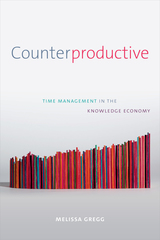 Counterproductive: Time Management in the Knowledge Economy
Melissa Gregg
Duke University Press, 2018 As online distractions increasingly colonize our time, why has productivity become such a vital demonstration of personal and professional competence? When corporate profits are soaring but worker salaries remain stagnant, how does technology exacerbate the demand for ever greater productivity? In Counterproductive Melissa Gregg explores how productivity emerged as a way of thinking about job performance at the turn of the last century and why it remains prominent in the different work worlds of today. Examining historical and archival material alongside popular self-help genres—from housekeeping manuals to bootstrapping business gurus, and the growing interest in productivity and mindfulness software—Gregg shows how a focus on productivity isolates workers from one another and erases their collective efforts to define work limits. Questioning our faith in productivity as the ultimate measure of success, Gregg's novel analysis conveys the futility, pointlessness, and danger of seeking time management as a salve for the always-on workplace.
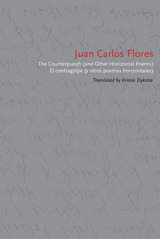 The Counterpunch (and Other Horizontal Poems)/El contragolpe (y otros poemas horizontales)
Juan Carlos Flores
University of Alabama Press, 2016 Alamar, the home of award-winning Cuban poet Juan Carlos Flores, is the setting for his collection, The Counterpunch and Other Horizontal Poems) / El contragolpe (y otros poemas horizontales). Constructed as a self-help community in eastern Havana, Alamar is the largest housing complex in the world. Flores’s highly structured texts, organized into “art galleries,” present prose paintings of a big place in very small form.
Flores builds a poetic landscape with repeating structures that mirror Alamar’s five-floor walkups. Exploring life and dream on the flat surfaces of the poems, he gives fleeting glimpses of perception and survival at the urban margins. As the poet ages, so ages Alamar itself. Yet both find renewal through poetry.
The eighty poems in this bilingual edition offer the first English translation of a complete Flores collection. It will also be of interest to Spanish-language readers seeking access to Cuban literature abroad. Award-winning scholar and translator Kristin Dykstra has compiled an introduction in which she presents Flores, his literary contexts, and references in his poems. Because Flores made specific requests regarding translation, fascinating notes also clarify and expound on choices Dykstra makes in the English version.
A deluxe edition with a handmade, limited-edition color linocut print, including a letterpress-printed poem signed by the author, is available directly from the University of Alabama Press.
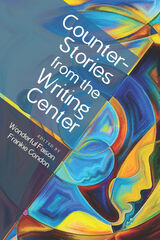 CounterStories from the Writing Center
Frankie Condon
Utah State University Press, 2021 CounterStories from the Writing Center gathers emerging scholars of colour and their white accomplices to challenge some of the most cherished lore about the work of writing centres. Writing within an intersectional feminist frame, this volume’s contributors name and critique the dominant role that white, straight, cis-gendered women have played in writing centre administration as well as in the field of writing centre studies. This work will shake the field’s core assumptions about itself.
Practicing what Derrick Bell has termed “creative truth telling,” these writers are not concerned with individual white women in writing centres but with the social, political, and cultural capital that is the historical birthright of white, straight, cis-gendered women, particularly in writing centre studies. The essays collected in this volume test, defy, and overflow the bounds of traditional academic discourse in the service of powerful testimony, witness, and counterstory.
CounterStories from the Writing Center is a must-read for writing centre directors, scholars, and tutors who are committed to antiracist pedagogy and offers a robust intersectional analysis to those who seek to understand the relationship between the work of writing centres and the problem of racism. Accessible and usable for both graduate and undergraduate students of writing centre theory and practice, this work troubles the field’s commonplaces and offers a rich envisioning of what writing centres materially committed to inclusion and equity might be and do.
Contributors: Dianna Baldwin, Nicole Caswell, Mitzi Ceballos, Romeo Garcia, Neisha-Anne Green, Doug Kern, T. Haltiwanger Morrison, Bernice Olivas, Moira Ozias, Trixie Smith, Willow Trevino
 Counterstreams in Migration: Ethiopians' Choices to Stay, Leave, or Return
Hewan Girma
Temple University Press, 2026 Migration journeys are not unidirectional. In Counterstreams in Migration, Hewan Girma reveals a more complex circuit of migration, concentrating on the motivations behind non-migration, return migration, and repeat migration to show how these flows mutually affect and influence the migrant as well as the family members who remain at home.
Weaving together nearly 100 stories of non-migrants, returnees, and repeat migrants from Ethiopia, Girma advances a theory of migra-emotions, emotions specific to migration, to understand decisions and experiences, such as the imaginary of home and the lived reality of alienation, disaffection abroad, and feelings of duty to one’s homeland.
Looking beyond the meanings of migration or processes of integration, Girma explores the emotional subtext of migration aspirations. In doing so, Counterstreams of Migration complicates conventional understandings of migration and provides a more complete picture of migrant stories.
Counterterrorism and Counterinsurgency in Somalia: Assessing the Campaign Against Al Shabaab
Seth G. Jones
RAND Corporation, 2016 This report analyzes the U.S. and allied campaign against the al Qa’ida–linked terrorist group al Shabaab in Somalia, examines what steps have been most successful against the group, and identifies potential recommendations. It concludes that, while al Shaba'ab was weakened between 2011 and 2016, the group could resurge if urgent steps are not taken to address the political, economic, and governance challenges at the heart of the conflict.
Countertraditions in the Bible: A Feminist Approach
Ilana Pardes
Harvard University Press, 1993 In this eye-opening book, llana Pardes explores the tense dialogue between dominant patriarchal discourses of the Bible and counter female voices. Pardes studies women’s plots and subplots, dreams and pursuits, uncovering the diverse and at times conflicting figurations of femininity in biblical texts. She also sketches the ways in which antipatriarchal elements intermingle with other repressed elements in the Bible: polytheistic traditions, skeptical voices, and erotic longings.
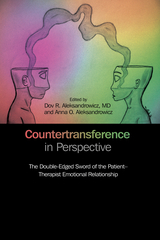 Countertransference in Perspective: The Double-Edged Sword of the Patient-Therapist Emotional Relationship
Edited by Dov R. Aleksandrowicz and Anna O. Aleksandrowicz
Sussex Academic Press, 2022 In psychoanalysis the term countertransference, coined by Freud, describes the complex emotional relation between therapist and patient. The term is nowadays used in a broad sense, referring to the entire range of emotions experienced by the therapist/analyst covering many types of therapeutic process. Today's mental-health practitioners are called upon to deal with a wide variety of challenges, some of them highly emotionally-charged, such as child abuse, gender identity or catastrophic loss. This book comprises three main parts: Part I -- The History of Countertransference; Part II -- The Clinical Challenge and Part III -- The Biological Roots of Counter- transference. After essays in Part I introducing the subject and the history of the concept, as reflected in the classic literature (Kernberg, Heimann, Searles, Balint and Main), Part II presents a range of clinical challenges, analysed by contributor colleagues with extensive experience in these and similar issues. It also addresses Holocaust survivor issues, and child survivor experiences of the Nazi euthanasia programme. The study of counter-transference, like other psychoanalytic issues, has recently become enriched by the striking advances in the study of the living brain and of animal behaviour (the published works of Panksepp, Hoffer). Part III engages with recent findings regarding the biological roots that have implications for the understanding of counter-transference. A Summary to the volume presents the overall conclusions to the findings presented in the three parts. The book is intended for mental health and other human service practitioners, such as physicians, educators, jurists and human resource managers. *** "D. Aleksandrowicz, a training analyst at the Israeli Institute of Psychoanalysis, and A. Aleksandrowicz, a science writer and editor, have edited a fine collection of 13 essays investigating different dimensions of countertransference... Essays cover the terrain well, with a solid historical account of the development of countertransference as a concept, followed by essays exploring the clinical challenges of therapeutic work... A final essay, the best in the collection, examines the moral and social implications of the processes of teaching and relating, captured in the term "cosmopolitan empathy." This book is a welcome addition to the growing literature on empathy, compassion, and human relatedness in general, and is of special value to practitioners and students of psychology and the related human sciences." Recommended! --Choice, Vol. 55, No. 5 January 2018
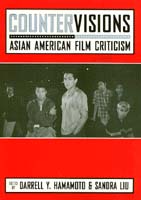 Countervisions
Darrell Hamamoto
Temple University Press, 2000 Spotlighting Asian Americans on both sides of the motion picture camera, Countervisions examines the aesthetics, material circumstances, and politics of a broad spectrum of films released in the last thirty years. This anthology focuses in particular on the growing presence of Asian Americans as makers of independent films and cross-over successes. Essays of film criticism and interviews with film makers emphasize matters of cultural agency -- that is, the practices through which Asian American actors, directors, and audience members have shaped their own cinematic images.
One of the anthology's key contributions is to trace the evolution of Asian American independent film practice over thirty years. Essays on the Japanese American internment and historical memory, essays on films by women and queer artists, and the reflections of individual film makers discuss independent productions as subverting or opposing the conventions of commercial cinema. But Countervisions also resists simplistic readings of "mainstream" film representations of Asian Americans and enumerations of negative images. Writing about Hollywood stars Anna May Wong and Nancy Kwan, director Wayne Wang, and erotic films, several contributors probe into the complex and ambivalent responses of Asian American audiences to stereotypical roles and commercial success. Taken together, the spirited, illuminating essays in this collection offer an unprecedented examination of a flourishing cultural production.
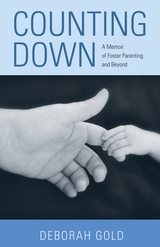 Counting Down: A Memoir of Foster Parenting and Beyond
Deborah Gold
Ohio University Press, 2017 When Deborah Gold and her husband signed up to foster parent in their rural mountain community, they did not foresee that it would lead to a roller-coaster fifteen years of involvement with a traumatized yet resilient birth family. They fell in love with Michael (a toddler when he came to them), yet they had to reckon with the knowledge that he could leave their lives at any time. In Counting Down, Gold tells the story of forging a family within a confounding system. We meet social workers, a birth mother with the courage to give her children the childhood she never had herself, and a father parenting from prison. We also encounter members of a remarkable fellowship of Appalachian foster parents—gay, straight, right, left, evangelical, and atheist—united by love, loss, and quality hand-me-downs. Gold’s memoir is one of the few books to deliver a foster parent’s perspective (and, through Michael’s own poetry and essays, that of a former foster child). In it, she shakes up common assumptions and offers a powerfully frank and hopeful look at an experience often portrayed as bleak.
 Counting Down to Kindergarten: A Complete Guide to Creating a School Readiness Program for Your Community
R. Lynn Baker
American Library Association, 2015 The public library is in the perfect position as a community resource to help bridge the gap between preschool and kindergarten; however, starting from scratch can feel daunting. In this guide, Baker combines her background in early childhood education with her experience as a youth services programming specialist to present a school readiness program that can be tailored for any public library. Based on the successful framework of her tried and tested original program, this book offers everything that a public library needs in order to get started, including - A six-week schedule of detailed lesson plans which combine the best practices of the Every Child Ready to Read® (ECRR) Second Edition (talking, singing, reading, writing, playing) with nationally identified school readiness skills
- A six-month family calendar with activities to help parents engage their children in activities that foster early literacy and school readiness skills at home
- Tips for maintaining a collaborative relationship with early childhood stakeholders and policymakers to help maintain a program that fits the school readiness needs of the local community
- Specific examples of successful school readiness programs and partnerships from public library systems across the country
Baker's guide will help public libraries ensure that young children are ready for school from day one.
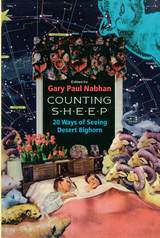 Counting Sheep: Twenty Ways of Seeing Desert Bighorn
Gary Paul Nabhan
University of Arizona Press, 1993 Imagine sending a number of nature writers out into the same unrelenting stretch of Sonoran Desert. Then consider telling them to focus their attention on just one animal—Ovis canadensis, popularly called the desert bighorn or borrego cimarrón—and have them write about it. Have them write from makeshift blinds or from behind a gun barrel. Have them write while walking across the Cabeza Prieta at night, or while flying over it trying to radio-collar the creatures. Have them write from actual sightings of the animals or simply from their tracks and droppings. What would result from such an exercise is Counting Sheep, an unusual anthology that demonstrates the range of possibilities in nature writing. While ostensibly a collection of writings about these desert sheep that live along the U.S.-Mexico border, it also represents an attempt to broaden the scope of the natural history essay. Writers trained in a wide range of disciplines spanning the natural and social sciences here offer a similarly diverse collection of writings, with women's, Hispanic, and Native American views complementing those in a genre long dominated by Anglo men. The four sections of the anthology comprise pre-Anglo-American tradition, examples of early nature writing, varied responses by modern writers to actually counting sheep, and a selection of essays that place bighorns in the context of the larger world. Counting Sheep celebrates the diversity of cultural responses to this single animal species in its Sonoran Desert habitat and invites readers to change the way in which they view their relationship to wild creatures everywhere. It also shows how nature writers can delight us all by the varied ways in which they practice their craft.
Contributors:
Charles Bowden
David E. Brown
Bill Broyles
Julian Hayden
William T. Hornaday
Paul Krausman
Danny Lopez
Eric Mellink
Mauricio Mixco
Gale Monson
Gary Paul Nabhan
Doug Peacock
Kermit Roosevelt
Harley G. Shaw
Charles Sheldon
Peter Steinhart
Anita Alvarez de Williams
Terry Tempest Williams
Ann Zwinger
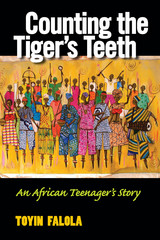 Counting the Tiger's Teeth: An African Teenager's Story
Toyin Falola
University of Michigan Press, 2016 Counting the Tiger’s Teeth narrates a crucial turning point in Nigerian history, the Agbekoya rebellion (“Peasants Reject Poverty”) of 1968-70, as chronicled by Toyin Falola, reflecting on his firsthand experiences as a teenage witness to history. Falola, the foremost scholar of Africa of this generation, illuminates the complex factors that led to this armed conflict and details the unfolding of major events and maneuvers. The narrative provides unprecedented, even poetic, access to the social fabric and dynamic cosmology of the farming communities in rebellion as they confronted the modernizing state. The postcolonial government exercised new modes of power that corrupted or neglected traditional forms of authority, ignoring urgent pleas for justice and fairness by the citizenry. What emerges, as the rural communities organized for and executed the war, is a profound story of traditional culture’s ingenuity and strength in this epic struggle over the future direction of a nation. Falola reveals the rebellion’s ambivalent legacy, the uncertainties of which inform even the present historical moment. Like Falola’s prizewinning previous memoir, A Mouth Sweeter Than Salt, this engagingly written book performs the essential service of providing a way of walking with ancestors, remembering the dead, reminding the living, and converting orality into a permanent text.
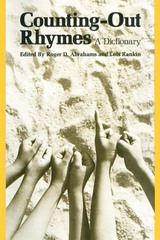 Counting-Out Rhymes: A Dictionary
Edited by Roger D. Abrahams and Lois Rankin
University of Texas Press, 1980 Eeny, meeny, figgledy, fig.
Delia, dolia, dominig,
Ozy, pozy doma-nozy,
Tee, tau, tut,
Uggeldy, buggedy, boo!
Out goes you. (no. 129) You can stand,
And you can sit,
But, if you play,
You must be it. (no. 577) Counting-out rhymes are used by children between the ages of six and eleven as a special way of choosing it and beginning play. They may be short and simple ("O-U-T spells out/And out goes you") or relatively long and complicated; they may be composed of ordinary words, arrant nonsense, or a mixture of the two. Roger D. Abrahams and Lois Rankin have gathered together a definitive compendium of counting-out rhymes in English reported to 1980. These they discovered in over two hundred sources from the nineteenth and twentieth centuries, including rhymes from England, Scotland, Ireland, Australia, New Zealand, and the United States. Representative texts are given for 582 separate rhymes, with a comprehensive listing of sources and variants for each one, as well as information on each rhyme's provenience, date, and use. Cross-references are provided for variants whose first lines differ from those of the representative texts. Abrahams's introduction discusses the significance of counting-out rhymes in children's play. Children's folklore and speech play have attracted increasing attention in recent years. Counting-Out Rhymes will be a valuable resource for researchers in this field.
 Country and Midwestern: Chicago in the History of Country Music and the Folk Revival
Mark Guarino
University of Chicago Press, 2023 The untold story of Chicago’s pivotal role as a country and folk music capital.
Chicago is revered as a musical breeding ground, having launched major figures like blues legend Muddy Waters, gospel soul icon Mavis Staples, hip-hop firebrand Kanye West, and the jazz-rock band that shares its name with the city. Far less known, however, is the vital role Chicago played in the rise of prewar country music, the folk revival of the 1950s and 1960s, and the contemporary offspring of those scenes.
In Country and Midwestern, veteran journalist Mark Guarino tells the epic century-long story of Chicago’s influence on sounds typically associated with regions further south. Drawing on hundreds of interviews and deep archival research, Guarino tells a forgotten story of music, migration, and the ways that rural culture infiltrated urban communities through the radio, the automobile, and the railroad. The Midwest’s biggest city was the place where rural transplants could reinvent themselves and shape their music for the new commercial possibilities the city offered. Years before Nashville emerged as the commercial and spiritual center of country music, major record labels made Chicago their home and recorded legendary figures like Bill Monroe, The Carter Family, and Gene Autry. The National Barn Dance—broadcast from the city’s South Loop starting in 1924—flourished for two decades as the premier country radio show before the Grand Ole Opry. Guarino chronicles the makeshift niche scenes like “Hillbilly Heaven” in Uptown, where thousands of relocated Southerners created their own hardscrabble honky-tonk subculture, as well as the 1960s rise of the Old Town School of Folk Music, which eventually brought national attention to local luminaries like John Prine and Steve Goodman. The story continues through the end of the twentieth century and into the present day, where artists like Jon Langford, The Handsome Family, and Wilco meld contemporary experimentation with country traditions.
Featuring a foreword from Grammy-nominated singer-songwriter Robbie Fulks and casting a cross-genre net that stretches from Bob Dylan to punk rock, Country and Midwestern rediscovers a history as sprawling as the Windy City—celebrating the creative spirit that modernized American folk idioms, the colorful characters who took them into new terrain, and the music itself, which is still kicking down doors even today.
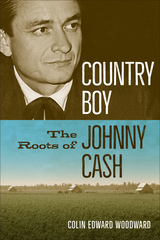 Country Boy: The Roots of Johnny Cash
Colin Edward Woodward
University of Arkansas Press, 2022 Winner, 2023 J. G. Ragsdale Book Award from the Arkansas Historical Association Because Johnny Cash cut his classic singles at Sun Records in Memphis and reigned for years as country royalty from his Nashville-area mansion, people tend to associate the Man in Black with Tennessee. But some of Cash’s best songs—including classics like “Pickin’ Time,” “Big River,” and “Five Feet High and Rising”—sprang from his youth in the sweltering cotton fields of northeastern Arkansas. In Country Boy, Colin Woodward combines biography, history, and music criticism to illustrate how Cash’s experiences in Arkansas shaped his life and work. The grip of the Great Depression on Arkansas’s small farmers, the comforts and tragedies of family, and a bedrock of faith all lent his music the power and authenticity that so appealed to millions. Though Cash left Arkansas as an eighteen-year-old, he often returned to his home state, where he played some of his most memorable and personal concerts. Drawing upon the country legend’s songs and writings, as well as the accounts of family, fellow musicians, and chroniclers, Woodward reveals how the profound sincerity and empathy so central to Cash’s music depended on his maintaining a deep connection to his native Arkansas—a place that never left his soul.
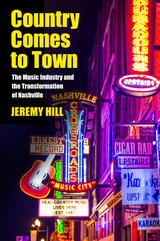 Country Comes to Town: The Music Industry and the Transformation of Nashville
Jeremy Hill
University of Massachusetts Press, 2016 Country music evokes a simple, agrarian past, with images of open land and pickup trucks. While some might think of the genre as a repository of nostalgia, popular because it preserves and reveres traditional values, Jeremy Hill argues that country music has found such expansive success because its songs and its people have forcefully addressed social and cultural issues as well as geographic change. Hill demonstrates how the genre and its fans developed a flexible idea of “country,” beyond their rural roots, and how this flexibility allowed fans and music to “come to town,” to move into and within urban spaces, while retaining a country “character.” To understand how the genre has become the far-reaching commercial phenomenon that it is today, Hill explores how various players within the country music fold have grappled with the notion of place. He shows both how the industry has transformed the city of Nashville and how country music—through song lyrics, imagery associated with the music, and branding—has reshaped ideas about the American landscape and character. As the genre underwent significant change in the last decades of the twentieth century, those who sought to explain its new styles and new locations relied on a traditional theme: “You can take the boy out of the country, but you can’t take the country out of the boy.” Hill demonstrates how this idea—that you can still be “country” while no longer living in a rural place—has been used to expand country’s commercial appeal and establish a permanent home in the urban space of Nashville.
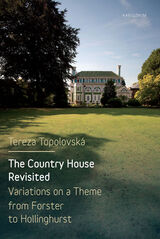 The Country House Revisited: Variations on a Theme from Forster to Hollinghurst
Tereza Topolovská
Karolinum Press, 2017 From Howard’s End to Brideshead Revisited, this book explores the leitmotif of the English country house in twentieth- and twenty-first-century fiction, with a focus on the works of E. M. Forster, Evelyn Waugh, Iris Murdoch, Alan Hollinghurst, and Sarah Waters. Integrating wider social and cultural contexts with contemporary architectural developments, Tereza Topolovská reveals that the variety of literary depictions of the country house reflects the physical diversification of buildings that can be classified as such, from smaller variants to formerly grand residences on the brink of physical collapse. Within the scope of contemporary fiction, architecture, and poetics of space, the country house—with its uniquely integrating and exceptionally evocative qualities—accentuates different conceptions of dwelling. Consequently, literary portrayals of the country house can be seen as both prefiguring and reflecting the contemporary practice of living.
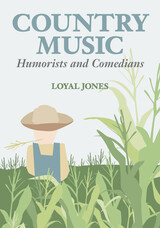 Country Music Humorists and Comedians
Loyal Jones
University of Illinois Press, 2008 Q: Is he afraid of work? A: No, he can lie down beside it and go to sleep. This volume is an encyclopedia of the many country music performers who made comedy a central part of their careers. Loyal Jones offers an informative biographical sketch of each performer and many entries include a sample of the artist's humor, a recording history, and amusing anecdotal tidbits. Starting with vaudeville and radio barn dance figures like the Skillet Lickers and the Weaver Brothers and Elviry, Jones moves on to the regulars on Hee Haw and the Grand Old Opry and present-day comedians from the Austin Lounge Lizards to Jeff Foxworthy. Jones's introductory essay discusses such topics as stock comic figures, venues for comedic performance, and benchmark performers. Throughout the volume, he places each performer squarely in the context of the country music community, its performing traditions, and each artist's place in the larger cultural milieu.
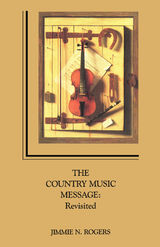 Country Music Message: Revisited
Jimmie Rogers
University of Arkansas Press, 1988 The Country Music Message: Revisited is more than a history of commercial country music, a discussion of the performers, or a compilation of song lyrics. It is an examination of the way the “message” in country songs is relayed and received: why the songs move us as they do. As Jimmie Rogers saying in his preface, “A country song is a special form of communication——communication that more closely resembles interpersonal or face-to-face interaction between two people than do other types of mass appeal music. This close bond that exists between audience and performers, as well as the unique treatment of the song topics, helps to make the music, the performers, and the audience special. After the characteristics are reviewed, observations are made about the audience that accepts and approves these messages. The topics, and the approach to those topics by the songwriter and by the singers, tell us much about the audience that chose to listen to country music.” If you are already a fan of country music, this book will provide insights into a process you’ve probably taken for granted. If you are a newcomer, you will better understand and appreciate the music that a “few folks are performing for a large number of people.”
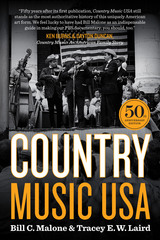 Country Music USA: 50th Anniversary Edition
By Bill C. Malone and Tracey E. W. Laird
University of Texas Press, 2018 “Fifty years after its first publication, Country Music USA still stands as the most authoritative history of this uniquely American art form. Here are the stories of the people who made country music into such an integral part of our nation’s culture. We feel lucky to have had Bill Malone as an indispensable guide in making our PBS documentary; you should, too.”
—Ken Burns and Dayton Duncan, Country Music: An American Family Story From reviews of previous editions: “Considered the definitive history of American country music.”
—Los Angeles Times “If anyone knows more about the subject than [Malone] does, God help them.”
—Larry McMurtry, from In a Narrow Grave “With Country Music USA, Bill Malone wrote the Bible for country music history and scholarship. This groundbreaking work, now updated, is the definitive chronicle of the sweeping drama of the country music experience.”
—Chet Flippo, former editorial director, CMT: Country Music Television and CMT.com “Country Music USA is the definitive history of country music and of the artists who shaped its fascinating worlds.”
—William Ferris, University of North Carolina at Chapel Hill, former chairman of the National Endowment for the Humanities and coeditor of the Encyclopedia of Southern Culture Since its first publication in 1968, Bill C. Malone’s Country Music USA has won universal acclaim as the definitive history of American country music. Starting with the music’s folk roots in the rural South, it traces country music from the early days of radio into the twenty-first century. In this fiftieth-anniversary edition, Malone, the featured historian in Ken Burns’s 2019 documentary on country music, has revised every chapter to offer new information and fresh insights. Coauthor Tracey Laird tracks developments in country music in the new millennium, exploring the relationship between the current music scene and the traditions from which it emerged.
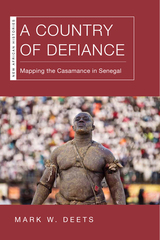 A Country of Defiance: Mapping the Casamance in Senegal
Mark W. Deets
Ohio University Press, 2023 A historiographical analysis of human geography and a social history of nationalist separatism and cultural identity in southern Senegal. This book is a spatial history of the conflict in Casamance, the portion of Senegal located south of The Gambia. Mark W. Deets traces the origins of the conflict back to the start of the colonial period in a select group of contested spaces and places where the seeds of nationalism and separatism took root. Each chapter examines the development of a different piece of the still unrealized Casamançais nation: river, rice field, forest, school, and stadium. Each of these locations forms a spatial discourse of grievance that transformed space into place, rendering a separatist nation from the pieces where a particular Casamançais identity emerged. However, not every Casamançais identified with these spaces and places in the same way. Many refused to tie their beloved culture and landscape to the project of separatism, revealing a layer of counter-mapping below that of the separatist leaders like Father Augustin Diamacoune Senghor and Mamadou “Nkrumah” Sané. The Casamance conflict began on December 26, 1982. After an oath-taking ceremony in a sacred forest on the edge of Ziguinchor, hundreds of separatists from the Movement of Democratic Forces of the Casamance (MFDC) marched into the town to remove the Senegalese flag in front of the regional governor’s office and replace it with a white flag. The marchers were met by gendarmes who quickly found themselves outnumbered. Government surveillance, arrests, and interrogations followed into the next year, when gendarmes went to the sacred forest to stop another MFDC meeting. This time, the separatists greeted the gendarmes with a burst of violence that left four dead, their bodies mutilated. Senegalese security responded with force, driving the separatists—armed only with improvised rifles, bows and arrows, and machetes—into the forest. The Casamance conflict continues to the present day, so far having left more than five thousand dead, four hundred killed or maimed by land mines, and another eight hundred thousand living in a state of insecurity, with limited possibility for economic development. Ordinary Casamançais—on the Casamance River, in the rice fields, in the forests, in the schools, and in the sports stadiums—have demonstrated a diversity of opinions about the separatist project. Whether by the Senegalese state or by the separatists, these ordinary Casamançais have refused to be mapped. They have made the Casamance “a country of defiance.”
Country of Glass: Poems
Sarah Katz
Gallaudet University Press, 2022 Country of Glass is the debut poetry collection from Sarah Katz, who offers an exploration of the concept of precariousness as it applies to bodies, families, countries, and whole societies. Katz employs themes of illness, disability, war, and survival within the contexts of family history and global historical events. The collection moves through questions about identity, storytelling, displacement, and trauma, constructing an overall narrative about what it means to love while trying to survive. The poems in this book—which take the form of free verse, prose poems, sestinas, and erasures—attempt to address human fragility and what resilience looks like in a world where so much is uncertain.
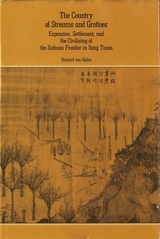 The Country of Streams and Grottoes: Expansion, Settlement, and the Civilizing of the Sichuan Frontier in Song Times
Richard von Glahn
Harvard University Press, 1987 Until the Song dynasty, the mountains and rocky gorges of Sichuan were inhabited primarily by forest peoples. Increased settlement by Han Chinese farmers from the rice-growing plains altered the landscape, changed the balance of power among tribes, and adapted Han custom to new conditions. This book describes how the remote Luzhou area of Sichuan became fully integrated into Chinese civilization.
First colonized under private auspices, the region was early dominated by tribal chiefs and local Han magnates with personal armies; but eventually state intervention increased as the military was called in to protect profitable salt wells, Han farming, and the trade routes over which timber, minerals, aromatics, and horses were carried to central markets. Richard von Glahn describes how administrative structures emerged in towns and villages. He argues that policy decisions by the central government and economic imperatives from core regions instigated and determined local development. The book thus provides detailed knowledge of a particular place and has implications for the theoretical study of frontiers.
 The Country of the Pointed Firs and Other Stories
Sarah Orne Jewett
University of New Hampshire Press, 1997 The Country of the Pointed Firs (1896) is Sarah Orne Jewett's most popular book. In its elegantly constructed sketches, a worldly, anonymous writer spends the summer in a tiny Maine fishing village where she hopes to find peace and solitude. As she gains the acceptance and trust of her hosts, the community's power and complexity are slowly revealed. While its episodes portray the difficulty and loneliness of rural life, they also display its dignity and strength, particularly as expressed in the bonds between women: mothers, daughters, and friends.
This centennial edition contains a facsimile of the original text, thereby restoring the novel to Jewett's own version, which had been considerably altered in other published versions, plus four related stories. Further enhancing the importance of this volume is editor Sarah Way Sherman's introduction, which includes a sketch of Jewett's life and professional development, a commentary on textual accuracy, and a discussion of the book's themes and techiques as well as its historical context.
Country Place: A Novel
Ann Petry, foreword by Farah Jasmine Griffin
Northwestern University Press, 1947
A 1947 novel by best-selling African American author Ann Petry, Country Place opens with a soldier returning from World War II and his effort to rescue his failing marriage.
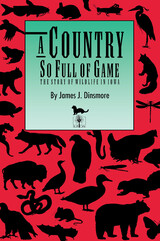 A Country So Full of Game: The Story of Wildlife in Iowa
James J. Dinsmore
University of Iowa Press, 1994 Indian agent Joseph Street said it well in 1833 when he described his trip across Iowa: “I had never rode through a country so full of game.” In the early 1800s Iowa's deep soil, free-flowing rivers and streams, and favorable climate had combined to produce the welcoming habitats that supported a surprising variety of animals. In his engaging, intelligent book, James Dinsmore has created the first comprehensive history of this abounding wildlife from the arrival of Euro-American explorers to the present day.
Based on a thorough search of hundreds of primary sources ranging from chronicles of military expeditions to field reports by early naturalists, first-person accounts by fur traders and hunters to up-to-date county checklists, A Country So Full of Game examines the dramatic encounters of humans with elk, black bears, passenger pigeons, bobcats, prairie-chickens, otters, and many more. Each chapter discusses the animal's status and distribution when explorers first arrived in Iowa, how it was hunted or trapped, how this exploitation affected its population, and what its current status is both in Iowa and nationally. Enhanced by Mark Müller's distinctive drawings, commissioned for this book, the anecdotes evoke a sense of loss and wonder at the magic abundance of Iowa's wildlife.
Iowa has been changed more than, perhaps, any other state. We can mourn the disappearance of the bison and mountain lion while we marvel at the recent success of the wild turkey and white-tailed deer. Listening to James Dinsmore tell the story of wildlife in Iowa can open a window onto the future as other areas of our planet are increasingly altered by humans. A Country So Full of Game will allow all naturalists, both amateur and professional, hunter and biologist, to appreciate and learn from Iowa's diverse wild heritage.
Country Songs for Alice
Emma Binder
Tupelo Press, 2024 An examination of obsession, gender, love, and loss in contemporary rural America.
In Country Songs for Alice, a nonbinary, queer narrator passes through the crucible of love, romance, and heartbreak against the backdrop of rural America—a landscape which offers luminous belonging, even as the hazards of homophobia, loneliness, and isolation loom large. Part roadtrip, part mixtape, these poems are explorations of love, music, romance, pageantry, loneliness, and belonging in the rural places and small towns that seem to preclude queer culture. Country Songs for Alice not only tells the story of a relationship and its dissolution but reclaims country western imagery and aesthetics for a queer audience, dousing the narrator’s experience in the language of cowboys, horses, rodeos, trucks, and desert skies.
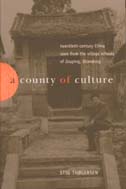 A County of Culture: Twentieth-Century China Seen from the Village Schools of Zouping, Shandong
Stig Thogersen
University of Michigan Press, 2002 A County of Culture provides a detailed analysis of education reforms in twentieth-century rural China, and of how these reforms relate to larger processes of social, political, and economic transformation. Based on documents and life histories collected in Zouping, the book focuses on education as an indicator of the changing relations between state and rural society; as a crucial feature in local economic life; and as a decisive factor in individual careers and destinies.
A County of Culture demonstrates how changes in educational policies have exerted considerable influence on social life in Zouping, from the macro level of nation building and state formation to the micro level of individual careers. It also shows that the rural population has been far from being a passive object of reform, and that it has been extremely difficult for educational reformers to achieve their goals as a result of the social, economic, and mental realities of China's villages. The fate of educational reforms has thus been decided in the tension between two poles: the visions of educational planners and reformers on the one hand, and the expectations of the rural population on the other.
Not only pertinent to specialists of Chinese education, this book will also be useful to anyone interested in state-society relations in modern China and to students of comparative education and rural development.
Stig Thøgersen is Associate Professor of Chinese Language and Society, University of Aarhus.
Coup d’État: A Practical Handbook
Edward N. Luttwak
Harvard University Press, 1979 The coup is the most frequently attempted method of changing government, and the most successful. Coup d’État outlines the mechanism of the coup and analyzes the conditions—political, military, and social, that gives rise to it. In doing so, the book sheds much light on societies where power does indeed grow out of the barrel of a gun and the role of law is a concept little understood.
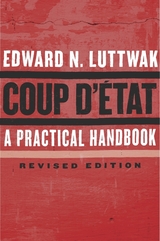 Coup d'État: A Practical Handbook, Revised Edition
Edward N. Luttwak
Harvard University Press, 2016 Coup d’État astonished readers when it first appeared in 1968 because it showed, step by step, how governments could be overthrown. Translated into sixteen languages, it has inspired anti-coup precautions by regimes around the world. In addition to these detailed instructions, Edward Luttwak’s revised handbook offers an altogether new way of looking at political power—one that considers, for example, the vulnerability to coups of even the most stable democracies in the event of prolonged economic distress.
The world has changed dramatically in the past half century, but not the essence of the coup d’état. It still requires the secret recruitment of military officers who command the loyalty of units well placed to seize important headquarters and key hubs in the capital city. The support of the armed forces as a whole is needed only in the aftermath, to avoid countercoups. And mass support is largely irrelevant, although passive acceptance is essential. To ensure it, violence must be kept to a minimum. The ideal coup is swift and bloodless. Very violent coups rarely succeed, and if they trigger a bloody civil war they fail utterly.
Luttwak identifies conditions that make countries vulnerable to a coup, and he outlines the necessary stages of planning, from recruitment of coconspirators to postcoup promises of progress and stability. But much more broadly, his investigation of coups—updated for the twenty-first century—uncovers important truths about the nature of political power.
 Coup: The Day the Democrats Ousted Their Governor, Put Republican Lamar Alexander in Office Early, and Stopped a Pardon Scandal
Keel Hunt
Vanderbilt University Press, 2017 Coup is the behind-the-scenes story of an abrupt political transition, unprecedented in US history. Based on 163 interviews, Hunt describes how collaborators came together from opposite sides of the political aisle and, in an extraordinary few hours, reached agreement that the corruption and madness of the sitting Governor of Tennessee, Ray Blanton, must be stopped. The sudden transfer of power that caught Blanton unawares was deemed necessary because of what one FBI agent called "the state's most heinous political crime in half a century"—a scheme of selling pardons for cash.
On January 17, 1979, driven by new information that some of the worst criminals in the state's penitentiaries were about to be released (and fears that James Earl Ray might be one of them), a small bipartisan group chose to take charge. Senior Democratic leaders, friends of the sitting governor, together with the Republican governor-elect Lamar Alexander (now US Senator from Tennessee), agreed to oust Blanton from office before another night fell. It was a maneuver unique in American political history.
Expanded edition, with a newly discovered account of the events by Senator Lamar Alexander:
"In December 2015 something unexpected happened. Keel [Hunt] delivered to my Nashville office a brown three-ring binder. He had only recently discovered it in a box that had been in storage for thirty years." —Senator Lamar Alexander
This binder contained the forgotten typescript, written in 1985, of Alexander's recollections of the events leading up to his early inauguration on January 17, 1979. In this expanded edition of Coup, the Senator's 22,000-word text has been added as a lost footnote to Hunt's definitive account.
From the foreword by John L. Seigenthaler:
"The individual stories of those government officials involved in the coup—each account unique, but all of them intersecting—were scattered like disconnected pieces of a jigsaw puzzle on the table of history until the author conceived this book. Perhaps because it happened so quickly, and without major disagreement, protest, or dissent, this truly historic moment has been buried in the public mind. In unearthing the drama in gripping detail, Keel Hunt assures that the 'dark day' will be remembered as a bright one in which conflicted politicians came together in the public interest."
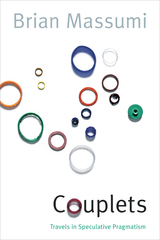 Couplets: Travels in Speculative Pragmatism
Brian Massumi
Duke University Press, 2021 In Couplets, Brian Massumi presents twenty-four essays that represent the full spectrum of his work during the past thirty years. Conceived as a companion volume to Parables for the Virtual, Couplets addresses the key concepts of Parables from different angles and contextualizes them, allowing their stakes to be more fully felt. Rather than organizing the essays chronologically or by topic, Massumi pairs them into couplets to encourage readers to make connections across conventional subject matter categories, to encounter disjunctions, and to link different phases in the evolution of his work. In his analyses of topics ranging from art, affect, and architecture to media theory, political theory, and the philosophy of experience, Massumi charts a field on which a family of conceptual problems plays out in ways that bear on the potentials for acting and perceiving the world. As an essential guide to Massumi's oeuvre, Couplets is both a primer for his new readers and a supplemental resource for those already engaged with his thought.
Couplings
Peter Schneider
University of Chicago Press, 1998 Eduard Hoffman is a microbiologist with an interest in relationships. He believes he's found "a strain of separation virus" raging in West Berlin in 1983, which terminates every relationship within three years, 167 days, and 2 hours. As Eduard attempts to evade the virus, he tangles with Germany's Nazi guilt, memories of his father, a wayward mouse, and other threats to his identity in a divided country.
"A little Don Giovanni, a little café sociology, a little laboratory science, a little Berlin wit—it's a pleasant mix."—Suzanne Ruta, New York Times Book Review
"With its poignant valedictory to its protagonists' waning youth and its rueful placing of them in the firing line of history, Couplings achieves a balance of light and dark that is utterly persuasive."—Michael Upchurch, San Francisco Chronicle Book Review
 Courage
Barbara Darling-Smith
University of Notre Dame Press, 2002 This timely book brings together ten scholars in the varied fields of philosophy, theology, history, anthropology, and literature to reflect on the theme of courage. Contributors to this volume agree that courage is not just for the few or the dramatically heroic. While some of the authors do invoke awe-inspiring instances of death-defying courage, all recognize that courage is required of every one of us.
The first section of Courage, entitled "Courage in Philosophy and Literature," begins with William Desmond's exploration of the transcendent dimension of courage, which comes to us not from within ourselves but from beyond ourselves. Leroy Rouner's essay utilizes Paul Tillich's interpretation of faith as courage in The Courage to Be and then goes on to suggest that original sin be understood in today's terms as ontological loneliness. Remi Brague, following Nietzsche, finds that the virtue called for in modern times is intellectual honesty--the courage to face the truth. Geoffrey Hill's essay looks at depictions of courage in the writings of Shakespeare and his immediate predecessors. Philip Ivanhoe suggests that Aristotle's understanding of courage can be deepened by the writings of the Confucian thinker Mengzi (Mencius), who insisted that "great courage"--courage directed toward morally praiseworthy ends--is the result of a continuing process of self-cultivation.
The second section, "Courage in War, Peace, and Nation Building," includes John Taylor's study of courage in wartime, which focuses particularly on Robert E. Lee and his courage. Daniel Berrigan's piece, on the other hand, finds in the famous Isaiah text "And they will hammer their swords into plowshares" a summons to peace making. Lucius Outlaw calls for courage from each of us in constructing a multiracial, multiethnic democracy with "justice for all."
"Courage Every Day" is the theme of the final section. Robert Neville illuminates the many varieties of courage called for each day of our lives, including the courage to dare, the courage of self-identity, the courage to love, and the courage to be alone. Katherine Platt concludes these explorations of courage with the hope-inspiring suggestion that courage is a habit we can practice.
BARBARA DARLING-SMITH is assistant professor of religion at Wheaton College in Norton, Massachusetts and former assistant director of the Boston University Institute for Philosophy and Religion. She is the editor of Can Virtue Be Taught?, also published by the University of Notre Dame Press.
----------
"Courage is always in short supply---especially among intellectuals. This fine collection of essays challenges us to examine our souls and to try to live life with the joyful daring that makes it worthwhile. It is excellent reading and may do us some much-needed good." --John Lachs, Centennial Professor of Philosophy, Vanderbilt University
"Deftly edited by Barbara Darling-Smith Courage showcases a truly impressive selection of contributions by a variety of learned and scholarly authors writing about the conceptual and emotional virtue of ‘courage.' Courage is an inherently fascinating read and a highly recommended addition to personal reading lists, as well as academic and community library collections." --The Midwest Book Review, June 2002
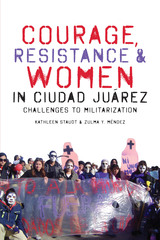 Courage, Resistance, and Women in Ciudad Juárez: Challenges to Militarization
By Kathleen Staudt and Zulma Y. Méndez
University of Texas Press, 2015 Ciudad Juárez has recently become infamous for its murder rate, which topped 3,000 in 2010 as competing drug cartels grew increasingly violent and the military responded with violence as well. Despite the atmosphere of intimidation by troops, police, and organized criminals, women have led the way in civil society activism, spurring the Juárez Resistance and forging powerful alliances with anti-militarization activists. An in-depth examination of la Resistencia Juarense, Courage, Resistance, and Women in Ciudad Juárez draws on ethnographic research to analyze the resistance’s focus on violence against women, as well as its clash with the war against drugs championed by Mexican President Felipe Calderón with the support of the United States. Through grounded insights, the authors trace the transformation of hidden discourses into public discourses that openly challenge the militarized border regimes. The authors also explore the advocacy carried on by social media, faith-based organizations, and peace-and-justice activist Javier Sicilia while Calderón faced U.S. political schisms over the role of border trade in this global manufacturing site. Bringing to light on-the-ground strategies as well as current theories from the fields of sociology, political anthropology, and human rights, this illuminating study is particularly significant because of its emphasis on the role of women in local and transnational attempts to extinguish a hot zone. As they overcome intimidation to become game-changing activists, the figures featured in Courage, Resistance, and Women in Ciudad Juárez offer the possibility of peace and justice in the wake of seemingly irreconcilable conflict.
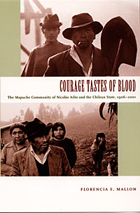 Courage Tastes of Blood: The Mapuche Community of Nicolás Ailío and the Chilean State, 1906-2001
Florencia E. Mallon
Duke University Press, 2005 Until now, very little about the recent history of the Mapuche, Chile’s largest indigenous group, has been available to English-language readers. Courage Tastes of Blood helps to rectify this situation. It tells the story of one Mapuche community—Nicolás Ailío, located in the south of the country—across the entire twentieth century, from its founding in the resettlement process that followed the military defeat of the Mapuche by the Chilean state at the end of the nineteenth century. Florencia E. Mallon places oral histories gathered from community members over an extended period of time in the 1990s in dialogue with one another and with her research in national and regional archives. Taking seriously the often quite divergent subjectivities and political visions of the community’s members, Mallon presents an innovative historical narrative, one that reflects a mutual collaboration between herself and the residents of Nicolás Ailío. Mallon recounts the land usurpation Nicolás Ailío endured in the first decades of the twentieth century and the community’s ongoing struggle for restitution. Facing extreme poverty and inspired by the agrarian mobilizations of the 1960s, some community members participated in the agrarian reform under the government of socialist president Salvador Allende. With the military coup of 1973, they suffered repression and desperate impoverishment. Out of this turbulent period the Mapuche revitalization movement was born. What began as an effort to protest the privatization of community lands under the military dictatorship evolved into a broad movement for cultural and political recognition that continues to the present day. By providing the historical and local context for the emergence of the Mapuche revitalization movement, Courage Tastes of Blood offers a distinctive perspective on the evolution of Chilean democracy and its rupture with the military coup of 1973.
 Courage: The Politics of Life and Limb
Richard Avramenko
University of Notre Dame Press, 2011
Courage: The Politics of Life and Limb is a compelling and highly original study of the paradox of courage. Richard Avramenko contends that courage is not simply one virtue among many; rather, it is the primary means for humans to raise themselves out of their individualistic, isolated, and materialistic existence. As such, courage is an absolute and permanent good for collective human life. Specifically, Avramenko argues that when we risk "life and limb" for one another we reveal a fundamental care that binds our community together. Paradoxically, the same courage that brings humans together also drives us apart because courage is traditionally understood as manly, by definition, exclusionary, inegalitarian, and violent.
Avramenko explores the efforts of political thinkers throughout history—such as Aristophanes, Plato, Aristotle, Rousseau, and Tocqueville—to reformulate courage so as to hold fast to all that is good about it while jettisoning that which is problematic. In addition to martial courage, the book looks at political courage, moral courage, and economic courage. Courage: The Politics of Life and Limb makes a vital contribution to the discipline of political science. Clearly and engagingly written, the book will be of particular interest to students and scholars of political theory, ethics, and gender studies.
"In his ambitious book, Richard Avramenko has given us a profound and rigorous treatment of four important phases in the self-understanding of courage. Avramenko has done much more than provide a snapshot of the 'red badge of courage'; he has taken courage as a prism within which the history of political thought can be viewed. As a consequence, he has also shown how courage is more than a one-dimensional invocation, but a many-faceted virtue whose meaning remains inexhaustible. He has mapped the terrain with a mastery that will be difficult to surpass." —David John Walsh, The Catholic University of America
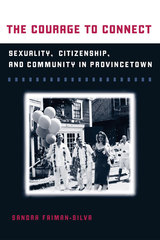 The Courage to Connect: Sexuality, Citizenship, and Community in Provincetown
Sandra L. Faiman-Silva
University of Illinois Press, 2003 Based on over six years of fieldwork, Sandra L. Faiman-Silva's The Courage to Connect traces the transformation of the Cape Cod community of Provincetown from its nineteenth-century origins as a fishing town where Portuguese immigrants settled to its present status as a welcoming, sexually diverse tourist enclave. Faiman-Silva examines the community’s history and economy as well as how gay and straight cultures intersect in areas such as public education, local government, and law enforcement. Using queer and critical culture theory to deconstruct day-to-day local encounters, Faiman-Silva describes the causes of social conflicts and how these conflicts can be resolved. Capturing the pathos and joy of a community that has struggled to accommodate radical social changes, The Courage to Connect yields understanding of the ways in which communities can construct themselves to overcome differences.
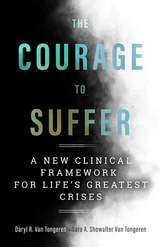 The Courage to Suffer: A New Clinical Framework for Life's Greatest Crises
Daryl R. Van Tongeren
Templeton Press, 2020 Suffering is an inescapable part of life. Some suffering is so profound, so violating, or so dogged that it fundamentally changes people in indelible ways. Many existing therapeutic approaches, from a medical model, treat suffering as mental illness and seek a curative solution. However, such approaches often fail to examine the deep questions that suffering elicits (e.g., existential themes of death, isolation, freedom, identity, and meaninglessness) and the far-reaching ways in which suffering affects the lived experience of each individual. In The Courage to Suffer, Daryl and Sara Van Tongeren introduce a new therapeutic framework that helps people flourish in the midst of suffering by cultivating meaning. Drawing from scientific research, clinical examples, existential and positive psychology, and their own personal stories of loss and sorrow, Daryl and Sara’s integrative model blends the rich depth of existential clinical approaches with the growth focus of strengths-based approaches.Through cutting edge-research and clinical case examples, they detail five “phases of suffering” and how to work with a client's existential concerns at each phase to develop meaning. They also discuss how current research suggests to build a flourishing life, especially for those who have endured, and are enduring, suffering. Daryl and Sara show how those afflicted with suffering, while acknowledging the reality of their pain, can still choose to live with hope.
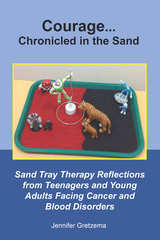 Courage...Chronicled in the Sand: Sand Tray Therapy Reflections from Teenagers and Young Adults Facing Cancer and Blood Disorders
Jennifer Gretzema
Michigan Publishing, 2017 It is often difficult for young people facing an illness to verbalize their personal thoughts and feelings. In the Child and Family Life department, at The University of Michigan C.S. Mott Children’s Hospital, sand tray therapy is used to help this vulnerable population communicate with their healthcare team, families, and loved ones. Sand tray therapy is a window into the thoughts, feelings, and coping styles of youth struggling with life-altering illnesses and hospitalizations. It helps them process their past and present medical experiences, set goals, and teach others about their needs.
The sand trays and stories in this book were created by patients and families living with Cancer and Blood Disorders. Their expressions, created in the sand and conveyed through the written word, provide insight into their world. Sand tray therapy provides a sacred space to process experiences using symbols instead of language.
This collection of photos and personal stories was compiled so that other patients, their families, and their friends can share the authors’ journeys.
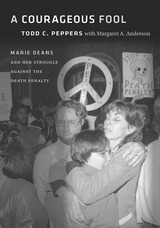 A Courageous Fool: Marie Deans and Her Struggle against the Death Penalty
Todd C. Peppers
Vanderbilt University Press, 2017 There have been many heroes and victims in the battle to abolish the death penalty, and Marie Deans fits into both of those categories. A South Carolina native who yearned to be a fiction writer, Marie was thrust by a combination of circumstances--including the murder of her beloved mother-in-law--into a world much stranger than fiction, a world in which minorities and the poor were selected to be sacrificed to what Supreme Court Justice Harry Blackmun called the "machinery of death."
Marie found herself fighting to bring justice to the legal process and to bring humanity not only to prisoners on death row but to the guards and wardens as well. During Marie's time as a death penalty opponent in South Carolina and Virginia, she experienced the highs of helping exonerate the innocent and the lows of standing death watch in the death house with thirty-four condemned men.
 Courbet's Realism
Michael Fried
University of Chicago Press, 1990 "'This book,' Michael Fried's work opens, 'was written not so much chapter by chapter as painting by painting over a span of roughly ten years.' Courbet's Realism is a magnificent work and its very first sentence brings us up against the qualities of mind of its author, qualities that make it as impressive as it is. It allows us to reconstruct the keen eye, the commitment to perception, the gift of rapt concentration, the conviction that great paintings are not necessarily understood easily, and the further conviction that a great painter deserves to get from us as good as he gives. By drawing on these qualities, Fried achieves something out of reach for all but a handful of his colleagues. In his writing, art history takes on some of the character of art itself. It is driven by the same stubborn resolve to open our eyes."—Richard Wollheim, San Francisco Review of Books
Courbet's Realism is clearly a major contribution to the highly active field of Courbet studies. . . . But to contribute here and now is necessarily also to contribute to central debates about art history itself, and so the book is also—I hesitate to say 'more importantly,' because of the way object and method are woven together in it—a major contribution to current attempts to rethink the foundations and objects of art history. . . . It will not be an easy book to come to terms with; for all its engagement with contemporary literary theory and related developments, it is not an application of anything, and its deeply thought-through arguments will not fall easily in line with the emerging shapes of the various 'new art histories' that tap many of the same theoretical resources. At this moment, there may be nothing more valuable than such a work."—Stephen Melville, Art History
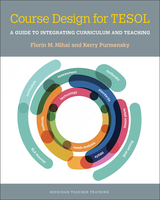 Course Design for TESOL: A Guide to Integrating Curriculum and Teaching
Florin M. Mihai and Kerry Purmensky
University of Michigan Press, 2016 Course Design for TESOL offers a unique approach of integrating curriculum with teaching activities to allow language educators to utilize the text in a variety of courses in a TESOL program. Although the authors assume readers have a basic knowledge of English grammar, this textbook/resource is designed to be comprehensible to those who have not had an SLA or Applied Linguistics course. Because each language skill is discussed in detail in terms of important theories and concepts and actual teaching activities are included, the book can also be used in a Methods course or a combined Curriculum Design–Methods (or Methods and Materials) course.
Part I explores the basic language acquisition theories and their influences on current teaching practices in the field. Part II then moves on to the core elements of designing a curriculum or course: conducting the needs analysis, setting of course goals/objectives, designing the syllabus, and writing lesson plans.
Part III: Instructional Activities and Assessment Techniques features chapters on the teaching of listening, speaking, reading, writing, grammar, and culture. Within each of these chapters, the authors address the fundamental issues related to the teaching of each skill and then discuss the components of a good activity for that skill (and how to design one), and then offer four sample activities (one for each type of syllabus) and guidance on assessing that skill. The activities can be adapted for use in a variety of classrooms and settings.
Part IV addresses contemporary trends—curriculum issues in North America and Europe (standards and educational policy), practices in teaching in Asia (particularly China and Korea), and technology-enhanced learning.
 A Course in Econometrics
Arthur S. Goldberger
Harvard University Press, 1991 This text prepares first-year graduate students and advanced undergraduates for empirical research in economics, and also equips them for specialization in econometric theory, business, and sociology.
A Course in Econometrics is likely to be the text most thoroughly attuned to the needs of your students. Derived from the course taught by Arthur S. Goldberger at the University of Wisconsin–Madison and at Stanford University, it is specifically designed for use over two semesters, offers students the most thorough grounding in introductory statistical inference, and offers a substantial amount of interpretive material. The text brims with insights, strikes a balance between rigor and intuition, and provokes students to form their own critical opinions.
A Course in Econometrics thoroughly covers the fundamentals—classical regression and simultaneous equations—and offers clear and logical explorations of asymptotic theory and nonlinear regression. To accommodate students with various levels of preparation, the text opens with a thorough review of statistical concepts and methods, then proceeds to the regression model and its variants. Bold subheadings introduce and highlight key concepts throughout each chapter.
Each chapter concludes with a set of exercises specifically designed to reinforce and extend the material covered. Many of the exercises include real microdata analyses, and all are ideally suited to use as homework and test questions.
A Course in Romance Linguistics: A Diachronic View, vol. 2
Frederick B. Agard
Georgetown University Press Agard provides an historical comparison of the major Romance languages with a reconstruction of their common source and a chronological account of their development through changes and splits.
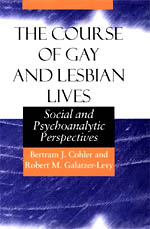 The Course of Gay and Lesbian Lives: Social and Psychoanalytic Perspectives
Bertram J. Cohler and Robert M. Galatzer-Levy
University of Chicago Press, 2000 We live in a society obsessed with tracing the cause of homosexuality. Is there a gene that can be identified? Or do the origins lie outside of biology in the cultural context of childhood or adolescence? Most importantly, should we care about any of these questions?
Drawing on their own work with gays, lesbians, and bisexuals as well as other pertinent studies, psychoanalysts Bertram J. Cohler and Robert Galatzer-Levy have written a groundbreaking work that examines how psychological development and clinical intervention as well as social and historical change across generations contribute to how we think about sexuality. The authors argue that there is little support for assuming that homosexuality has a biological basis. Recognizing the many pathways that lead to same-gender sexual orientation, the authors conclude that the cause is much less important than understanding the meaning of being homosexual. They consider the destructive nature of an intolerant society that fosters so-called conversion psychotherapy and stress the importance of helping to rebuild a sense of coherence and personal integrity among homosexuals.
 The Course of Recognition
Paul Ricoeur
Harvard University Press, 2005 Recognition, though it figures profoundly in our understanding of objects and persons, identity and ideas, has never before been the subject of a single, sustained philosophical inquiry. This work, by one of contemporary philosophy’s most distinguished voices, pursues recognition through its various philosophical guises and meanings—and, through the “course of recognition,” seeks to develop nothing less than a proper hermeneutics of mutual recognition.
Originally delivered as lectures at the Institute for the Human Sciences at Vienna, the essays collected here consider recognition in three of its forms. The first chapter, focusing on knowledge of objects, points to the role of recognition in modern epistemology; the second, concerned with what might be called the recognition of responsibility, traces the understanding of agency and moral responsibility from the ancients up to the present day; and the third takes up the problem of recognition and identity, which extends from Hegel’s discussion of the struggle for recognition through contemporary arguments about identity and multiculturalism. Throughout, Paul Ricoeur probes the significance of our capacity to recognize people and objects, and of self-recognition and self-identity in relation to the gift of mutual recognition. Drawing inspiration from such literary texts as the Odyssey and Oedipus at Colonus, and engaging some of the classic writings of the Continental philosophical tradition—by Kant, Hobbes, Hegel, Augustine, Locke, and Bergson—The Course of Recognition ranges over vast expanses of time and subject matter and in the process suggests a number of highly insightful ways of thinking through the major questions of modern philosophy.
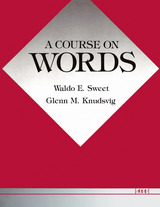 A Course on Words
Waldo E. Sweet and Glenn M. Knudsvig
University of Michigan Press, 1989 A great many students enter an etymology course with only one goal -- to learn new words with the hope that they will be more successful in classwork, in standardized exams, or in a variety of work-related situations. In A Course on Words students will indeed learn new words, but, more important, they will gain an understanding of how words are built and how they can use this information to analyze new words that they will encounter outside the classroom. They will spend most of the time learning elements of words that will enable them to determine the meanings of many new words in the future. As one student put it, this book seems to "sensitize us to words and get us to think about words."
The book is unusual in that it offers both programmed and nonprogrammed material. Each type of material is designed to provide students with the maximum amount of involvement and practice. The students do not simply read definitions of words, as is the case with some courses. Rather, they engage in many different activities; not only defining words but analyzing and building them, and learning to use context to derive meaning. The programmed approach enables students to do the work on their own and receive immediate checks of their answers. Classroom time, therefore, is free for review, reinforcement of programmed activities, work on the nonprogrammed material, and attention to the needs of individual students. The book also includes at the end a set of Supplementary Exercises for each unit. The nonprogrammed materials include "Review Exercises," "Words of Interesting Origin," "Easily Confused Words," and "Latin Phrases." These provide practice in concepts learned in the unit and an opportunity to explore a wide variety of topics, such as eponymous words and the literal meanings of Latin expressions used in English.
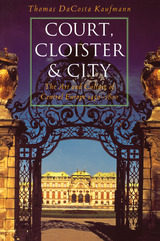 Court, Cloister, and City: The Art and Culture of Central Europe, 1450-1800
Thomas DaCosta Kaufmann
University of Chicago Press, 1995 The collapse of Communism in Central and Eastern Europe opened the doors to cultural treasures that for decades had been hidden, forgotten, or misinterpreted. Thomas DaCosta Kaufmann looks at Central Europe as a cultural entity while chronicling more than three hundred years of painting, sculpture, and architecture in Germany, Poland, the Czech Republic, Slovakia, Hungary, Austria, Ukraine, Lithuania and western parts of the Russian Federation. Kaufmann surveys a remarkable range of art and artifacts created from the coming of the Renaissance through to the Enlightenment.
"Kaufmann throws considerable light on one of the more neglected and least understood periods in art history."—Philadelphia Inquirer
"A wonderful book which does justice both to a formal analysis of the art and to an explanation of broader political and economic forces at work."—Virginia Quarterly Review
"Important and stimulating, Kaufmann's study examines the cultural legacy of a region too little known and understood."—Choice
"Peaks of the creative heritage which [Kaufmann] describes reserve their message—and their surprises—for those who visit them in situ. But invest in Kaufmann's volume before you go."—R. J. W. Evans, New York Review of Books
The Court Midwife
Justine Siegemund
University of Chicago Press, 2005 First published in 1690, The Court Midwife made Justine Siegemund (1636-1705) the spokesperson for the art of midwifery at a time when most obstetrical texts were written by men. More than a technical manual, The Court Midwife contains descriptions of obstetric techniques of midwifery and its attendant social pressures. Siegemund's visibility as a writer, midwife, and proponent of an incipient professionalism accorded her a status virtually unknown to German women in the seventeenth century. Translated here into English for the first time, The Court Midwife contains riveting birthing scenes, sworn testimonials by former patients, and a brief autobiography.
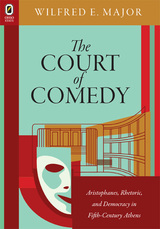 The Court of Comedy
Wilfred E. Major
Ohio State University Press, 2013 The Court of Comedy: Aristophanes, Rhetoric, and Democracy in Fifth-Century Athens, by Wilfred E. Major, analyzes how writers of comedy in Classical Greece satirized the emerging art of rhetoric and its role in political life. In the fifth century BCE, the development of rhetoric proceeded hand in hand with the growth of democracy both on Sicily and at Athens. In turn, comic playwrights in Athens, most notably Aristophanes, lampooned oratory as part of their commentary on the successes and failures of the young democracy. This innovative study is the first book to survey all the surviving comedy from the fifth century BCE on these important topics. The evidence reveals that Greek comedy provides a revealing commentary on the incipient craft of rhetoric before its formal conventions were stabilized. Furthermore, Aristophanes’ depiction of rhetoric and of Athenian democratic institutions indicates that he fundamentally supports the Athenian democracy and not, as is often argued, oligarchic opposition to it. These conclusions confirm recent work that reinterprets the early development of rhetoric in Classical Greece and offer fresh perspectives on the debate over the role of comedy in early Greek democracy. Throughout, Major capitalizes on recent progress in understanding of the performance dynamics of Classical Greek theater.
 Court of Last Resort: Mental Illness and the Law
Carol A. B. Warren
University of Chicago Press, 1982 The Court of Last Resort looks at decision making in a mental-health court and at the dilemmas of treating mental illness while protecting patients' legal rights. Carol Warren spent seven years studying hearings in a large California court where people who had been involuntarily committed to institutions for psychiatric treatment could petition for their release. In this book she confronts questions of whether mental illness is real or only a label for societal control, whether the government should be involved in committing the deviant to institutions, and how the interaction of judges, psychiatrists, families, police, and other individuals and agencies affect the court's administration of mental-health law. Though the cases in this book fall under California's Lanterman-Petris-Short Act, Warren's analysis of conflicts between legal and medical models of behavior is of national and international importance both to sociologists and to the many professionals who work at the juncture of mental health and the law.
 Court of Remorse: Inside the International Criminal Tribunal for Rwanda
Thierry Cruvellier
University of Wisconsin Press, 2010 When genocidal violence gripped Rwanda in 1994, the international community recoiled, hastily withdrawing its peacekeepers. Late that year, in an effort to redeem itself, the United Nations Security Council created the International Criminal Tribunal for Rwanda to seek accountability for some of the worst atrocities since World War II: the genocide suffered by the Tutsi and crimes against humanity suffered by the Hutu. But faced with competing claims, the prosecution focused exclusively on the crimes of Hutu extremists. No charges would be brought against the Tutsi-led Rwandan Patriotic Front, which ultimately won control of the country. The UN, as if racked by guilt for its past inaction, gave in to pressure by Rwanda’s new leadership. With the Hutu effectively silenced, and the RPF constantly reminding the international community of its failure to protect the Tutsi during the war, the Tribunal pursued an unusual form of one-sided justice, born out of contrition.
Fascinated by the Tribunal’s rich complexities, journalist Thierry Cruvellier came back day after day to watch the proceedings, spending more time there than any other outside observer. Gradually he gained the confidence of the victims, defendants, lawyers, and judges. Drawing on interviews with these protagonists and his close observations of their interactions, Cruvellier takes readers inside the courtroom to witness the motivations, mechanisms, and manipulations of justice as it unfolded on the stage of high-stakes, global politics. It is this ground-level view that makes his account so valuable—and so absorbing. A must-read for those who want to understand the dynamics of international criminal tribunals, Court of Remorse reveals both the possibilities and the challenges of prosecuting human rights violations. A Choice Outstanding Academic Book Best Books for General Audiences, selected by the American Association for School Libraries and the Public Library Association Best Books for High Schools, selected by the American Association for School Libraries
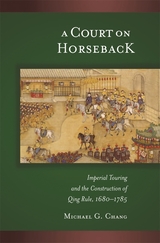 A Court on Horseback: Imperial Touring and the Construction of Qing Rule, 1680–1785
Michael G. Chang
Harvard University Press, 2007 Between 1751 and 1784, the Qianlong emperor embarked upon six southern tours, traveling from Beijing to Jiangnan and back. These tours were exercises in political theater that took the Manchu emperor through one of the Qing empire's most prosperous regions.
This study elucidates the tensions and the constant negotiations characterizing the relationship between the imperial center and Jiangnan, which straddled the two key provinces of Jiangsu and Zhejiang. Politically, economically, and culturally, Jiangnan was the undisputed center of the Han Chinese world; it also remained a bastion of Ming loyalism and anti-Manchu sentiment. How did the Qing court constitute its authority and legitimate its domination over this pivotal region? What were the precise terms and historical dynamics of Qing rule over China proper during the long eighteenth century?
In the course of addressing such questions, this study also explores the political culture within and through which High Qing rule was constituted and contested by a range of actors, all of whom operated within socially and historically structured contexts. The author argues that the southern tours occupied a central place in the historical formation of Qing rule during a period of momentous change affecting all strata of the eighteenth-century polity.
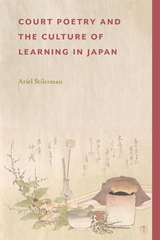 Court Poetry and the Culture of Learning in Japan
Ariel Stilerman
Harvard University Press, 2026 Once the exclusive domain of the aristocracy, classical Japanese poetry (waka) underwent a remarkable transformation in the medieval period, becoming a dynamic tool for cultural education embraced by warriors, monks, merchants, and commoners alike. Ariel Stilerman investigates this evolution in Court Poetry and the Culture of Learning in Japan by examining not only poetic treatises but also overlooked genres—encyclopedias, professional manuals, Buddhist essays, literary primers, didactic fiction, and popular tales.
As new audiences turned to waka and its playful counterpart, kyōka, in pursuit of salvation, career advancement, love, or adventure, poetry became a bridge between emerging social identities and the elite traditions of the aristocracy. Stilerman concludes that even as waka declined at the turn of the twentieth century, the tea ceremony rose to take its place—preserving and reinterpreting its role as the embodiment of Japanese tradition.
Offering a fresh and far-reaching perspective, this book illuminates poetry’s enduring influence—not just as an art form, but as a vital thread woven through the fabric of Japan’s cultural history.
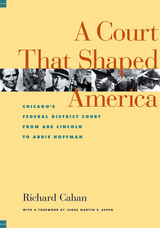 A Court That Shaped America: Chicago's Federal District Court from Abe Lincoln to Abbie Hoffman
Richard Cahan
Northwestern University Press, 2002 Big and small dramas play out every day in the United States District Court for the Northern District of Illinois. Headquartered in Chicago, the court has played a pivotal role in U.S. history. This is where Abraham Lincoln, as a young lawyer, changed the direction of westward expansion when he argued that trains-not steamships-were America's future. This is where Al Capone met his fall, at a trial that finished him as Public Enemy Number One. And this is where Abbie Hoffman, the nation's first Yippie, butted heads with Judge Julius J. Hoffman and the Establishment at the trial known as the Conspiracy Eight.
A Court That Shaped America traces the flesh-and-blood courtroom scenes from the district's first cases in the early nineteenth century through the turn of the millennium. Historical figures—including Mormon leader Joseph Smith, inventor Thomas Edison, and author Mark Twain—as well as contemporary superstars like Michael Jackson and Oprah Winfrey have all had their day in the Northern Illinois court. Some were victorious; some came out scathed. This book examines these great trials and the people behind them to offer a unique look at Chicago and U.S. history.
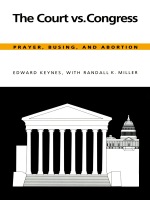 The Court vs. Congress: Prayer, Busing, and Abortion
Edward Keynes and Randall Miller
Duke University Press, 1989 Since the early 1960s the Supreme Court and its congressional critics have been locked in a continuing dispute over the issues of school prayer, busing, and abortion. Although for years the Court’s congressional foes have introduced legislation designed to curb the powers of the federal courts in these areas, they have until now failed to enact such proposals. It is likely that these legislative efforts and the present confrontation with the Court will continue.
Edward Keynes and Randall Miller argue that Congress lacks the constitutional power to legislate away the powers of the federal courts and to prevent individuals from seeking redress for presumed infringements of their constitutional rights in these areas. They demonstrate that neither the framers nor ratifiers of the Constitution intended the Congress to exercise plenary power over the appellate jurisdiction of the Supreme Court. Throughout its history the Court has never conceded unlimited powers to Congress; and until the late 1950s Congress had not attempted to gerrymander the Court’s jurisdiction in response to specific decisions. But the authors contend this is just what the sponsors of recent legislative attacks on the Court intend, and they see such efforts as threatening the Court’s independence and authority as defined in the separation of powers clauses of the Constitution.
The Courteous Power: Japan and Southeast Asia in the Indo-Pacific Era
John D. Ciorciari and Kiyoteru Tsutsui, editors
University of Michigan Press, 2021 The Courteous Power seeks to provide a nuanced view of the current relationship between Japan and Southeast Asia. Much of the current scholarship on East–Southeast Asian engagement has focused on the multidimensional chess game playing out between China and Japan, as the dominant post-imperialist powers. Alternatively, there has been renewed attention on ASEAN and other Southeast Asian–centered initiatives, explicitly minimizing the influence of East Asia in the region. Given the urgency of understanding the careful balance in the Indo-Pacific region, this volume brings together scholars to examine the history and current engagement from a variety of perspectives, ranging from economic and political, to the cultural and technological, while also focusing more clearly on the specific relationship between the region and Japan.
Courtesans and Fishcakes: The Consuming Passions of Classical Athens
James N. Davidson
University of Chicago Press, 2011 As any reader of the Symposium knows, the ancient Greek philosopher Socrates conversed over lavish banquets, kept watch on who was eating too much fish, and imbibed liberally without ever getting drunk. In other words, James Davidson writes, he reflected the culture of ancient Greece in which he lived, a culture of passions and pleasures, of food, drink, and sex before—and in concert with—politics and principles. Athenians, the richest and most powerful of the Greeks, were as skilled at consuming as their playwrights were at devising tragedies. Weaving together Greek texts, critical theory, and witty anecdotes, this compelling and accessible study teaches the reader a great deal, not only about the banquets and temptations of ancient Athens, but also about how to read Greek comedy and history.
 Courtesans, Concubines, and the Cult of Female Fidelity
Beverly Bossler
Harvard University Press, 2012 This book traces changing gender relations in China from the tenth to fourteenth centuries by examining three critical categories of women: courtesans, concubines, and faithful wives. It shows how the intersection and mutual influence of these groups—and of male discourses about them—transformed ideas about family relations and the proper roles of men and women.
Courtesan culture had a profound effect on Song social and family life, as entertainment skills became a defining feature of a new model of concubinage, and as entertainer-concubines increasingly became mothers of literati sons. Neo-Confucianism, the new moral learning of the Song, was significantly shaped by this entertainment culture and by the new markets—in women—that it created. Responding to a broad social consensus, Neo-Confucians called for enhanced recognition of concubine mothers in ritual and expressed increasing concern about wifely jealousy. The book also details the surprising origins of the Late Imperial cult of fidelity, showing that from inception, the drive to celebrate female loyalty was rooted in a complex amalgam of political, social, and moral agendas. By taking women—and men’s relationships with women—seriously, this book makes a case for the centrality of gender relations in the social, political, and intellectual life of the Song and Yuan dynasties.
 The Courtesan's Memory, Voice, and Late Ming Drama
Peng Xu
University of Michigan Press, 2025 Peng Xu’s The Courtesan’s Memory, Voice, and Late Ming Drama argues that courtesans of the era played an active role in the theater and their impact manifested in Chinese literary history, albeit concealed or erased. In the late Ming dynasty (1368–1644), theater was dominated by male performers with professional actresses largely absent from the stage, unlike in the Yuan dynasty (1271–1368), where women performed without restriction in theater troupes. Despite the prevailing assumption that women played no part in the theatrical movement, The Courtesan’s Memory, Voice, and Late Ming Drama illuminates how courtesans, as serious theater artists and playwrights, left a significant mark on the male-dominated dramatic and literary landscapes.
This study profoundly remaps the textbook narratives of gender bias, challenges modern prejudices prevalent in the literary history of Chinese drama, and reveals how theatrical conditions and writing styles shifted to accommodate courtesan performances. Utilizing a wide range of sources such as scripts, city guides, biographies, diaries, letters, wood-block illustrations, and paintings, this study distinguishes itself from earlier studies of Chinese courtesans by not thematizing courtesans for their allegorical values, but rather pinpointing their agency in shaping the features of Chinese theater and recognizing courtesans as a source of creativity and development in the medium. Xu’s focus on courtesan performance culture allows for fresh readings of canonical Chinese plays, opening up new ways of understanding the history of Chinese drama written by women, thus deviating from standard historiography based solely on the writings of men.
The Courtesy
Alan Shapiro
University of Chicago Press, 1983 In this, his first book, Alan Shapiro vividly recreates some of the more memorable and poignant moments from his Jewish-American childhood, and in the process reveals his compassionate interest in the forgotten, the alienated, and the infirm. The Courtesy is an intelligent, reflective examination of the poet's own psychological history.
"The Courtesy is really an admirable book: it shows up the unreality of a lot of the other poetry one reads, dealing honestly and with that perversity which is a sign of thoughfulness, with the slight but heavy matter of our everyday defeats."—Michael Hoffman, Poetry Nation Review
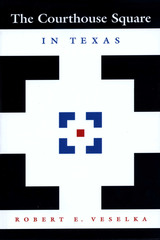 The Courthouse Square in Texas
By Robert E. Veselka
University of Texas Press, 2000 With its dignified courthouse set among shade trees and lawns dotted with monuments to prominent citizens and fallen veterans, the courthouse square remains the civic center in a majority of the county seats of Texas. Yet the squares themselves vary in form and layout, reflecting the different town-planning traditions that settlers brought from Europe, Mexico, and the United States. In fact, one way to trace settlement patterns and ethnic dispersion in Texas is by mapping the different types of courthouse squares. This book offers the first complete inventory of Texas courthouse squares, drawn from extensive archival research and site visits to 139 of the 254 county seats. Robert Veselka classifies every existing plan by type and origin, including patterns and variants not previously identified. He also explores the social and symbolic functions of these plans as he discusses the historical and modern uses of the squares. He draws interesting new conclusions about why the courthouse square remains the hub of commercial and civic activity in the smaller county seats, when it has lost its prominence in others.
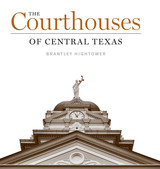 The Courthouses of Central Texas
By Brantley Hightower
University of Texas Press, 2015 The county courthouse has long held a central place on the Texas landscape—literally, as the center of the town in which it is located, and figuratively, as the symbol of governmental authority. As a county’s most important public building, the courthouse makes an architectural statement about a community’s prosperity and aspirations—or the lack of them. Thus, a study of county courthouses tells a compelling story about how society’s relationships with public buildings and government have radically changed over the course of time, as well as how architectural tastes have evolved through the decades. A first of its kind, The Courthouses of Central Texas offers an in-depth, comparative architectural survey of fifty county courthouses, which serve as a representative sample of larger trends at play throughout the rest of the state. Each courthouse is represented by a description, with information about date(s) of construction and architects, along with a historical photograph, a site plan of its orientation and courthouse square, and two- and sometimes three-dimensional drawings of its facade with modifications over time. Side-by-side drawings and plans also facilitate comparisons between courthouses. These consistently scaled and formatted architectural drawings, which Brantley Hightower spent years creating, allow for direct comparisons in ways never before possible. He also explains the courthouses’ formal development by placing them in their historical and social context, which illuminates the power and importance of these structures in the history of Texas, as well as their enduring relevance today.
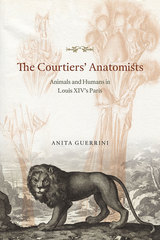 The Courtiers' Anatomists: Animals and Humans in Louis XIV's Paris
Anita Guerrini
University of Chicago Press, 2015 The Courtiers' Anatomists is about dead bodies and live animals in Louis XIV's Paris--and the surprising links between them. Examining the practice of seventeenth-century anatomy, Anita Guerrini reveals how anatomy and natural history were connected through animal dissection and vivisection. Driven by an insatiable curiosity, Parisian scientists, with the support of the king, dissected hundreds of animals from the royal menageries and the streets of Paris. Guerrini is the first to tell the story of Joseph-Guichard Duverney, who performed violent, riot-inducing dissections of both animal and human bodies before the king at Versailles and in front of hundreds of spectators at the King's Garden in Paris. At the Paris Academy of Sciences, meanwhile, Claude Perrault, with the help of Duverney’s dissections, edited two folios in the 1670s filled with lavish illustrations by court artists of exotic royal animals.
Through the stories of Duverney and Perrault, as well as those of Marin Cureau de la Chambre, Jean Pecquet, and Louis Gayant, The Courtiers' Anatomists explores the relationships between empiricism and theory, human and animal, as well as the origins of the natural history museum and the relationship between science and other cultural activities, including art, music, and literature.
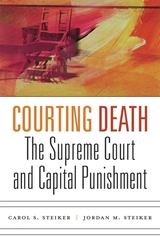 Courting Death: The Supreme Court and Capital Punishment
Carol S. Steiker and Jordan M. Steiker
Harvard University Press, 2016 Unique among Western democracies in refusing to eradicate the death penalty, the United States has attempted instead to reform and rationalize state death penalty practices through federal constitutional law. Courting Death traces the unusual and distinctive history of top-down judicial regulation of capital punishment under the Constitution and its unanticipated consequences for our time.
In the 1960s and 1970s, in the face of widespread abolition of the death penalty around the world, provisions for capital punishment that had long fallen under the purview of the states were challenged in federal courts. The U.S. Supreme Court intervened in two landmark decisions, first by constitutionally invalidating the death penalty in Furman v. Georgia (1972) on the grounds that it was capricious and discriminatory, followed four years later by restoring it in Gregg v. Georgia (1976). Since then, by neither retaining capital punishment in unfettered form nor abolishing it outright, the Supreme Court has created a complex regulatory apparatus that has brought executions in many states to a halt, while also failing to address the problems that led the Court to intervene in the first place.
While execution chambers remain active in several states, constitutional regulation has contributed to the death penalty’s new fragility. In the next decade or two, Carol Steiker and Jordan Steiker argue, the fate of the American death penalty is likely to be sealed by this failed judicial experiment. Courting Death illuminates both the promise and pitfalls of constitutional regulation of contentious social issues.
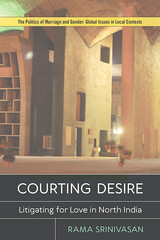 Courting Desire: Litigating for Love in North India
Rama Srinivasan
Rutgers University Press, 2020 Inquiries into marital patterns can serve as an effective lens to analyze social structures and material cultures not only on the question of sexuality, but also on the nature of a private citizen’s engagement with state and law. Through ethnographic research in courtrooms, community,and kinship spaces, the author outlines the transformations in material culture and political economy that have led to renewed negotiations on the institution of marriage in North India, especially in legal spaces. Tracing organically evolving notions of sexual consent and legal subjectivity, Courting Desire underlines how non-normative decisions regarding marriage become possible in a region otherwise known for high instances of honor killings and rigid kinship structures. Aspirations for consensual relationships have led to a tentative attempt to forge relationships that are non-normative but grudgingly approved after state intervention. The book traces this nascent and under-explored trend in the North Indian landscape.
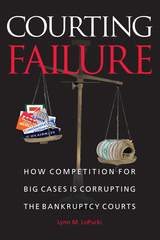 Courting Failure: How Competition for Big Cases Is Corrupting the Bankruptcy Courts
Lynn Lopucki
University of Michigan Press, 2006 LoPucki's provocative critique of Chapter 11 is required reading for everyone who cares about bankruptcy reform. This empirical account of large Chapter 11 cases will trigger intense debate both inside the academy and on the floor of Congress. Confronting LoPucki's controversial thesis-that competition between bankruptcy judges is corrupting them-is the most pressing challenge now facing any defender of the status quo."
-Douglas Baird, University of Chicago Law School
"This book is smart, shocking and funny. This story has everything-professional greed, wrecked companies, and embarrassed judges. Insiders are already buzzing."
-Elizabeth Warren, Leo Gottlieb Professor of Law, Harvard Law School
"LoPucki provides a scathing attack on reorganization practice. Courting Failure recounts how lawyers, managers and judges have transformed Chapter 11. It uses empirical data to explore how the interests of the various participants have combined to create a system markedly different from the one envisioned by Congress. LoPucki not only questions the wisdom of these changes but also the free market ideology that supports much of the general regulation of the corporate sector."
-Robert Rasmussen, University of Chicago Law School
A sobering chronicle of our broken bankruptcy-court system, Courting Failure exposes yet another American institution corrupted by greed, avarice, and the thirst for power.
Lynn LoPucki's eye-opening account of the widespread and systematic decay of America's bankruptcy courts is a blockbuster story that has yet to be reported in the media. LoPucki reveals the profound corruption in the U.S. bankruptcy system and how this breakdown has directly led to the major corporate failures of the last decade, including Enron, MCI, WorldCom, and Global Crossing.
LoPucki, one of the nation's leading experts on bankruptcy law, offers a clear and compelling picture of the destructive power of "forum shopping," in which corporations choose courts that offer the most favorable outcome for bankruptcy litigation. The courts, lured by big money and prestige, streamline their requirements and lower their standards to compete for these lucrative cases. The result has been a series of increasingly shoddy reorganizations of major American corporations, proposed by greedy corporate executives and authorized by case-hungry judges.
 Courting History: A Supreme Court Historian Reflects on His Life and Career
James F. Simon
University of Texas Press, 2025 A Supreme Court historian’s memoir places court events in the larger context of American history. Legal scholar James F. Simon has written many acclaimed books on the history of the US Supreme Court, but in this memoir, he turns his attention to a more personal subject: himself. Simon, a native of Fort Worth, details what it was like growing up in segregated Texas. He left home for college and law school at Yale, interspersed with travels abroad to build a schoolhouse in Ghana, work at an Israeli kibbutz, and spend a year on a fellowship in India. Simon worked as a legal journalist for Time magazine before embarking on a career as a Supreme Court historian. He later was appointed professor of constitutional law and served as dean of New York Law School. Meanwhile, he continued his work on what became his specialty, well-researched books on the history of the Supreme Court that place events at the court in the larger context of American history. Much of this research is included in his papers, which are now housed at the Briscoe Center for American History. In this engaging memoir, Simon describes the challenges of interviewing Supreme Court justices and researching constitutional history for his books and juggling his law school and family responsibilities, all the while reflecting on changing American perspectives on civil rights and liberties.
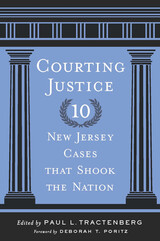 Courting Justice: Ten New Jersey Cases That Shook the Nation
Edited by Paul L. Tractenberg with a Foreword by Deborah T. Poritz
Rutgers University Press, 2013 Since 1947 a modernized New Jersey Supreme Court has played an important and controversial role in the state, nation, and world. Its decisions in cutting-edge cases have confronted society’s toughest issues, reflecting changing social attitudes, modern life’s complexities, and new technologies.
Paul Tractenberg has selected ten of the court’s landmark decisions between 1960 and 2011 to illustrate its extensive involvement in major public issues, and to assess its impact. Each case chapter is authored by a distinguished academic or professional expert, several of whom were deeply involved in the cases’ litigation, enabling them to provide special insights. An overview chapter provides context for the court’s distinctive activity.
Many of the cases are so widely known that they have become part of the national conversation about law and policy. In the Karen Ann Quinlan decision, the court determined the right of privacy extends to refusing life-sustaining treatment. The Baby M case reined in surrogate parenting and focused on the child’s best interests. In the Mount Laurel decision, the court sought to increase affordable housing for low- and moderate-income residents throughout the state. The Megan’s Law case upheld legal regulation of sex offender community notification. A series of decisions known as Abbott/Robinson required the state to fund poor urban school districts at least on par with suburban districts.
Other less well known cases still have great public importance. Henningsen v. Bloomfield Motors reshaped product liability and tort law to protect consumers injured by defective cars; State v. Hunt shielded privacy rights from unwarranted searches beyond federal standards; Lehmann v. Toys ‘R’ Us protected employees from sexual harassment and a hostile work environment; Right to Choose v. Byrne expanded state constitutional abortion rights beyond the federal constitution; and Marini v. Ireland protected low-income tenants against removal from their homes.
For some observers, the New Jersey Supreme Court represents the worst of judicial activism; others laud it for being, in its words, “the designated last-resort guarantor of the Constitution's command.” For Tractenberg, the court’s activism means it tends to find for the less powerful over the more powerful and for the public good against private interests, an approach he applauds.
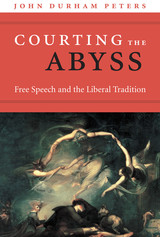 Courting the Abyss: Free Speech and the Liberal Tradition
John Durham Peters
University of Chicago Press, 2005 Courting the Abyss updates the philosophy of free expression for a world that is very different from the one in which it originated. The notion that a free society should allow Klansmen, neo-Nazis, sundry extremists, and pornographers to spread their doctrines as freely as everyone else has come increasingly under fire. At the same time, in the wake of 9/11, the Right and the Left continue to wage war over the utility of an absolute vision of free speech in a time of increased national security. Courting the Abyss revisits the tangled history of free speech, finding resolutions to these debates hidden at the very roots of the liberal tradition.
A mesmerizing account of the role of public communication in the Anglo-American world, Courting the Abyss shows that liberty's earliest advocates recognized its fraternal relationship with wickedness and evil. While we understand freedom of expression to mean "anything goes," John Durham Peters asks why its advocates so often celebrate a sojourn in hell and the overcoming of suffering. He directs us to such well-known sources as the prose and poetry of John Milton and the political and philosophical theory of John Locke, Adam Smith, John Stuart Mill, and Oliver Wendell Holmes Jr., as well as lesser-known sources such as the theology of Paul of Tarsus. In various ways they all, he shows, envisioned an attitude of self-mastery or self-transcendence as a response to the inevitable dangers of free speech, a troubled legacy that continues to inform ruling norms about knowledge, ethical responsibility, and democracy today.
A world of gigabytes, undiminished religious passion, and relentless scientific discovery calls for a fresh account of liberty that recognizes its risk and its splendor. Instead of celebrating noxious doctrine as proof of society's robustness, Courting the Abyss invites us to rethink public communication today by looking more deeply into the unfathomable mystery of liberty and evil.
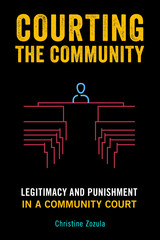 Courting the Community: Legitimacy and Punishment in a Community Court
Christine Zozula
Temple University Press, 2019 Community Courts are designed to handle a city’s low-level offenses and quality-of-life crimes, such as littering, loitering, or public drunkenness. Court advocates maintain that these largely victimless crimes jeopardize the well-being of residents, businesses, and visitors. Whereas traditional courts might dismiss such cases or administer a small fine, community courts aim to meaningfully punish offenders to avoid disorder escalating to apocalyptic decline. Courting the Community is a fascinating ethnography that goes behind the scenes to explore how quality-of-life discourses are translated into court practices that marry therapeutic and rehabilitative ideas. Christine Zozula shows how residents and businesses participate in meting out justice—such as through community service, treatment, or other sanctions—making it more emotional, less detached, and more legitimate in the eyes of stakeholders. She also examines both “impact panels,” in which offenders, residents, and business owners meet to discuss how quality-of-life crimes negatively impact the neighborhood, as well as strategic neighborhood outreach efforts to update residents on cases and gauge their concerns. Zozula’s nuanced investigation of community courts can lead us to a deeper understanding of punishment and rehabilitation and, by extension, the current state of the American court system.
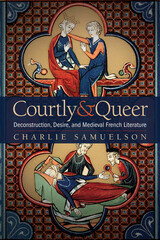 Courtly and Queer: Deconstruction, Desire, and Medieval French Literature
Charlie Samuelson
Ohio State University Press, 2022 In Courtly and Queer, Charlie Samuelson casts queerness in medieval French texts about courtly love in a new light by bringing together for the first time two exemplary genres: high medieval verse romance, associated with the towering figure of Chrétien de Troyes, and late medieval dits, primarily associated with Guillaume de Machaut. In close readings informed by deconstruction and queer theory, Samuelson argues that the genres’ juxtaposition opens up radical new perspectives on the deviant poetics and gender and sexual politics of both. Contrary to a critical tradition that locates the queer Middle Ages at the margins of these courtly genres, Courtly and Queer emphasizes an unflagging queerness that is inseparable from poetic indeterminacy and that inhabits the core of a literary tradition usually assumed to be conservative and patriarchal. Ultimately, Courtly and Queer contends that one facet of texts commonly referred to as their “courtliness”—namely, their literary sophistication—powerfully overlaps with modern conceptions of queerness.
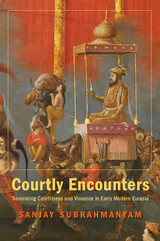 Courtly Encounters: Translating Courtliness and Violence in Early Modern Eurasia
Sanjay Subrahmanyam
Harvard University Press, 2012 Cross-cultural encounters in Europe and Asia in the sixteenth and seventeenth centuries brought the potential for bafflement, hostility, and admiration. The court was the crucial site where expanding Eurasian states and empires met and were forced to make sense of one another. By looking at these interactions, Courtly Encounters provides a fresh cross-cultural perspective on the worlds of early modern Islam, Counter-Reformation Catholicism, Protestantism, and a newly emergent Hindu sphere.
Both individual agents and objects such as texts and paintings helped mediate encounters between courts, which possessed rules and conventions that required decipherment and translation, whether in words or in pictures. Sanjay Subrahmanyam gives special attention to the depiction of South Asian empires in European visual representations, finding a complex history of cultural exchange: the Mughal paintings that influenced Rembrandt and other seventeenth-century Dutch painters had themselves been earlier influenced by Dutch naturalism. Courtly Encounters provides a rich array of images from Europe, the Islamic world, India, and Southeast Asia as aids for understanding the reciprocal nature of cross-cultural exchanges. It also looks closely at how insults and strategic use of martyrdom figured in courtly encounters.
As he sifts through the historical record, Subrahmanyam finds little evidence for the cultural incommensurability many ethnohistorians have insisted on. Most often, he discovers negotiated ways of understanding one another that led to mutual improvisation, borrowing, and eventually change.
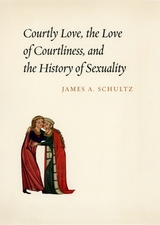 Courtly Love, the Love of Courtliness, and the History of Sexuality
James A. Schultz
University of Chicago Press, 2006 One of the great achievements of the Middle Ages, Europe’s courtly culture gave the world the tournament, the festival, the knighting ceremony, and also courtly love. But courtly love has strangely been ignored by historians of sexuality. With Courtly Love, the Love of Courtliness, and the History of Sexuality, James Schultz corrects this oversight with careful analysis of key courtly texts of the medieval German literary tradition.
Courtly love, Schultz finds, was provoked not by the biological and intrinsic factors that play such a large role in our contemporary thinking about sexuality—sex difference or desire—but by extrinsic signs of class: bodies that were visibly noble and behaviors that represented exemplary courtliness. Individuals became “subjects” of courtly love only to the extent that their love took the shape of certain courtly roles such as singer, lady, or knight. They hoped not only for physical union but also for the social distinction that comes from realizing these roles to perfection. To an extraordinary extent, courtly love represented the love of courtliness—the eroticization of noble status and the courtly culture that celebrated noble power and refinement
 Courtly Riddles: Enigmatic Embellishments in Early Persian Poetry
Asghar Seyed-Gohrab
Leiden University Press, 2010 This is the first study of Persian literary riddles to appear in English, analyzing a wide range of complex riddling poems systematically from the tenth to the twelfth century. In addition to the genre of riddles, the book examines the relationship between metaphors and riddles and the genre of literary description.
Literary riddles occur in the early specimens of Persian literature from the tenth century and they continue to be used in modern Iranian society.
What is it that it has neither trousers nor shirt?
[Yet] you can place on her lap whatever you wish
Although she has no tongue, she speaks the truth,
With a dragon, a scorpion upon her neck.
a scale (quppân)
‘Courtly Riddles demonstrates how the taste for riddles lies at the core of the development of Persian poetry. It proposes a careful, learned and systematic analysis of this hitherto little-studied and puzzling poetical game.’
Christine van Ruymbeke, University of Cambridge
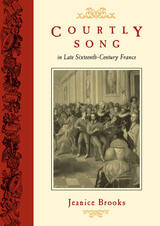 Courtly Song in Late Sixteenth-Century France
Jeanice Brooks
University of Chicago Press, 2001 In the late sixteenth century, the French royal court was mobile. To distinguish itself from the rest of society, it depended more on its cultural practices and attitudes than on the royal and aristocratic palaces it inhabited. Using courtly song-or the air de cour-as a window, Jeanice Brooks offers an unprecedented look into the culture of this itinerant institution.
Brooks concentrates on a period in which the court's importance in projecting the symbolic centrality of monarchy was growing rapidly and considers the role of the air in defining patronage hierarchies at court and in enhancing courtly visions of masculine and feminine virtue. Her study illuminates the court's relationship to the world beyond its own confines, represented first by Italy, then by the countryside. In addition to the 40 editions of airs de cour printed between 1559 and 1589, Brooks draws on memoirs, literary works, and iconographic evidence to present a rounded vision of French Renaissance culture.
The first book-length examination of the history of air de cour, this work also sheds important new light on a formative moment in French history.
Courts: A Comparative and Political Analysis
Martin Shapiro
University of Chicago Press, 1981 In this provocative work, Martin Shapiro proposes an original model for the study of courts, one that emphasizes the different modes of decision making and the multiple political roles that characterize the functioning of courts in different political systems.
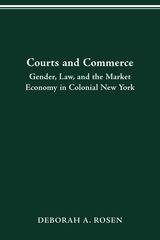 COURTS AND COMMERCE: GENDER, LAW, AND THE MARKET ECONOMY IN COLONIAL NEW YORK
Deborah A. Rosen
Ohio State University Press, 1997 In Courts and Commerce, Deborah A. Rosen intertwines economic history, legal history, and the history of gender. Relying on extensive analysis of probate inventories, tax lists, court records, letter books, petitions to the governor, and other documents from the eighteenth century—some never before studied—Rosen describes the expansion of the market economy in colonial New York and the way in which the law provided opportunities for eighteenth-century men to expand their economic networks while at the same time constraining women's opportunities to engage in market relationships. The book is unusual in its range of interests: it pays special attention to a comparison of urban and rural regions, it examines the role of law in fostering economic development, and it contrasts the different experiences of men and women as the economy changed. Courts and Commerce challenges the idealized image of colonial America that has dominated historiography on the colonial period. In contrast to scholars who have portrayed the colonial period as a golden age for communal values and who have described nineteenth-century developments as if they had no eighteenth-century precedents, Rosen demonstrates that the traditionally described communal model of eighteenth-century America is a myth, and that in many ways the two eras are marked more by continuity than by change. Deborah Rosen demonstrates that a market economy based on arm’s-length relationships did not suddenly emerge in the nineteenth century but already existed during the eighteenth century; that women became marginalized from the economy well before industrialization sent their husbands off to factories; and that the law shaped economic development a century or more before judges began to redefine the substance of the law to protect manufacturers and railway owners against expensive lawsuits by injured employees, neighbors, and consumers.
This bold and thought-provoking work will find a welcome audience among scholars of colonial American history, economic, social, and legal history, and women's studies.
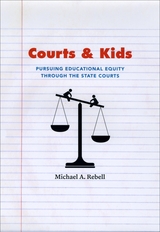 Courts and Kids: Pursuing Educational Equity through the State Courts
Michael A. Rebell
University of Chicago Press, 2009 Over the past thirty-five years, federal courts have dramatically retreated from actively promoting school desegregation. In the meantime, state courts have taken up the mantle of promoting the vision of educational equity originally articulated in Brown v. Board of Education. Courts and Kids is the first detailed analysis of why the state courts have taken on this active role and how successful their efforts have been. Since 1973, litigants have challenged the constitutionality of education finance systems in forty-five states on the grounds that they deprive many poor and minority students of adequate access to a sound education. While the plaintiffs have won in the majority of these cases, the decisions are often branded “judicial activism”—a stigma that has reduced their impact. To counter the charge, Michael A. Rebell persuasively defends the courts’ authority and responsibility to pursue the goal of educational equity. He envisions their ideal role as supervisory, and in Courts and Kids he offers innovative recommendations on how the courts can collaborate with the executive and legislative branches to create a truly democratic educational system.
|
|
